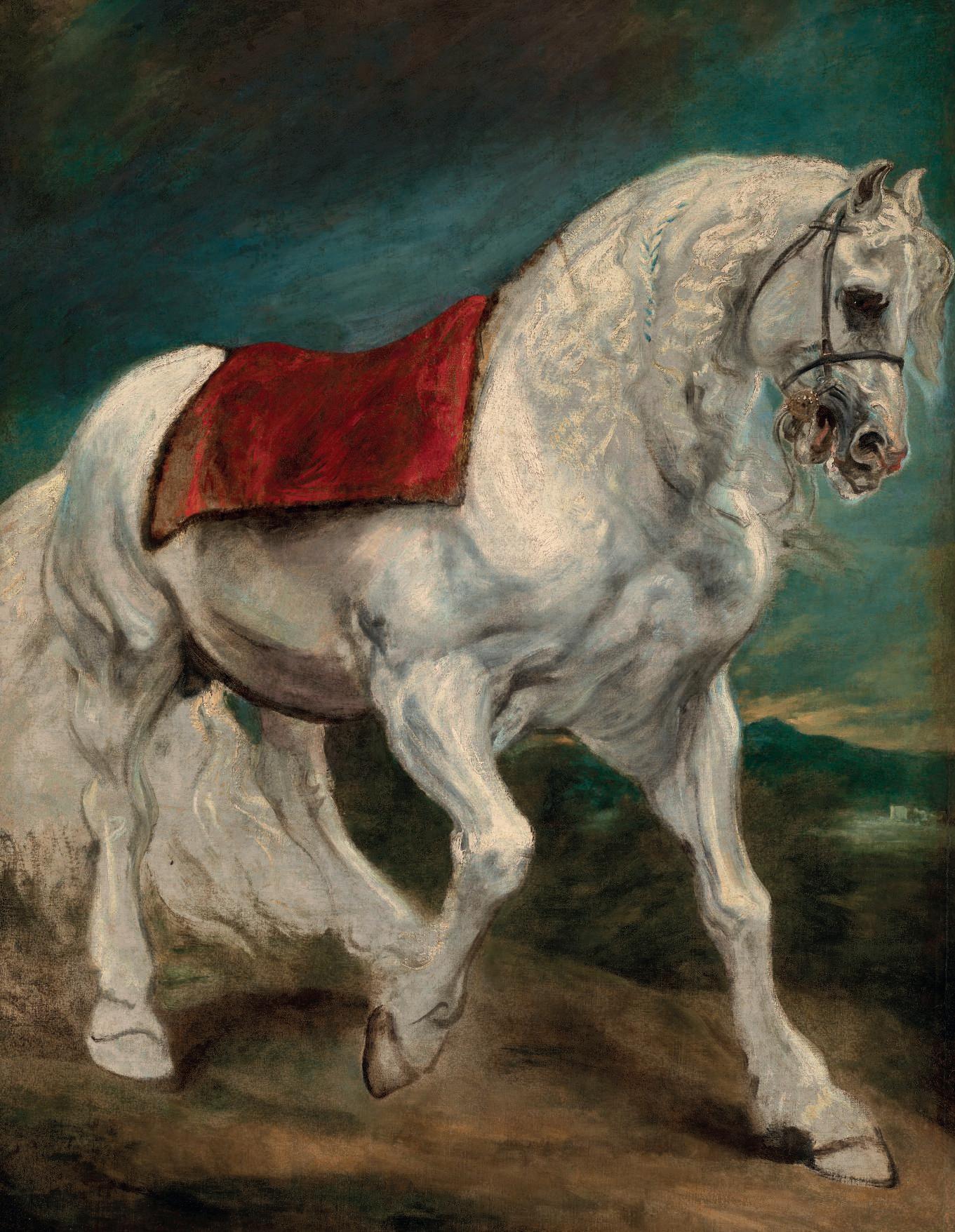
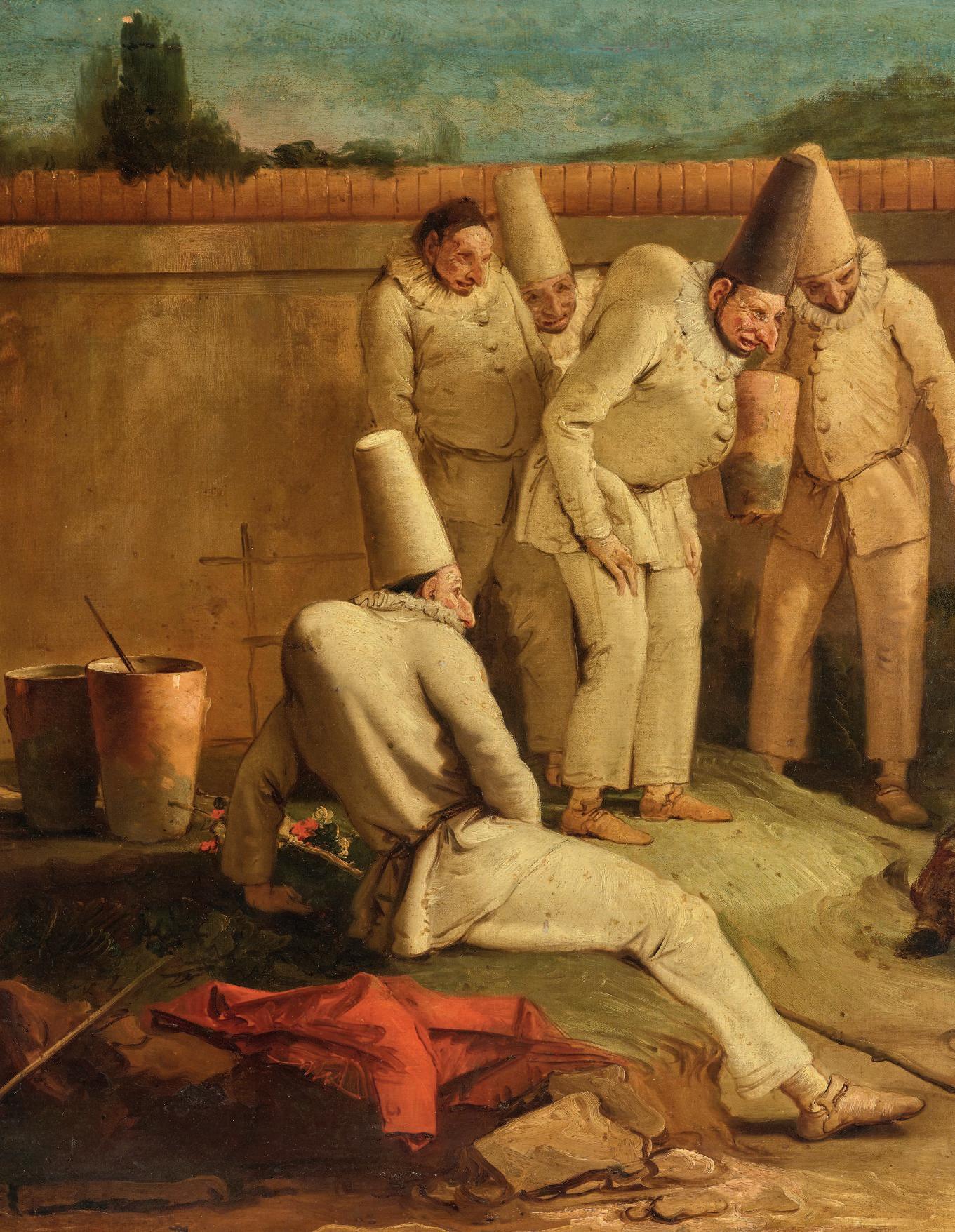
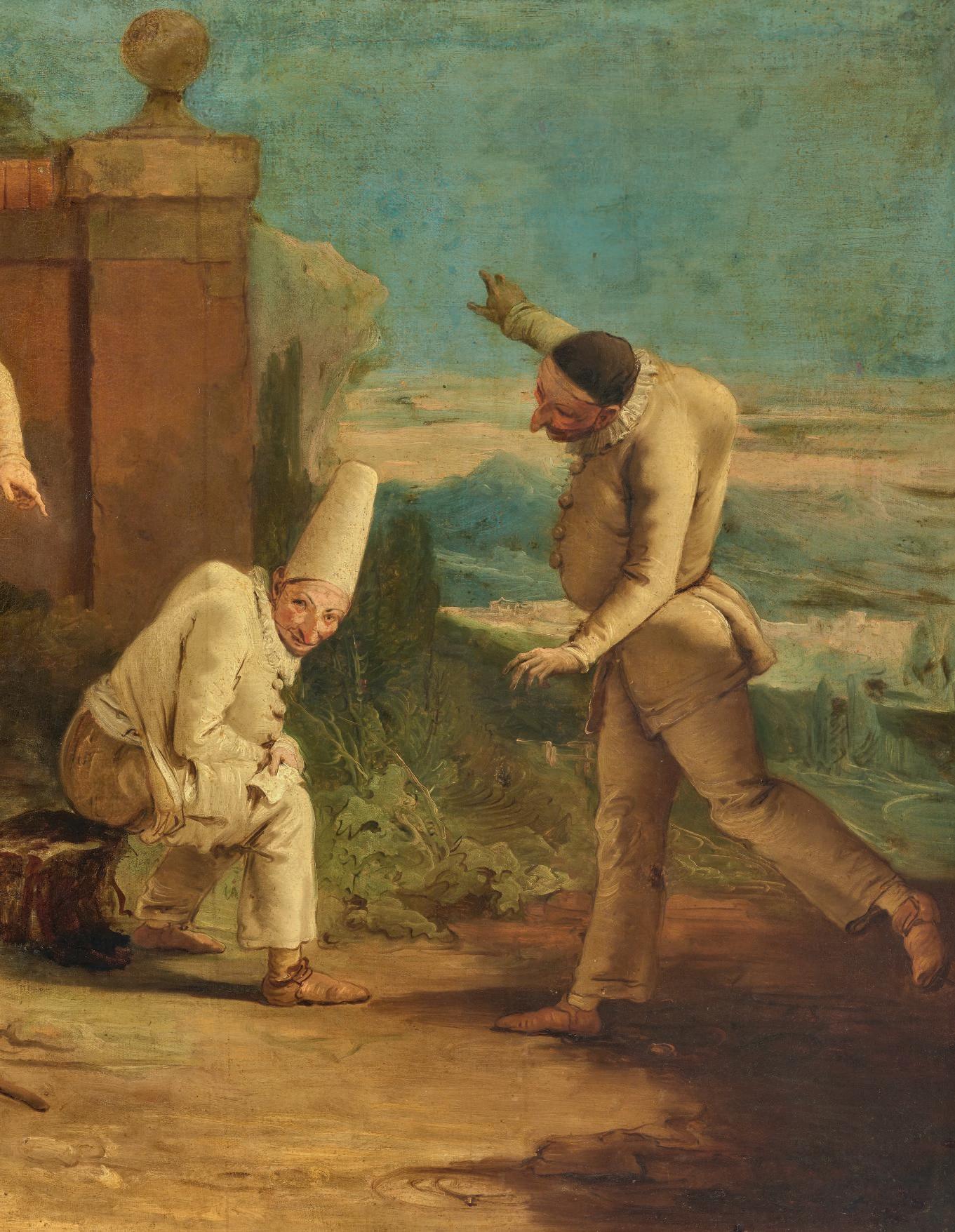
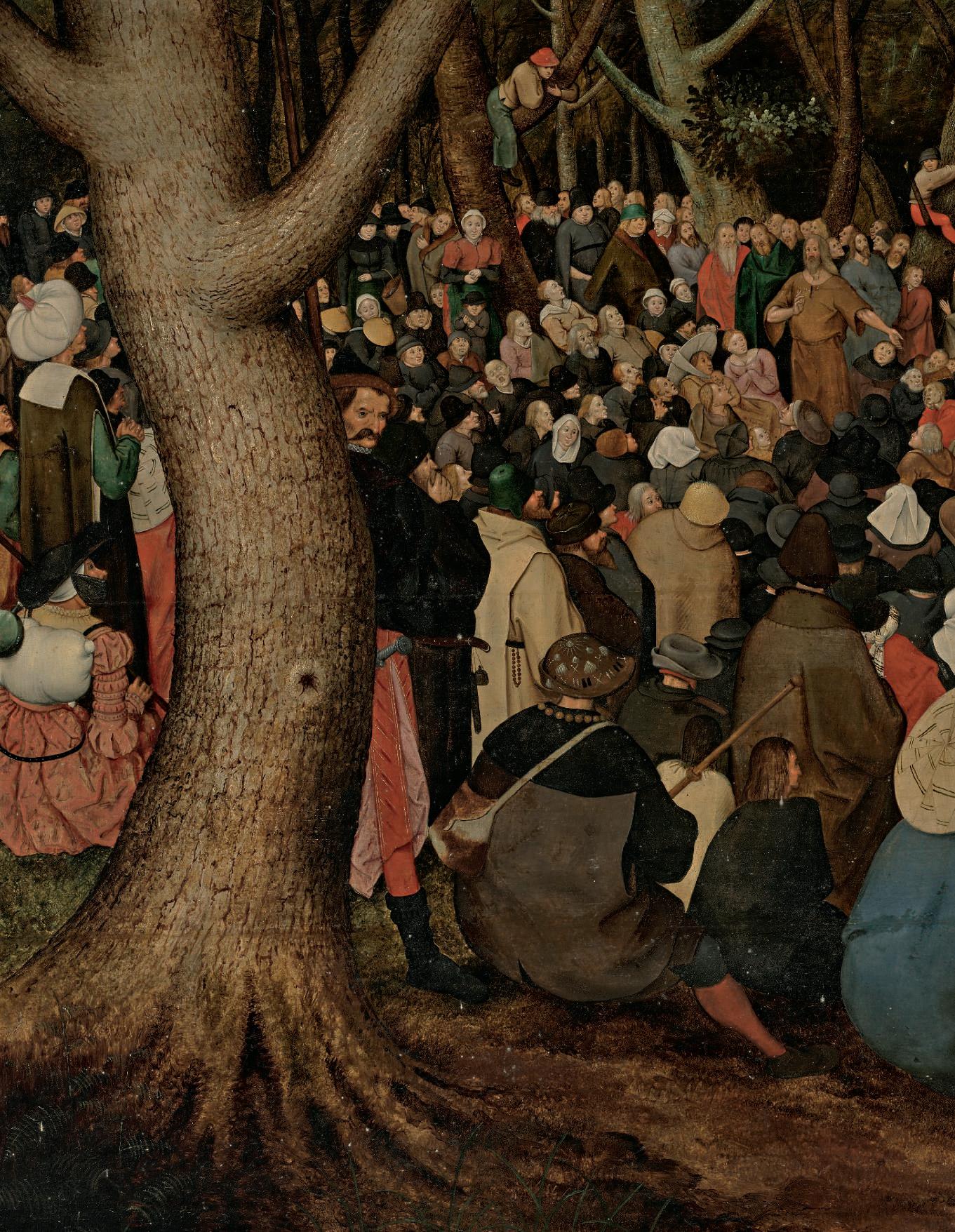
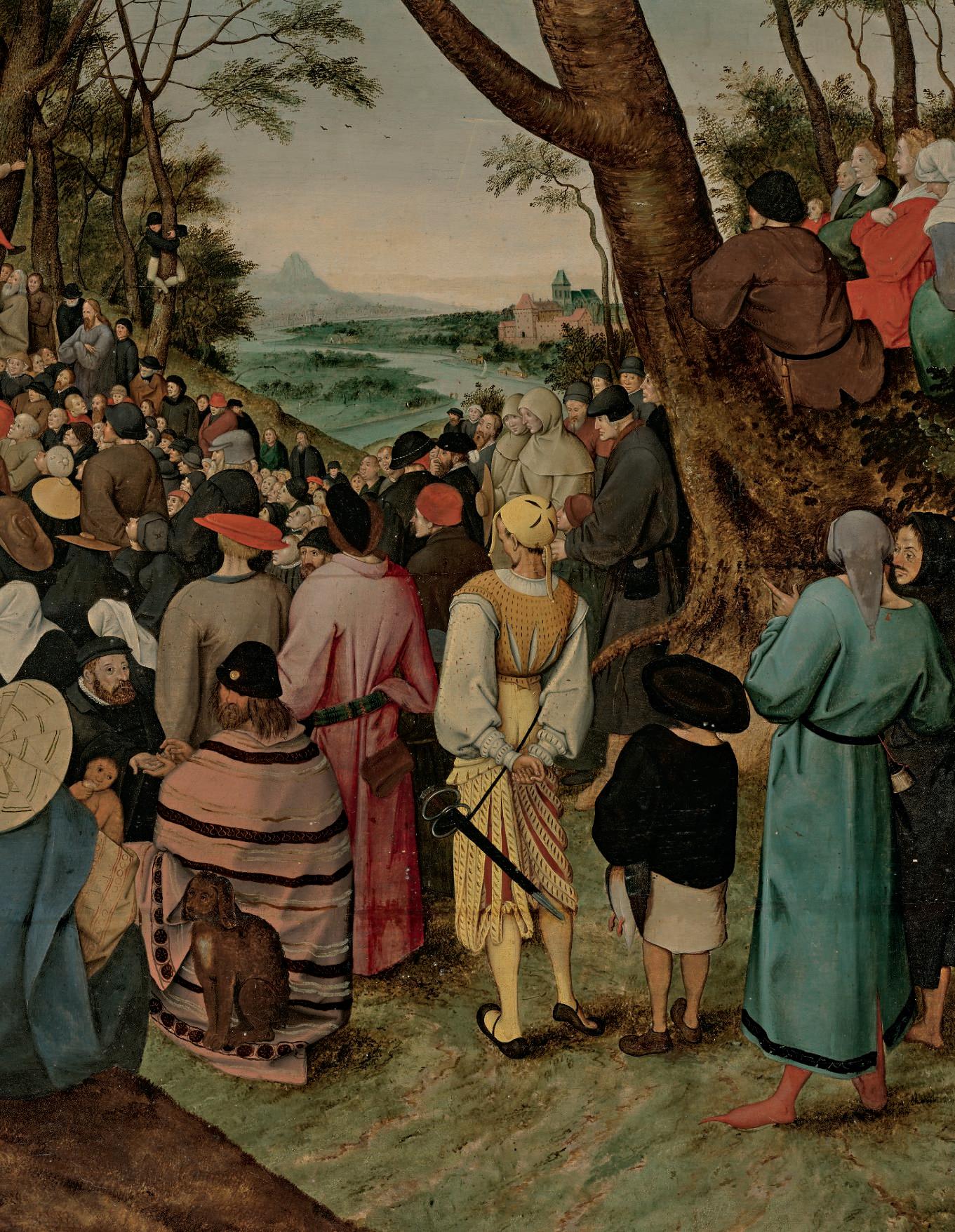

PROPERTIES FROM CARITAS OF THE ARCHDIOCESE OF







PROPERTIES FROM CARITAS OF THE ARCHDIOCESE OF
FRONT COVER
Lot 7 (detail)
INSIDE FRONT COVER
Lot 22 (detail)
PAGES 2-3
Lot 4 (detail)
OPPOSITE
Lot 25 (detail)
INDEX
Lot 20 (detail)
BACK COVER
Lot 4 (detail)
Tuesday 3 December 2024 at 6.30 pm
8 King Street, St. James’s London SW1Y 6QT
Friday 29 November 9.00 am - 5.00 pm
Saturday 30 November 12.00 pm - 5.00 pm
Sunday 1 December 12.00 pm - 5.00 pm
Monday 2 December 9.00 am - 8.00 pm
Tuesday 3 December 9.00 am - 5.00 pm
Henry Pettifer
In sending absentee bids or making enquiries, this sale should be referred to as SACHA-22691
Admission to the sale is by ticket only. To reserve tickets, please email: ticketinglondon@christies.com. Alternatively, please call Christie’s Client Service on +44 (0)20 7839 9060
Tel: +44 (0)20 7389 2658 Fax: +44 (0)20 7930 8870
The sale of each lot is subject to the Conditions of Sale, Important Notices and Explanation of Cataloguing Practice, which are set out in this catalogue and on christies.com. Please note that the symbols and cataloguing for some lots may change before the auction. For the most up to date sale information for a lot, please see the full lot description, which can be accessed through the sale landing page on christies.com.
In addition to the hammer price, a Buyer’s Premium (plus VAT) is payable. Other taxes and/or an Artist Resale Royalty fee are also payable if the lot has a tax or λ symbol.
Check Section D of the Conditions of Sale at the back of this catalogue. Estimates in a currency other than pounds sterling are approximate and for illustration purposes only.
GLOBAL HEAD, OLD MASTERS
Andrew Fletcher
Tel: +44 (0)20 7389 2344
INTERNATIONAL DEPUTY CHAIRMAN
Henry Pettifer
Tel: +44 (0)20 7389 2084
INTERNATIONAL DEPUTY CHAIRMAN, DEPUTY CHAIRMAN, UK & IRELAND
John Stainton
Tel: +44 (0)20 7389 2945
INTERNATIONAL DEPUTY CHAIRMAN
François de Poortere
Tel: +1 212 636 2469
GLOBAL HEAD OF RESEARCH & EXPERTISE
Letizia Treves
Tel: +44 (0)20 7389 5206
HEAD OF DEPARTMENT, LONDON
Clementine Sinclair
Tel: +44 (0)20 7389 2306
HEAD OF DEPARTMENT, NEW YORK
Jennifer Wright
Tel: +1 212 636 2384
HEAD OF DEPARTMENT, PARIS
Pierre Etienne
Tel: +33 (0)1 40 76 72 72
DEPUTY CHAIRMAN, UK
Francis Russell
Tel: +44 (0)20 7389 2075
HONORARY CHAIRMAN
Noël Annesley
Tel: +44 (0)20 7389 2405
WORLDWIDE SPECIALISTS
AMSTERDAM
Manja Rottink
Tel: +31 (0)20 575 52 83
BRUSSELS
Astrid Centner
Tel: +32 (0)2 512 88 30
HONG KONG
Georgina Hilton
Melody Lin
Tel: +85 22 97 86 850
LONDON
Freddie de Rougemont
John Hawley
Maja Markovic
Flavia Lefebvre D’Ovidio
Lucy Speelman
Isabella Manning
Tel: +44 (0)20 7389 2210
NEW YORK
Jonquil O’Reilly
Joshua Glazer
Oliver Rordorf
Taylor Alessio
Tel: +1 212 636 2120
MADRID
Adriana Marín Huarte
Tel: +34 915 326 627
PARIS
Olivia Ghosh
Bérénice Verdier
Victoire Terlinden
Tel: +33 (0)1 40 76 85 87
CONSULTANTS
Sandra Romito
Alan Wintermute
GLOBAL MANAGING DIRECTOR
Imogen Giambrone
Tel: +44 (0)20 7389 2009
PRIVATE SALES
Alexandra Baker
International Business Director
Tel: +44 (0)20 7389 2521
LONDON
Scarlett Walsh
Tel: +44 (0)20 7389 2333
CONSULTANTS
Donald Johnston
NEW YORK
William Russell
Tel: +1 212 636 2525
PARIS
Alexandre Mordret-Isambert
Tel: +33 (0)1 40 76 72 63
Aurore Chevillotte Froissart +33 (0)1 40 76 83 71
AUCTION CALENDAR 2024-2025
TO INCLUDE YOUR PROPERTY IN THESE SALES PLEASE CONSIGN TEN WEEKS BEFORE THE SALE DATE. CONTACT THE SPECIALISTS OR REPRESENTATIVE OFFICE FOR FURTHER INFORMATION
21 NOVEMBER
MAÎTRES ANCIENS: PEINTURESDESSINS - SCULPTURES PARIS
5 - 22 NOVEMBER
MAÎTRES ANCIENS: PEINTURESDESSINS – SCULPTURES, ONLINE PARIS
3 DECEMBER
OLD MASTERS PART I
LONDON
4 DECEMBER
OLD MASTERS PART II: PAINTINGS, SCULPTURE, DRAWINGS AND WATERCOLOURS
LONDON
5 FEBRUARY 2025
OLD MASTERS
NEW YORK





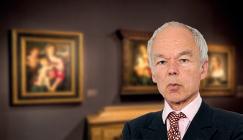



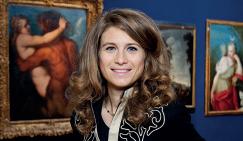




SENIOR SALE COORDINATOR
Sacha Sabadel
Tel: +44 (0)20 7389 2210
BUSINESS MANAGER
Lottie Gammie
Tel: +44 (0)20 7389 5151
First initial followed by last name@christies.com (e.g. Clementine Sinclair = csinclair@christies.com). For general enquiries about this auction, emails should be addressed to the Sale Coordinator.
ABSENTEE AND TELEPHONE BIDS
Tel: +44 (0)20 7389 2658
Fax: +44 (0)20 7930 8870
AUCTION RESULTS
Tel: +44 (0)20 7839 9060 christies.com
CLIENT SERVICES
Tel: +44 (0)20 7839 9060
Fax: +44 (0)20 7389 2869
Email: info@christies.com
POST-SALE SERVICES
Nick Meyer
Senior Post-Sale Coordinator
Payment, Shipping, and Collection
Tel: +44 (0)20 7752 3200
Fax: +44 (0)20 7752 3300
Email: PostSaleUK@christies.com
BUYING AT CHRISTIE’S
For an overview of the process, see the Buying at Christie’s section. christies.com
The Crucifixion with the Madonna, Saint John the Evangelist and two angels tempera on gold ground panel, triangular, in a partially integral frame 13¬ x 19º in. (34.6 x 49 cm.)
£100,000-150,000
US$130,000-190,000
€120,000-180,000
PROVENANCE:
Acquired by the grandfather of the present owner, and by inheritance.
Paolo Veneziano was the most prominent artist in Venice during the fourteenth century, running a thriving workshop that arguably laid the foundations of the Venetian school of painting in successive centuries. With his roots in the Byzantine tradition, he created a new idiom that would earn commissions from his native city and beyond.
This panel, to date unknown, is a significant addition to the corpus of the artist, providing further insight into his activity during his late maturity. It almost certainly served as the central pinnacle of a triptych, or polyptych; the triangular shape is unusual in his oeuvre, indeed this may be the only such example. In its overall design, the composition is close to the middle panel in the upper register of the Polyptych of Saint Lucy, given to Veneziano and his workshop, made circa 1325 for the Abbey of St. Lucy in the village of Jurandvor, Croatia. In terms of execution it can be compared most instructively to the Crucifixion in the National Gallery of Art, Melbourne (fig. 1), which is on a larger scale and of a different format, and dates to circa 1350. Both these panels feature a parapet with crenellations behind the lower part of the cross,

a motif that represents the wall of Jerusalem, and occurs more widely in the artist’s work (for example in the Crucifixion in the National Gallery of Art, Washington). It is also used here, in this newly discovered panel, where the surface of the wall itself is embellished with foliate decoration. The parapet acts as an elegant pictorial device that gives the work depth and volume.
The figure of Christ, which is well preserved, is executed with great refinement, with delicate highlights on his face and torso. Dr. Christopher Platts, to whom we are grateful, first proposed that this is a mature work by the artist (on the basis of photographs), datable to circa 1350, noting that the handling of Christ is in fact of higher quality than other comparable figures given to Paolo Veneziano and his workshop around the same time. We are also grateful to Dr. Cristina Guarnieri and Dr. John Witty, who have further endorsed the attribution, also on the basis of photographs. All scholars note that the gold ground – and consequently the figures' haloes – appear to be for the most part new, unfortunately obscuring Paolo Veneziano’s characteristic punch marks that can be helpful in the dating of his paintings.

An Allegory of Transience
indistinctly signed (upper right, on the column) oil on canvas, unframed 48¬ x 38¿ in. (123.6 x 96.8 cm.), with additions to the upper and lower edges of º in. (0.5 cm.)
inscribed 'Defecerun[t] si[cut] fumus dies / mei Psalm 101' (centre right, on the paper held in the book)
£100,000-150,000
US$130,000-190,000
€120,000-180,000
PROVENANCE:
Sir Charles Arthur Turner, K.C.I.E. (1833-1907), London. Michiel Onnes, called Onnes van Nijenrode (1878-1972), Castle Nijenrode, Breukelen; his sale, Frederik Muller & Cie, Amsterdam, 4 July 1933, lot 20, as 'Attributed to Anthony van Dyck, with the suspected collaboration of Daniel Seghers' (unsold). Anonymous sale; Sotheby's, Amsterdam, 12 November 1991, lot 218, as 'Daniel Seghers and Cornelis Schut'.
Anonymous sale; Sotheby's, London, 16 December 1999, lot 59, as 'Thomas Willeboirts Bosschaert' and 'an unidentified hand working in the following of Daniel Seghers', where acquired by the present owner.
EXHIBITED:
London, Royal Academy of Arts, Exhibition of Works by Van Dyck 1599-1641, 1 January-10 March 1900, no. 110, as 'Anthony van Dyck', measuring 43Ω x 33Ω in. (lent by Sir Charles Turner).
LITERATURE:
E. Schaeffer, Van Dyck: Des Meisters Gemälde, Klassiker der Kunst, XIII, Stuttgart and Leipzig, 1909, p. 462.

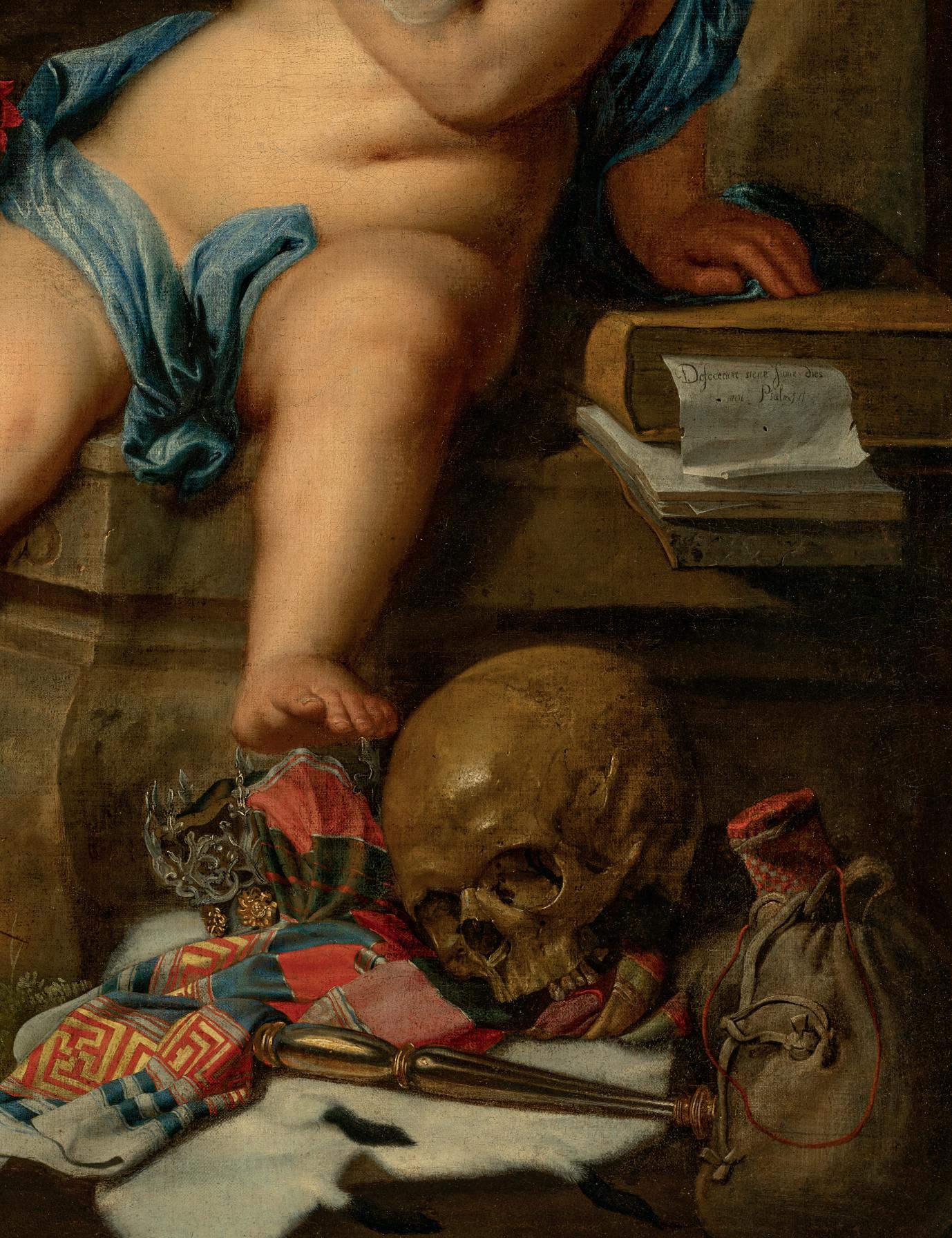
Though the figure of the gesturing putto in this painting has previously been attributed to Sir Anthony van Dyck, Cornelis Schut and Thomas Willeboirts Bosschaert, and the still life elements to Daniël Seghers or a close follower, Dr. Bert Schepers has recently proposed instead that it is the work of Erasmus Quellinus II (on the basis of photographs; private communication, 7 June 2024), a talented pupil and collaborator of Sir Peter Paul Rubens in the 1630s. Fred G. Meijer has further suggested that the still-life elements are by one, possibly two, thus far unidentifiable hands (private communication, 4 October 2024).
The early attribution to van Dyck is understandable because, as Schepers has pointed out, the figure derives from the angel seated at the base of van Dyck’s Christ on the cross with Saint Catherine of Siena, Saint Dominic and an angel of circa 1622-7 in the Koninklijk Museum voor Schone Kunsten, Antwerp (fig. 1). Intriguingly, van Dyck’s painting was engraved by Schelte à Bolswert in 1653 from an intermediary drawing by Quellinus. A similar putto also appears at lower centre in Quellinus’s grisaille modello for Paulus Pontius’s engraved double portrait of Rubens and van Dyck, which was recently returned to the Devonshire Collection at Chatsworth House after its theft in 1979.
The Latin inscription on the leaf of paper tucked between the pages of the book emphasises the painting’s vanitas theme, translating to ‘For my days vanish like smoke’, taken from Psalm 101:4. The putto, in turn, further reinforces the idea by pointing over his shoulder to billowing smoke while sitting atop a sarcophagus inscribed with the letters ‘D.M.S.’ for ‘Dis Manibus Sacrum’ (‘for the ghostgods’), a common pagan inscription preceding the name of the deceased on a tombstone. The floral bouquet similarly conveys a sense of transient beauty, for the flowers will wither and die, while the skull, crown, sceptre, richly worked cloth and bag of money all convey the ultimate futility of seeking earthly wealth and power.
The evident superior quality of the present picture has led Dr. Schepers to believe it to be the prime of this composition, of which various inferior versions have appeared on the market in recent years, including one given to Willeboirts Bosschaert at the Dorotheum, Vienna, 17 October 2007, lot 228; another described as by a follower of Jan van den Hoecke, sold at Bukowskis, Stockholm, 14-16 June 2023, lot 709; and one given to the workshop of Quellinus that appeared at Audap & Associés, Paris, 28 March 2024, lot 37.
We are grateful to Dr. Bert Schepers for suggesting the attribution to Erasmus Quellinus on the basis of photographs and for identifying the source for the putto, and to Dr. Fred G. Meijer for his thoughts on the still-life elements.
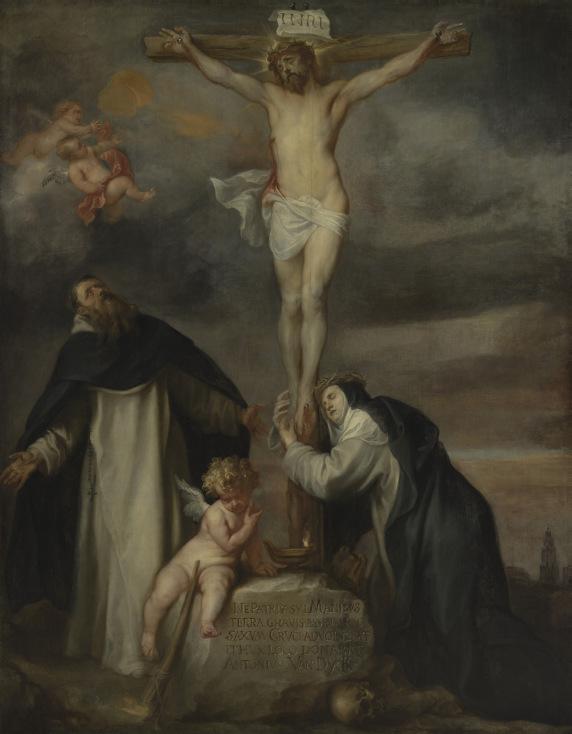

PROPERTY FROM A PRIVATE EUROPEAN COLLECTION 3 JAN BRUEGHEL I (BRUSSELS 1568-1625 ANTWERP) AND JOOS DE MOMPER II (ANTWERP C.1564-1635)
A winter river landscape with travellers on a path oil on panel 26¿ x 61Ω in. (66.4 x 156.2 cm.)
£100,000-150,000
US$130,000-190,000
€120,000-180,000
PROVENANCE:
Collection of the Barons de Heusch de la Zangrye, and by inheritance in the family to the following, Baroness de Heusch de la Zangrye, s'Hertogenbosch, from whom acquired by, Piet de Boer (1894-1974), Hergiswil, by 1964, by whom very probably sold to, Dr. Andreas Becker, Dortmund, by 1967 and until 1975.
with Galerie Cramer, The Hague, where acquired by the father of the present owner in July 1976.

LITERATURE:
R. Fritz, Sammlung Becker I: Gemälde alter Meister, Dortmund, 1967, no. 73, illustrated. 'Delft Antique Dealers' Fair 1975 - Galerie Cramer Advertisement', Apollo, CII, October 1975, p. 84.
M. L. Flammersfeld, 'Vorschau auf die Delfter Antiekbeurs', Weltkunst, XLV, 1 October 1975, p. 1592, illustrated.
K. Ertz, Jan Brueghel d. A. Die Gemälde mit kritischem Oeuvrekatalog, Cologne, 1979, pp. 484-6 and 624, no. 404, fig. 587 and 588 (detail).
T. Gerszi, 'Joos de Momper und die Bruegel-Tradition', Netherlandish Mannerism, Stockholm, 1985, p. 163, fig. 21, as 'Joos de Momper'.
K. Ertz, Josse de Momper der Jüngere (1564-1635): die Gemälde mit kritischem Ouvrekatalog, Freren, 1986, pp. 140 and 577, no. 401, fig. 117.
K. Ertz and C. Nitze-Ertz, Jan Brueghel der Ältere: die Gemälde, mit kritischem Oeuvrekatalog, IV, Lingen, 2008-2010, p. 1583, no. 771, illustrated.


Jan Brueghel the Elder and Joos de Momper the Younger enjoyed a fruitful collaboration over the course of some thirty years beginning in the early 1590s, through to at least 1623, that resulted in no fewer than 200 hundred surviving pictures (see Ertz and Nitze-Ertz, op. cit., nos. 604-810). The vast majority of these paintings saw Brueghel add the figures into the mountainous panoramas for which de Momper was so highly regarded. The present winter landscape is a relatively unusual collaboration between the two artists, with fewer than thirty such examples known. Their joint production of these winter scenes only appears to have begun in the second decade of the seventeenth century.
It is perhaps fitting that Jan the Elder provided the staffage for this landscape, which Klaus Ertz has dated to circa 1615-20 (op. cit.). As Teréz Gerszi has pointed out, the painting is a unique take on the tradition of Jan’s father, Pieter Bruegel the Elder (op. cit.). The painting, which Gerszi described as a ‘very high quality forward-looking’ (‘sehr qualitätvolle vorwärtsweisende’) landscape, displays ‘only a faint reflection’ (‘nur einen schwachen Abglanz’) of the elder Bruegel’s pioneering Winter landscape with skaters and bird trap of 1565 in Brussels (fig. 1). Specifically, de Momper has flipped the structure of the composition so that the most prominent houses anchor the left rather than right-hand portion of the composition while retaining the earlier painting’s striking orthogonally-drawn canal.
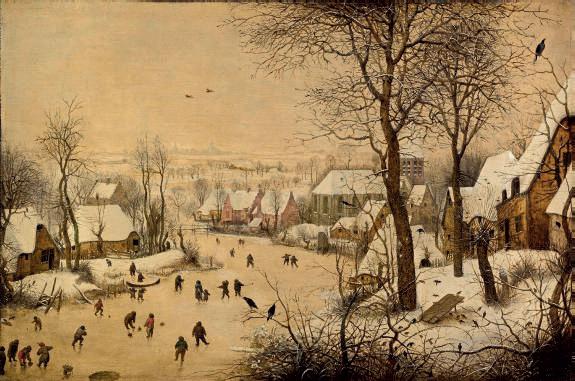
The Sermon of St. John the Baptist oil on panel
40¡ x 65¿ in. (102.5 x 165.2 cm.)
£800,000-1,200,000
US$1,100,000-1,600,000
€970,000-1,400,000
PROVENANCE:
J.B. Blommaert; his sale (†), D. Massyn and H. Lecler, Rue Longue des Violettes no. 136, Ghent, 8-9 October 1855, lot 33, as 'Tableau très-curieux du plus beau faire du maître', where acquired by, Baron Ludovicus Le Candèle van Humbeek (d. 1880), and by inheritance to his nephew, son of his late sister, Isabelle (1802-1865), wife of Baron Édouard-Jean Lunden, Baron Théophile Lunden (1834-1908), 's Gravenkasteel, Grimbergen, and by descent to the present owners.
LITERATURE:
G. Marlier, Pierre Brueghel le Jeune, Brussels, 1969, p. 57, no. 16. K. Ertz, Pieter Brueghel der Jüngere, I, Lingen, 1988/2000, p. 377, no. F345, under questionable attributions and catalogued as unseen by the author.

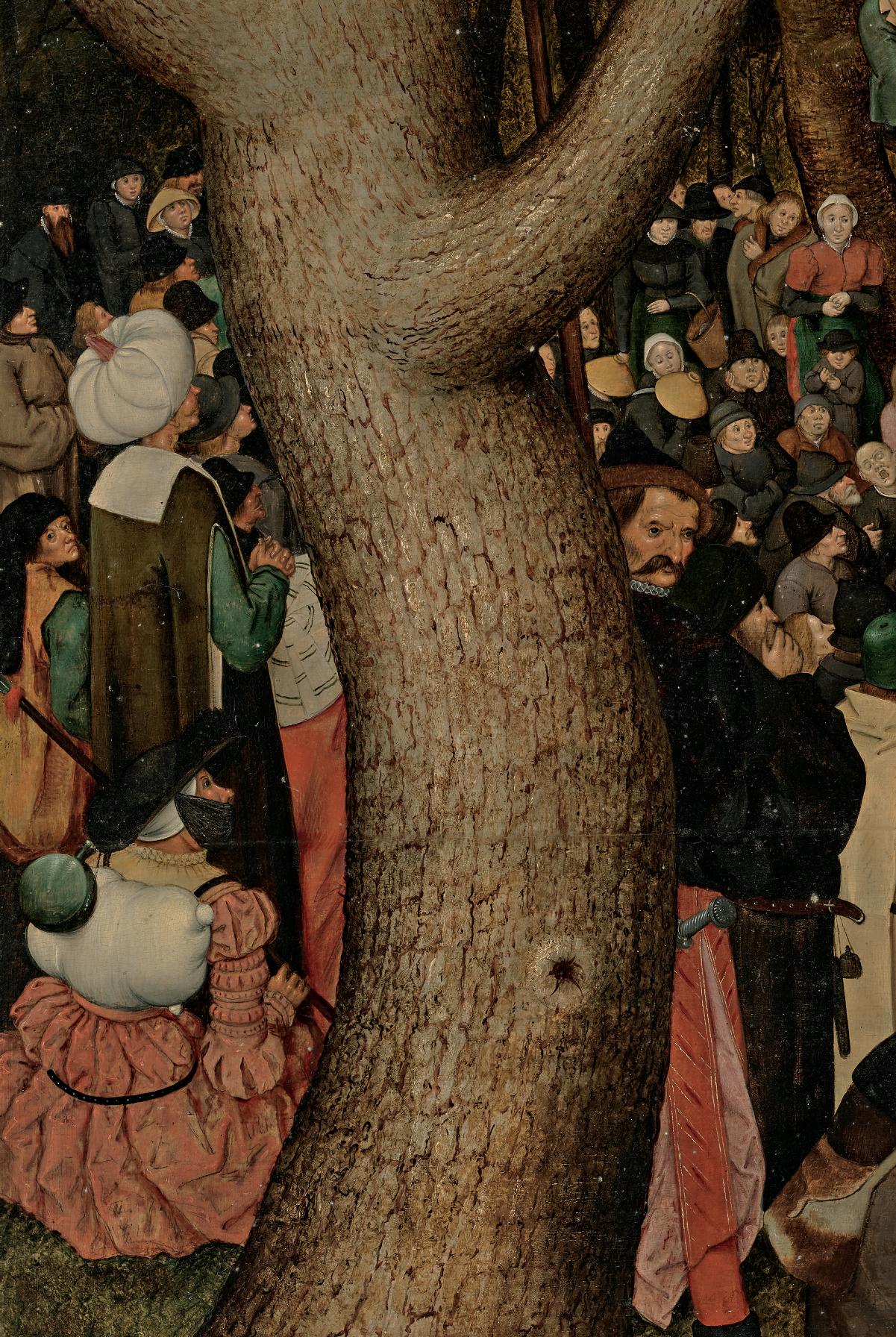
This Sermon of Saint John the Baptist is one of the finest treatments of what was Pieter Brueghel the Younger's most successful and popular large-scale religious composition. Yet, until now, it has remained largely known only through its first and last appearance at auction in 1855, when it was acquired by ancestors of the present owners (see Provenance). It would first be published in 1969 in Georges Marlier’s catalogue raisonné on the artist under Brueghel’s unsigned autograph versions (op. cit.). Decades later, Klaus Ertz would include it in his own catalogue, this time under the artist’s questionable works, having never seen it in the flesh or seemingly from an image, referencing only Marlier’s description of the work in his entry. Its reappearance and constitutes a major addition to our appreciation of Brueghel the Younger's oeuvre remarkable both in terms of the skilfully detailed characterisation of the figures and its wonderful state of preservation.
The inspiration for the subject, as with so many of the younger Brueghel's paintings, was provided by a work of his father Pieter Bruegel the Elder (c. 1525-1569), widely acknowledged as the picture dated 1566 in the Széptmûvészeti Museum, Budapest (fig. 1). The quality and number of extant versions by the younger Brueghel suggest that he knew his father's original in spite of the thirty years or more that elapsed between his own production and his father's death. Klaus Ertz recorded thirteen autograph versions, including dated examples from 1601 (Bonn, Rheinisches Landesmuseum), 1604 (St. Petersburg, Hermitage), 1620 (Bern, Ludwig Collection) and 1624 (Lier, Stedelijk Museum Wuyts-Van Campen en Baron Caroly), as well as significant undated examples, such as that formerly in the collection of Baron Evence III Coppée (1882-1945), sold in these Rooms, 7 July 2009, lot 8 (£1,497,250). Like the present picture, many works would also remain on the walls of private collections and unknown to Ertz, like the remarkable example also sold in these Rooms on 8 December 2009 (lot 16, £1,553,250).
Painted in the year of the iconoclastic outbreaks in the Low Countries, scholars have long held the view that Bruegel the Elder's picture offered a coded comment on the religious debates that raged in the region during the 1560s,
interpreted as an allusion to the clandestine sermons that Protestant reformers held in the countryside in response to anti-Protestant Habsburg policies. Yet Bruegel’s Sermon was significant not for its presumed political associations but the ‘transformation of the theme from an earlier landscape tradition into a rationale for portraying the great variety of humanity' (A. Woollett and A. van Suchtelen, eds., Rubens and Brueghel: A Working Friendship exhibition catalogue, Los Angeles, 2006 p. 188).
In the central foreground, as here, the artist (a devout Catholic) depicts a man in black who faces the viewer and reads the palm of his neighbour, which can be seen as thinly veiled defiance against Calvin's prohibition of the reading of palms. The distinctive face of the perpetrator suggests that it may be a portrait, and several candidates have been proposed, including the artist himself, the commissioner of the painting or Thomas Armenteros, the adviser to Margaret of Parma, though all remain supposition. The figure of Christ has often been identified either as the man in grey behind the left arm of the Baptist or the bearded man further to the left with his arms crossed. Inverting the relationship between the religious subject and its setting, the scene is filled with an astonishing assortment of figures and delightful vignettes that emphasise the disassociation from the message of God, with the viewer also placed in the role of a spectator, observing the scattering of diverse figures from behind.
The popularity of the picture a generation later, in the time of Brueghel the Younger, attests to a more general, aesthetic appreciation of the theme, when the subject had not only lost its political implications but ran contrary to the religious current of the time. Jacqueline Folie observed that the composition was enjoyed more for its representation of humanity, with the motley crowd gathered around John the Baptist embodying 'the whole human race in all its diversity of races, social conditions, temperaments and inner dispositions –eager, attentive, curious, sceptical or indifferent listeners’ (translated from the French, in Bruegel: Une dynastie de peintres exhibition catalogue, Palais des Beaux-Arts, Brussels, 1980, p. 143).
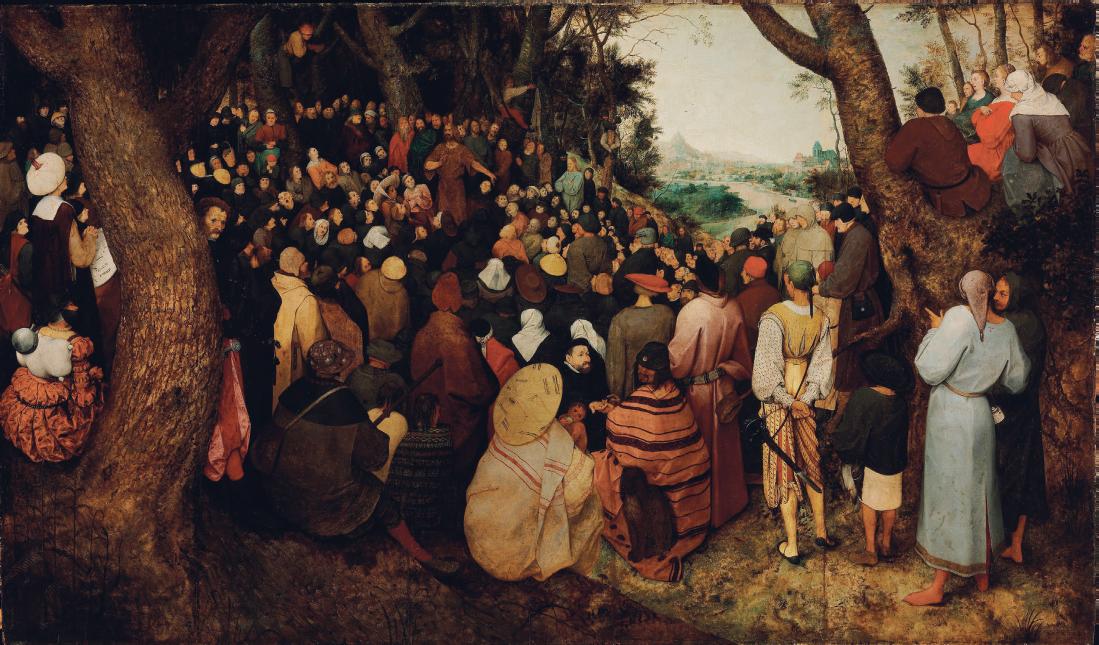
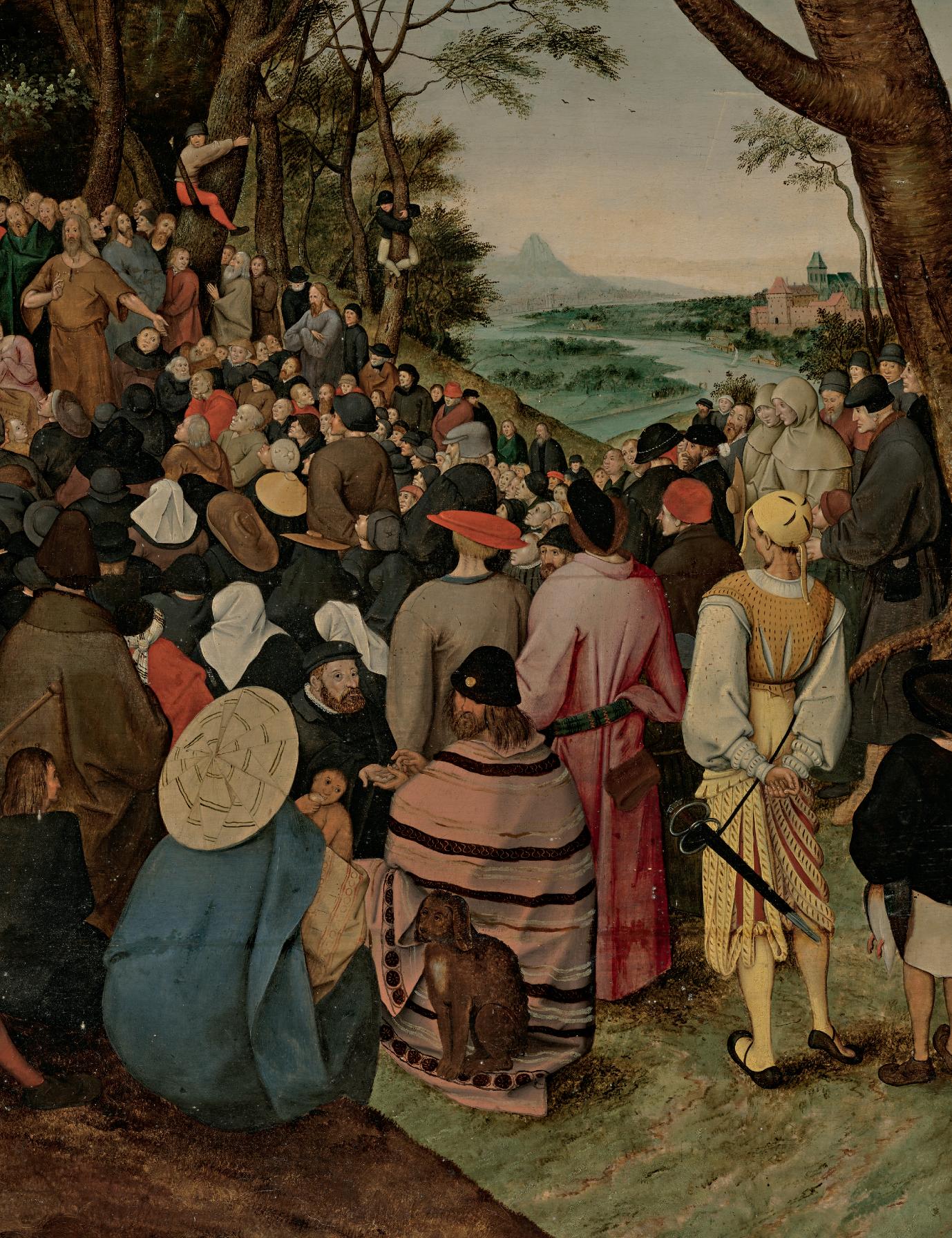
Memento mori: Death comes to the table
oil on canvas, unframed
32Ω x 40Ω in. (82.5 x 102.8 cm), including additions, measuring 2 in. (5.1 cm.) along the upper edge, and 1 in. (2.5 cm.) along the left, right and lower edges
£100,000-150,000
US$130,000-190,000
€120,000-180,000
PROVENANCE:
with P. & D. Colnaghi & Co., London, by 1959, as 'Angelo Caroselli'.
Anonymous sale; Sotheby's, London, 29 November 1961, lot 100, as 'Pietro Paolini', sold for £220 to the following, with Arcade Gallery, London.
Anonymous sale; Christie's, London, 5 July 1996, lot 42, where acquired by the present owner.
LITERATURE:
The Illustrated London News, Christmas issue 1959, 235, 6274A, p. 82, as 'Angelo Caroselli'.
B. Nicolson, 'Current and Forthcoming Exhibitions', The Burlington Magazine, CI, no. 674, May 1959, p. 199, as 'attributed with excellent reason to Caroselli'.
B. Nicolson, '"Figures at a Table" at Sarasota', The Burlington Magazine, CII, no. 686, May 1960, p. 226, as 'an artist, probably Flemish, of the type of Finson' (in connection with a related picture).
R. Spear, Caravaggio and His Followers, Cleveland, 1971, pp. 88-9, fig. 19, as 'attributed to Jean Ducamps'.
B. Nicolson, The International Caravaggesque Movement, Oxford, 1979, p. 47, as 'Jean Ducamps'.
B. Nicolson, Caravaggism in Europe, ed. L. Vertova, Turin, 1990, I, p. 104; II, fig. 365, as 'Jean Ducamps/Giovanni Martinelli'.
L. Vertova, ‘La Morte Secca’, Mitteilungen des Kunsthistorischen Institutes in Florenz, XXXVI, 1992, pp. 116 and 117, fig. 11.
F. Baldassari, La Pittura del Seicento a Firenze. Indice degli Artisti e delle loro Opere, Turin, 2009, p. 525, with erroneous ex-Fonteguerri provenance. (Possibly) S. Bellesi, Catalogo dei Pittori Fiorentini del 600 e 700: Biografie e opere, Florence, 2009, p. 194.
G. Cantelli, Repertorio della Pittura Fiorentina del Seicento. Aggiornamento, Pontedera, 2009, p. 141, as a 'replica' and with an incorrect 1996 sale date.
G. Papi, ‘Giovanni Martinelli, fra Artemisia e Vouet’, Giovanni Martinelli, da Montevarchi pittore in Firenze, Florence, 2011, pp. 35-6, 47, footnote 9, fig. 4.



This allegorical painting is a fine work by Giovanni Martinelli, an enigmatic painter active in Tuscany during the first half of the seventeenth century who is mysteriously absent from the Notizie by the Florentine biographer Filippo Baldinucci and has only re-emerged as a significant artistic figure in recent decades. As noted by Gianni Papi in a collection of essays published to coincide with the first monographic exhibition dedicated to the painter in 2011: ‘Giovanni Martinelli is to this day a painter too little known with respect to his true worth and that of contemporary painters who are held in far higher esteem’ (op. cit., p. 33).
Elegantly dressed figures are gathered around a table laid with food and wine – a crusty tart, roasted quail and red grapes are on display in silver (or more likely pewter) plates. The party has been abruptly disturbed, its guests caught by surprise by a skeleton holding out an hour-glass, a symbol of the passage of time and inevitability of death. What moments ago must have been a scene of merriment has taken a sudden turn for the worse: the skeleton has disrupted their meal to remind them that Death can strike anyone, at any time, even in a moment of joyful recreation (‘memento mori’ meaning literally ‘remember you must die’). The impending doom is underlined by the reaction of the youth in the foreground who impulsively unsheathes his sword. The figures’ gestures underscore the sense of unease: the two women whisper conspiratorially as they look towards the intruder, one of them pointing to the young man who looks over his shoulder at the skeleton while grabbing the edge of the table. He seems astonished and draws his other hand to his chest in recognition of the fact that he is the intended recipient of the skeleton’s warning – the young man’s time is, quite literally, up. Eloquently described by Benedict Nicolson, the great twentieth-century scholar of Caravaggesque painting, this ‘group of young lovers [are] tiresomely reminded of the transitory nature of youth and pleasure’ (Nicolson, op. cit., 1959).
This painting’s composition clearly enjoyed considerable success, for it exists in a number of autograph variants and copies (nine are listed in Nicolson, ed. Vertova, op. cit., p. 104). The finest, and the most ambitious, is in the New Orleans Museum of Art (known as The Isaac Delgado Museum of Art prior to 1971) and broadly repeats the composition of the present work though with some differences and including two additional figures at left (fig. 1). The attribution of this interrelated group of paintings has been the subject of much debate among scholars, with various names being attached to one or other of the variants. Over the years, the New Orleans canvas has been ascribed to
Bartolomeo Manfredi, Cecco del Caravaggio, Jean Le Clerc, Nicolas Tournier and Rutilio Manetti, while the names of Pietro Paolini and Angelo Caroselli have been attached to the present variant (the latter ‘with excellent reason’, according to Nicolson, op. cit., 1959). Not only did the identity of the painter baffle scholars, but also his nationality; Nicolson posited that the painter was Flemish and Richard Spear noted that ‘numerous features reveal the northern training of the artist of this picture’, namely the marked care with which the still-life details are described and the vanitas subject matter that was more commonly found in northern Europe than in Italy at this time (Spear, op. cit., 1971, p. 88).
A further clue was provided by the initials ‘DC’ found on two paintings of Gamblers by the same hand as the author of the Memento Mori group. These initials were interpreted as representing the signature of Jean Ducamps, or Giovanni del Campo (1600-1648), a pupil of Abraham Janssens in Antwerp who became a founder member of the Bentvueghels in Rome and died in Spain sometime after 1628. Although the attribution to Ducamps was taken up by Spear and Nicolson, an alternative identification with Domenico Carpinoni, a Bergamasque follower of Palma il Giovane, was put forward by Ruggeri (see a summary of attributions in Nicolson, ed. Vertova, op. cit., p. 104). It was not until the comprehensive study of Florentine paintings in 1980s, by Giuseppe Cantelli and others, that the name of Giovanni Martinelli was associated definitively with the composition, an attribution that subsequently found favour among other scholars of Florentine Seicento painting, namely Sandro Bellesi and Francesca Baldassari (op. cit.). A formal and stylistic comparison between the figures in this painting and those in other recognised works by Martinelli provides compelling evidence for this attribution. In particular, the two women in the centre of this composition are directly comparable in pose and type to the gesturing female and violinist in Martinelli’s Youth with Violin in the High Museum of Art, Atlanta (fig. 2).
The numerous variants of this composition attest to the popularity and demand for pictures of this type in seventeenth-century Italy. Falling somewhere between a genre painting and a still life, the image carries a moralizing message: life is short and not to be frittered away, particularly since Death can strike at any moment. The picture probably dates from the 1630s, by which time Caravaggesque painting was falling largely out of fashion, but the dramatic nature of its subject is all the more vivid owing to the stark lighting and tightly cropped composition, both of which ultimately derive from Caravaggio.

A lady playing a lute and a gentleman with a viola da gamba oil on canvas
19Ω x 15 in. (49.5 x 38.1 cm.)
£80,000-120,000
US$110,000-160,000
€96,000-140,000
PROVENANCE:
(Probably) Hendrik Schut, Rotterdam; his sale, Buurt, Rotterdam, 8 April 1739, lot 1, as 'Adriaen van der Werff' (f 305).
(Possibly) Pieter van Dorp, Leiden; (†) his sale, Luchtmans, Leiden, 16 October 1760, lot 2, as 'Caspar Netscher' (f 260).
Baron Willem Joseph van Brienen van de Groote Lindt (1760-1839), The Hague, and by descent to his son,
Baron Arnoud Willem van Brienen van de Groote Lindt (1783-1854), The Hague, and by descent to his son,
Baron Thierry van Brienen van de Groote Lindt (1814-1863), The Hague; (†) his sale, Hôtel Drouot, Paris, 8 May 1865, lot 47 (FF 2600 to Say).
(Probably) Anonymous sale; Christie's, London, 24 November 1900, lot 28, as 'G. Netscher' (26 gns. to Shepherd).
with Colnaghi, London, where acquired by, Emma Ranette Budge (1852-1937), New York and Hamburg; (†) her involuntary sale, Graupe, Berlin, scheduled for 27 September but postponed until 4-6 October 1937, lot 6, as 'Caspar Netscher' (RM 15,000).
Eugene L. Garbáty, Schloss Alt-Doebern, Niederlausitz, and later Shore Haven, CT, until 1946.
with Bree and van Groot, The Hague, 1958. with Leger Galleries, London, 1958, as 'Constantijn Netscher'. with Acquavella Gallery, New York.
Rudolf von Fluegge, New York; his sale, Doyle, New York, 25 January 1984, lot 23, as 'Caspar Netscher'.
with Richard Green, London, 1984, as 'Eglon van der Neer', where acquired by, Private collection, Washington, D.C. with Johnny Van Haeften, London, 1987-1994. with Otto Naumann, New York, by 1997.
Anonymous sale; Sotheby's, New York, 4 June 2009, lot 45 (sold pursuant to a restitution settlement agreement with the heirs of Emma Budge), where acquired by the present owner.
EXHIBITED:
Hamburg, Kunsthalle, Leihausstellung aus Hamburgischem Privatbesitz in der Kunsthalle, 1925, no. 248, as 'Caspar Netscher'.
New York, New School, Loan Exhibition of Paintings from Collections of Associate Members, 3-17 March 1946, no. 10, as 'Casper Netscher'. Rotterdam, Historisch Museum, Rotterdamse Meesters uit de Gouden Eeuw, 15 October 1994-15 January 1995, no. 71, as 'Adriaen van der Werff'. New York, The Chinese Porcelain Company, The Age of Gallantry, Fine and Decorative Arts of the Netherlands 1672-1800, 12 October-4 November 1995, no. 5, as 'Adriaen van der Werff'.
Greenwich, CT, The Bruce Museum, Pleasures of Collecting: Part I: Renaissance to Impressionist Masterpieces, 21 September 2002-5 January 2003, as 'Adriaen van der Werff'.
LITERATURE:
G. Hoet, Catalogus of Naamlyst van Schilderyen met derzelver pryzen..., I, The Hague, 1752, p. 572, no. 1, as 'Adriaen van der Werff'.
J. Smith, A Catalogue Raisonné of the Works of the Most Eminent Dutch, Flemish and French Painters of the Seventeenth Century, IV, London, 1833, p. 211, no. 103, as 'Adriaen van der Werff'.
(Possibly) C. Hofstede de Groot, A Catalogue Raisonné of the Works of the Most Eminent Dutch, Flemish, and French Painters of the Seventeenth Century, V, London, 1912, p. 189, nos. 120 and 125f, as 'Caspar Netscher'; X, Stuttgart and Paris, 1928, p. 278, no. 164, as 'Adriaen van der Werff'.
S.J. Gudlaugsson, 'Ten onrechte aan Caspar Netscher toegeschreven schilderijen van Adriaen van der Werff, Renier de la Haye, Thomas van der Wilt, en Johannes van Haensbergen', Oud Holland, LXV, 1950, pp. 242-243, 246, fig. 1, as 'Adriaen van der Werff'.
B. Gaehtgens, Adriaen van der Werff, 1659-1722, Munich, 1987, pp. 203-5, no. 9, pl. I, as 'Adriaen van der Werff'.
M.E. Wieseman, Caspar Netscher and late seventeenth century Dutch painting, Ph.D. dissertation, 1991, p. 511, no. C59, as 'Adriaen van der Werff'.
M.E. Wieseman, Caspar Netscher and Late Seventeenth-Century Dutch Painting, Doornspijk, 2002, no. C66, p. 351, as 'Adriaen van der Werff'.
W. Franits, Dutch Seventeenth-Century Genre Painting, New Haven, 2004, pp. 254-55, fig. 235, as 'Adriaen van der Werff'.
E. Schavemaker, Eglon van der Neer (1635/36-1703): His Life and His Work, Doornspijk, 2010, pp. 65, 75-6, 484-5, no. 81, pl. XXVI.
S. Avery-Quash, 'The Travel Notebooks of Sir Charles Eastlake: Volume I', The Volume of the Walpole Society, LXXIII, 2011, p. 544, as 'Adriaen van der Werff'.

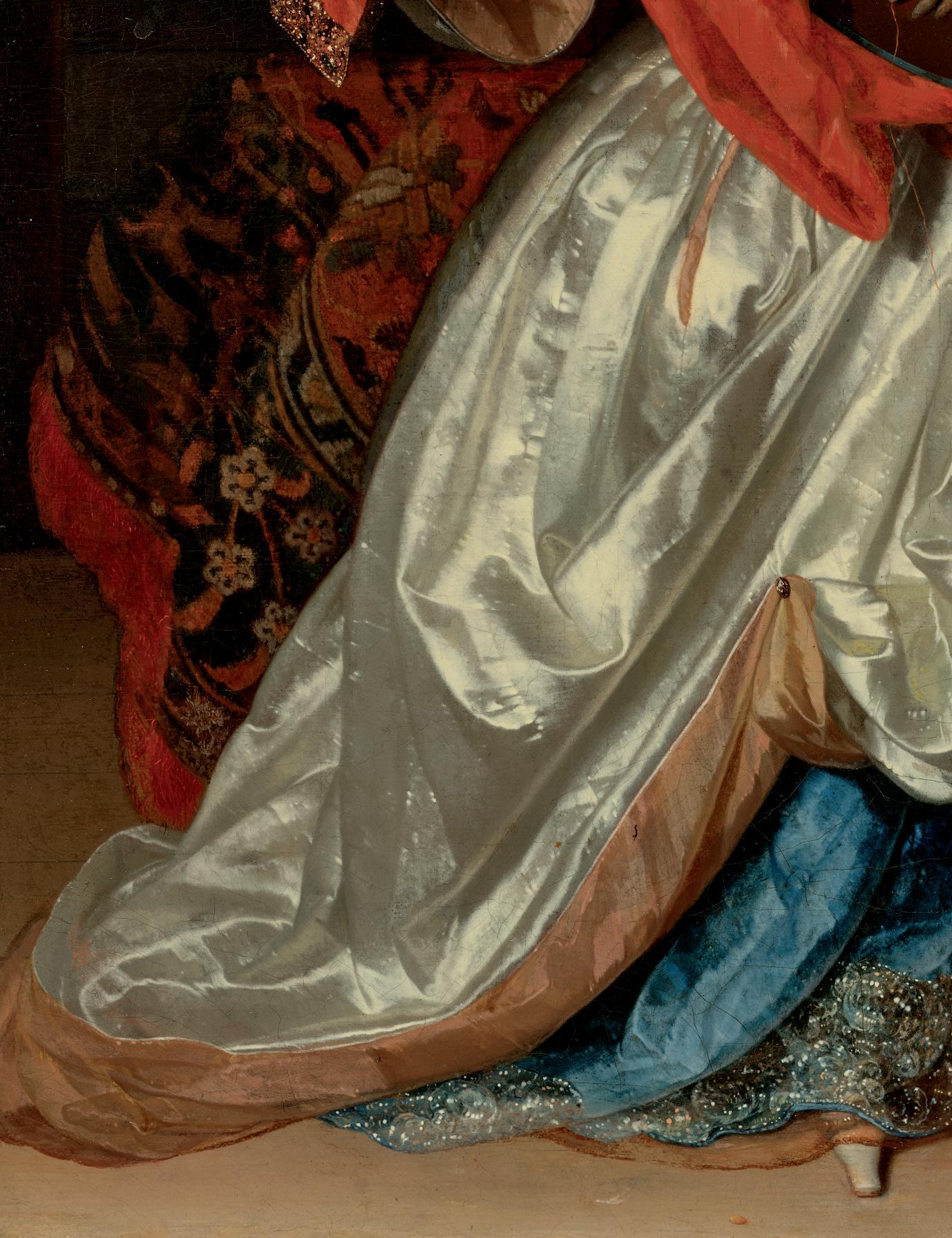
Though attributed solely to Adriaen van der Werff by John Smith (1833), Cornelis Hofstede de Groot (1928), Sturla J. Gudlaugsson (1950), Barbara Gaehtgens (1987), Betsy Wieseman (1991, 2002) and Wayne Franits (2004), this painting has recently and convincingly been recognised as an intriguing example of a collaboration by van der Werff and his master, Eglon van der Neer (see Schavemaker, op. cit., pp. 75-76). Following an eighteen-month apprenticeship with the otherwise unknown Cornelis Picolet around 1669, in or around 1671, the then twelve-year-old van der Werff entered van der Neer’s Rotterdam studio, initially for a one-year period. At the end of this period, the term of study was extended for three additional years and, in 1675, van der Werff signed a new contract to serve as van der Neer’s apprentice for eighteen more months. During his apprenticeship, van der Werff was allowed to split his time equally working for van der Neer and on independent projects. Though van der Werff became a fully independent master before his eighteenth birthday in 1677, he and van der Neer remained close. The younger artist may even have been ‘hired’ as an independent master to complete the elder artist’s paintings in the years before he settled in Brussels in 1680.
As Eddy Schavemaker has suggested, the present painting is one of perhaps only five extant works that suggests the involvement of both artists. In addition to the present painting, the author cited the Woman with a ring and a man of 1678 (fig. 1; St. Petersburg, State Hermitage Museum), the only example that bears the signature of both painters; the Two boys with a mousetrap and cat in a window of 1676 (Germany, Private collection, on loan to the Gemäldegalerie, Berlin), which is signed solely by van der Werff but whose quality exceeds that of the artist's other known paintings in the period; the Portrait of a woman of 1678 (Europe, Private collection), which is signed by van der Werff but largely by van der Neer, with the younger artist putting only the finishing details on the painting; the Man with a pipe and rummer in a window of 1682 (South Carolina, Private collection), which is signed exclusively by van der Neer; and the Sophonisba being Offered the Poisoned Cup (Cambridge, Fitzwilliam Museum), which is signed by van der Werff but which Schavemaker suggests was ‘probably made in collaboration with his teacher van der Neer’ (op. cit., p. 217, no. 3, under Appendix IV). Van der Neer had previously treated this historical subject in a painting dated 1674 (present location unknown).
The hallmarks of each artist are especially clear in the present painting, with the differences particularly evident in the faces of the young woman and man. The woman’s head, viewed in three-quarter profile, is notably skilful in its handling and is highly comparable to a number of similar heads in van der Neer’s oeuvre
The man’s face, viewed more-or-less head-on and with almond-shaped eyes, is instead characteristic of the youthful van der Werff. Van der Werff similarly appears to have been the one responsible for the young man’s beautifully rendered torso and the atmospherically conceived background, while van der Neer likely painted the viola da gamba, chair legs and the woman’s flowing satin gown, all of which are depicted with his usual precision (for further discussion on the two hands, see Schavemaker, op. cit., pp. 75-76).
The man’s face in the present painting is especially close to that of the youthful drummer in van der Werff’s Boy playing a drum (present location unknown; see Gaehtgens, op. cit., pp. 202-3, no. 7, fig. 7). That painting is in turn based on one dated 1676 by van der Neer (United Kingdom, Private collection; see Schavemaker, op. cit., p. 478, no. 66, fig. 66). While Schavemaker did not posit a specific dating for the present painting, in her monograph on van der Werff,
Gaehtgens noted the close similarities between it and van der Neer’s works of 1674-8 and plausibly concluded that it should be dated to circa 1678 (loc. cit.), the year in which – insofar as can be determined – the two artists collaborated most regularly.
The subject of couples making music was a popular one among artists who specialised in the production of high-life genre paintings in the second half of the seventeenth century and carried with it connotations of intimate affections between the participants. Instruction in music and dance was also a standard feature of an upper-class education in the seventeenth century, an idea which is reinforced here by the protagonists’ sumptuous clothing and elegant, slightly languid posture. However, the two artists have cleverly, if subtly, called into question our preconceived perceptions of the situation: the woman holds the theorbo both the wrong way around and upside down; the man holds the bow in his left hand; and both instruments appear with broken strings.
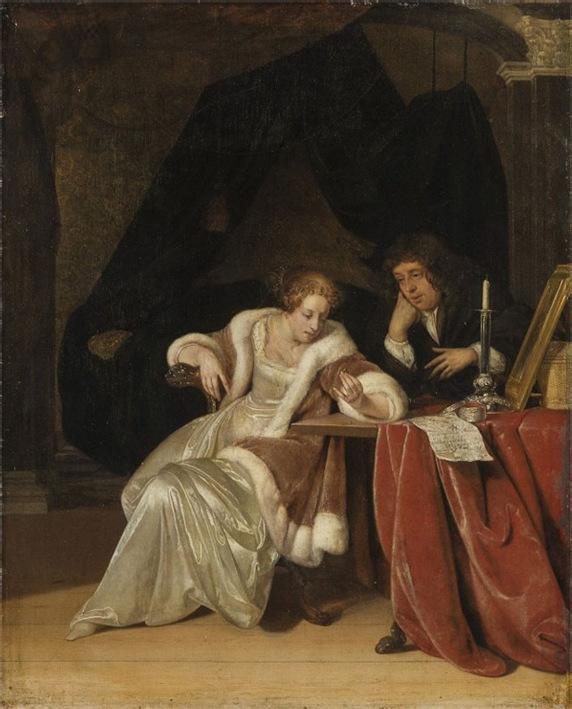
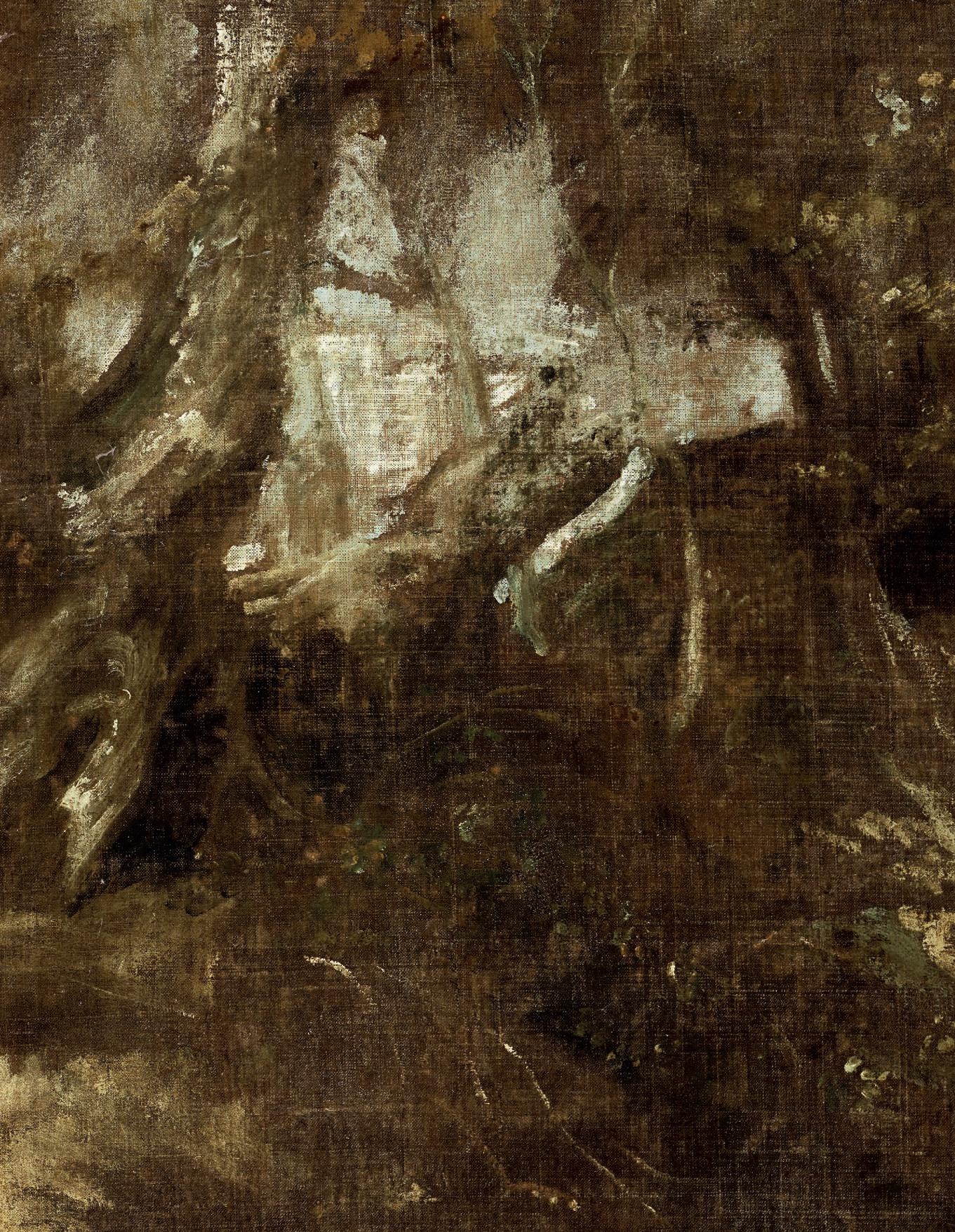

An Andalusian horse (recto); A wooded landscape – a sketch (verso) oil on canvas
52 x 41æ in. (132 x 106 cm.), including a horizontal extension of 2æ in. (7 cm.) along the upper edge
£2,000,000-3,000,000
US$2,600,000-3,900,000
€2,500,000-3,600,000
PROVENANCE:
with R.P. Nicholls, London, from whom acquired in 1859 by the following, Thomas Gambier Parry (1816-1888), Highnam Court, Gloucester, and by descent until, Anonymous sale; Christie’s, London, 13 December 2000, lot 30, where acquired by the present owner.
EXHIBITED:
London, British Institution, 1860, no. 43 (lent by T. Gambier Parry).
Leeds, General Infirmary, National Exhibition of Works of Art, 1868, no. 816 (lent by T. Gambier Parry).
London, Royal Academy, Winter Exhibition, 1888, no. 150 (lent by T. Gambier Parry).
LITERATURE:
T. Gambier Parry, Manuscript catalogue of the pictures at Highnam Court, December 1863, no. 75.
National Exhibition of Works of Art, Leeds: Baines’s Handbook to the Picture Galleries, Leeds, 2nd ed., 1868, p. 38, no. 816.
‘The Royal Academy – Winter Exhibition’, exhibition review, The Athenaeum, no. 3143, 21 January 1888, p. 91.
E. Gambier Parry, Manuscript inventory of pictures at Highnam Court, July 1897, MSS. Courtauld Institute Gallery, London, no. 67, recording the tradition that the horse depicted was given to Van Dyck by Rubens.
A. Blunt, ‘Seventeenth and eighteenth-century pictures in the Gambier-Parry Collection’, The Burlington Magazine, CIX, March 1967, p. 177, questioning the Wilton provenance.
D. Farr, 'Thomas Gambier Parry as a collector', Thomas Gambier Parry (1816-1888) as artist and collector, London, 1993, p. 43, no. 48.
J. Hedley, Van Dyck at The Wallace Collection, London, 1999, p. 143.
O. Millar, ‘Van Dyck: Horses and a Landscape’, The Burlington Magazine, CXLIV, March 2002, pp.161-3, figs. 34 and 35.
O. Millar in S.J. Barnes et al., Van Dyck: A Complete Catalogue of the Paintings, New Haven and London, 2004, pp. 95-6, no. I.102, figs. I.102R and I.102V.
M. Jonker and E. Bergvelt, Dutch and Flemish paintings: Dulwich Picture Gallery, London, 2016, pp. 88-9 and 91, note 54, fig. 12.
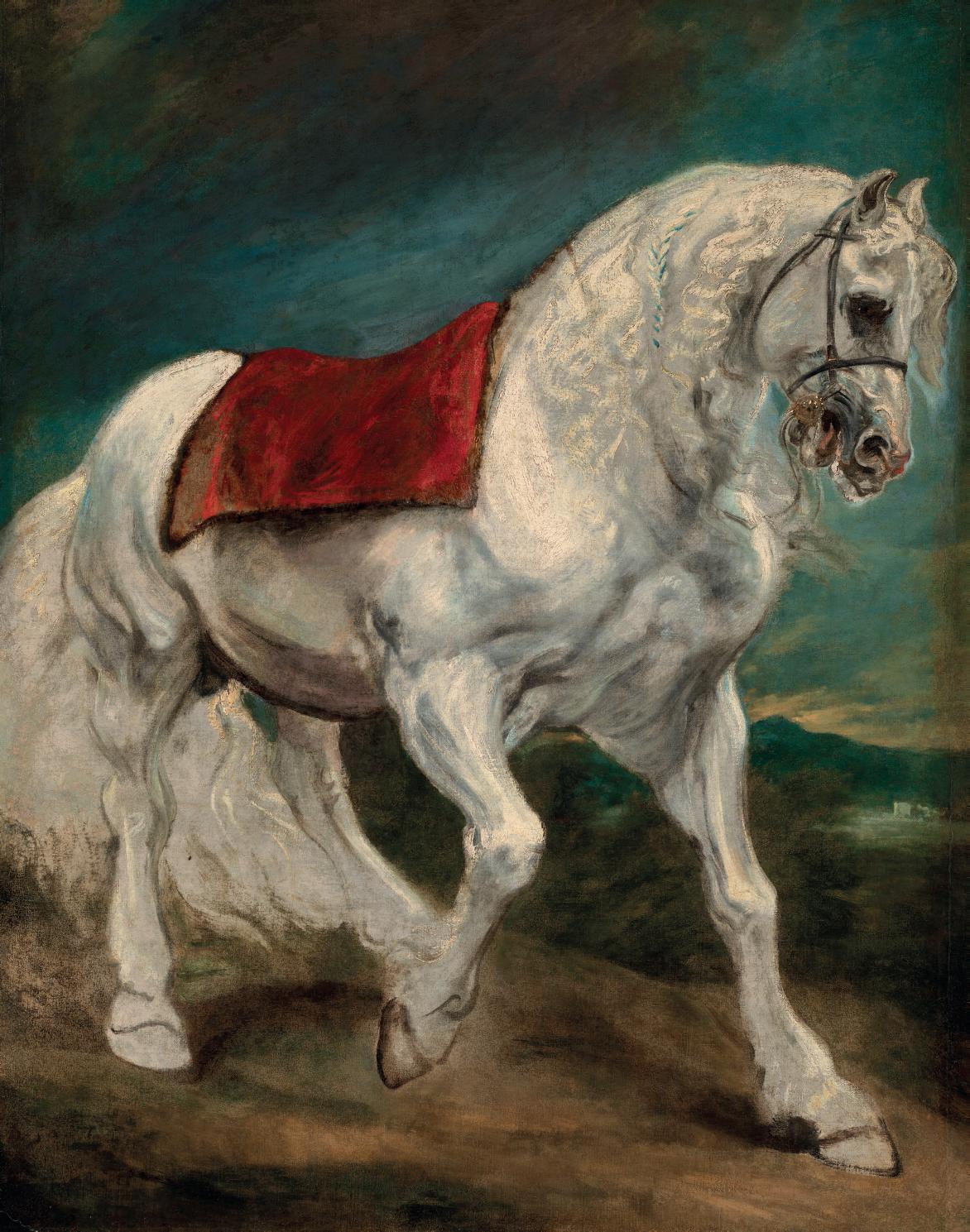


Painted shortly before van Dyck left Antwerp for Italy in the autumn of 1621, this striking picture of an Andalusian stallion constitutes the artist’s first independent grand-scale depiction of a horse. It was executed in preparation for the posthumous equestrian portrait of Emperor Charles V now in the Uffizi, Florence (c. 1621; fig. 1), van Dyck's earliest surviving equestrian portrait in a genre that hastened his reputation as one of the most sought-after portraitists in Europe during the first half of the seventeenth century. The canvas, painted with extraordinary fluency and vigour, provides a thrilling demonstration of the young artist’s virtuoso handling of paint and bravura technique. This is equally true of the sketch on the unprimed reverse – discovered after removal of the relining canvas following the 2000 sale – which, remarkably, stands as the artist's only surviving oil landscape study.
Van Dyck’s canvas – a forceful image of equine power – is a masterful performance in economy; using the prepared grey ground to superb effect, the artist has employed rapidly brushed strokes of dark brown paint to articulate the outline before lavishly applying highlights in lead white to capture the modelling and head of the horse. This expressive use of paint is typical of the artist during his formative years in Antwerp when his works are characterised by a richness and variety of texture that are in striking contrast to the restrained, courtly style that brought the artist such success during his final years in England. Van Dyck’s approach here compares closely with other studies of horses painted from this early period, the finest example of which is the Study of a Soldier on Horseback, dated to circa 1617-18, from Christ Church Picture Gallery, Oxford (present whereabouts unknown; fig. 2).
For the canvas in the Uffizi, van Dyck based his composition on Titian’s celebrated 1548 portrait of Charles V at the Battle of Mühlberg, a work that Rubens had previously studied for his equestrian portrait of The Duke of Lerma, painted in 1603 during the Flemish artist’s first visit to Spain (both pictures are in Madrid, Museo Nacional del Prado; fig. 3). Although the Uffizi picture's compromised state of preservation has given rise to some attributional debate among scholars in the past, Susan Barnes noted that passages clearly resembled van Dyck's work from circa 1621 (op. cit., 2004, p. 95, no. I.101).
While van Dyck was required to turn to earlier portraits for his likenesses of the sitter, he clearly observed the horse itself from nature. The painter’s fondness for the animal is recounted in the much cited anecdote – described by André Félibien in his 1685 biography of the artist – of Rubens presenting van Dyck with one of the most beautiful horses from his stable before his most gifted pupil departed for Italy. After Thomas Gambier Parry acquired the present picture in 1859, he noted that the horse shown was traditionally thought to be that which van Dyck had received from his master. The horse here invites a comparison to Virgil, evoking lines in his Georgics referring to a foal: 'His neck is high, his head clean-cut, his belly short, his back plump and his gallant chest is rich in muscles... Again should he but hear afar the clash of arms he cannot keep his place; he pricks up his ears, quivers his limbs, and snorting rolls beneath his nostrils the gathered fire’ (H. Rushton Fairclough, Virgil with an English Translation, 1928, I, p.161).

In his 2002 Burlington article on this picture, Sir Oliver Millar left open the possibility that it was in fact an earlier version of the Uffizi commission, cut down at a very early stage before being adapted by the artist to a study of the horse. This theory was prompted by the revelation of an armoured rider in an X-ray carried out in 2000, at the time of the restoration treatment undertaken by Simon Folkes in London. Millar further noted that a later hand had ‘tidied up’ passages in the sky and landscape surrounding the horse (ibid.). A small version of the composition at Dulwich Picture Gallery – executed in oil on paper and laid down on panel – has not been discounted as a possible autograph study for the horse and would therefore stand as the first stage in this sequence of works for the Uffizi commission (Millar, 2004, op. cit., pp. 95-6).
The discovery of the landscape on the reverse of the original canvas, revealed following removal of the later relining, marked an important addition to van Dyck’s oeuvre. Painted with the unprimed canvas turned on its horizontal axis, the artist shows a steep tree-covered bank on the left, sloping down to a lake where a dog can be seen drinking. As with its counterpart on the recto, the handling is dazzlingly free. While it is known that van Dyck painted independent landscapes – five are listed in Antwerp collections in the seventeenth century – this is the only surviving oil in the genre from his entire career.
That the artist delighted in studying nature is evident in the many portraits and subject pictures with landscape backdrops or settings, but it is arguably in the group of surviving drawings where his veneration of the natural world is most eloquently expressed. In the introduction to the catalogue for the 1999 exhibition The Light of Nature: Landscape Drawings and Watercolours by Van Dyck and His Contemporaries, Martin Royalton-Kisch observed of van Dyck’s landscapes: ‘Although the accidents of survival must distort the true picture… these notations are set down with a skill and sensitivity to atmosphere that even the most distinguished landscape specialists active in Europe in his day found hard to equal’ (p. 10). It is telling that many of these works on paper, invariably executed in brown ink with brown wash and watercolour, were owned by later artists, including Jonathan Richardson Senior, Thomas Hudson and Joshua Reynolds, as well as collectors such as Richard Payne Knight, celebrated for his theories of picturesque beauty (see lot 21). Interestingly, Payne Knight also owned a grand-scale picture of a rearing stallion by van Dyck (sold in these Rooms, 25 January 2012, lot 12).
Millar noted that the sloping bank crowned with trees is very close to the landscape backdrop in the portrait, now in the Louvre, showing a father and young boy, possibly Joannes Woverius with his son (op. cit., 2002; fig. 4). That the Paris portrait can be dated to circa 1620 strengthens the argument that both sides of the present canvas were executed before van Dyck left Flanders. While Millar conceded that this landscape sketch does not betray a direct link with anything in Rubens’s work, he observed that some elements – the prominent twisting trees and glimpses of water – may well have been inspired by passages from the older artist’s compositions, such as ‘La Charette Embourbée’ and The Watering Place, pictures that both date to the years van Dyck was working in Rubens’s studio (the former c. 1617; St. Petersburg, Hermitage; and the latter c. 1615-22; London, National Gallery). In van Dyck's own work, there is a link in the treatment of the trees, albeit in general terms, with his drawing in the Louvre of A fallen tree, a work that corresponds very closely to a passage in Rubens’s Landscape with a boar hunt of circa 1618 (Dresden; Gemäldegalerie Alte Meister), which van Dyck is thought likely to have assisted with.


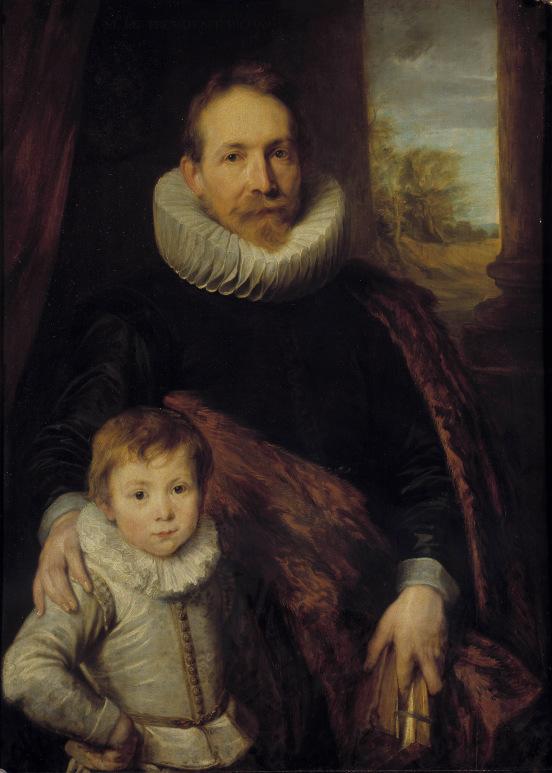
Van Dyck was undoubtedly one of the leading artists in the development of equestrian portraiture; his works in this field not only provide some of the defining images of the seventeenth century but have loomed large in the artistic psyche of subsequent generations. This picture marks his first essay in the genre, one that gained favour with key Genoese patrons such as Anton Giulio Brignole-Sale (1627; Genoa, Galleria di Palazzo Rosso), a commission for which van Dyck also produced a preparatory study of the sitter’s Andalusian horse. The years following van Dyck's return from Italy in the summer of 1627, known as his ‘second Antwerp period’, witnessed a magnificent troop of equestrian portraits, notably those of Albert de Ligne, Prince of Arenberg and Barbançon (1629-32; UK, Private collection), Francisco de Moncada, Marqués de Aytona (1633/4; Paris, Musée du Louvre) and Prince Francis Thomas of SavoyCarignano (1634-5; Turin, Galleria Sabauda), a work aptly described by Julius Held as an ‘icon of power’. It was in England, where he arrived in the spring of 1632, that van Dyck's mastery in this field reached its climax; the celebrated portraits of Charles I on horseback in the Royal Collection and National Gallery of London (1633 and c.1636-7 respectively) stand as two of the outstanding masterpieces from his final years and arguably two of the most famous equestrian portraits in the history of western painting. In 1805, the portraitist John Hoppner observed of the former work, in which the King is shown with his riding master and equerry M. de St Antoine, that ‘a part of one of the hind legs is simply an outline on the bare canvas; yet under the circumstances in which it is seen, it is better, and more truly expressed, then if it had been, in the vulgar sense of the term, finished’ (Oriental Tales, translated into English Verse, 1805, pp. ix-x). Hoppner's words seem equally apposite when confronted with the present study.
Andalusian horses, derived from the original Arab stock, were highly prized by the European nobility from the fifteenth century and have long been associated with the Spanish Hapsburgs. By the sixteenth century, during the reigns of Charles V and Philip II, their status as the finest horses in the world was established, as illustrated through their increasing presence in equestrian portraits of Europe’s princes and monarchs, including that of King Francis I of France (1494-1547). On his wedding to Katherine of Aragon, King Henry VIII of England received Spanish horses from Charles V, Ferdinand II of Aragon and the Duke of Savoy. In 1667, William Cavendish, 1st Duke of Newcastle, the celebrated horse breeder, wrote of the Andalusian horse: ‘He is the noblest horse in the world... the most beautiful that can be... He is of great spirit and of great courage... and is the lovingest and gentlest horse, and fittest for a King in his day of triumph’.
Thomas Gambier Parry assembled a remarkable collection of early Italian Renaissance pictures for Highnam Court, near Gloucester, the house he acquired in 1838 and subsequently rebuilt. A manuscript inventory of the pictures, compiled by Gambier Parry’s son, Ernest, and dated July 1897, states that the picture had been in the collection of the Earls of Pembroke at Wilton, a house celebrated for its holdings of works by van Dyck. On a visit to Highnam Court in 1863, Lady Herbert recognised it as having been among the pictures that went missing from Wilton during the minority of the 12th Earl of Pembroke (b. 1791). However, the absence of any potential candidates in the Wilton inventories suggest this claim was unfounded. The catalogue also states that Gambier Parry acquired the picture before Sir Charles Eastlake had time to secure it for the National Gallery. Gambier Parry’s collection, which included important works by Bernardo Daddi, Lorenzo Monaco, Fra Angelico and Mariotto Albertinelli, survives substantially intact at the Courtauld Institute of Art. The van Dyck – the outstanding northern picture in his collection – can be seen in Henry Jamyn Brook's Private View of the Old Masters Exhibition, Royal Academy, 1888 (1889; London, National Portrait Gallery; fig. 5), where it is hung next to van Dyck's magnificent 1630 full-length portrait of Philippe Le Roy which in turn flanks, along with the pendant of his wife Marie de Raet (both London, Wallace Collection), Rubens' equestrian portrait of The Duke of Buckingham (c. 1625; formerly Earl of Jersey, Osterley Park, destroyed).
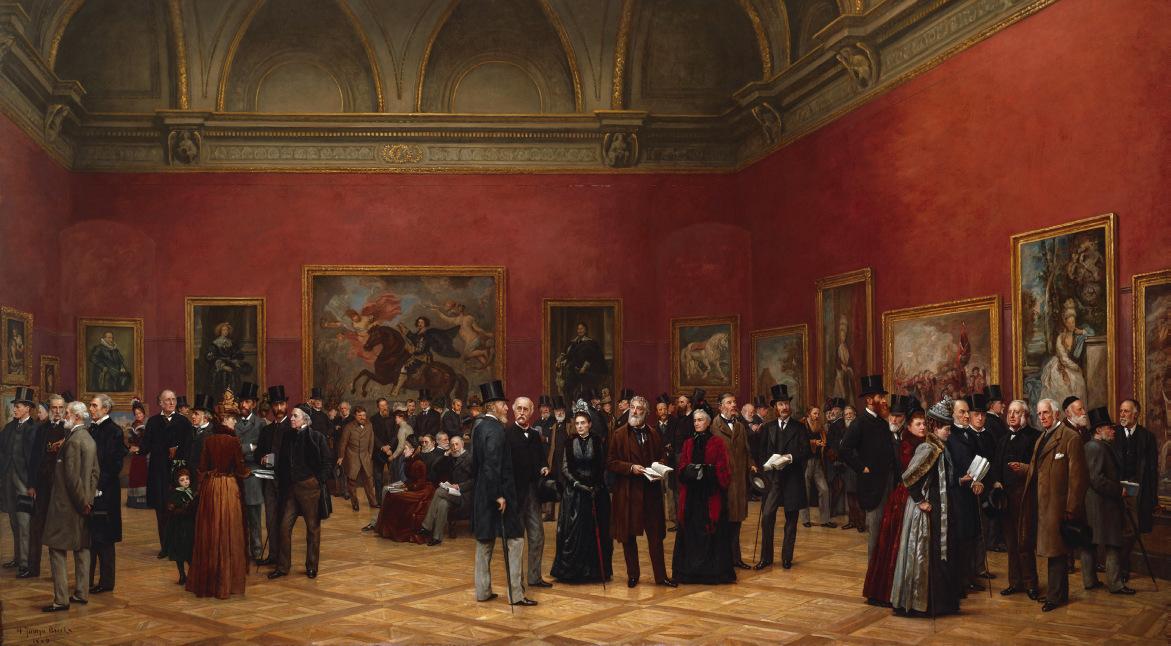
Portrait of Isabella Clara Eugenia (1566-1633), Governess of Southern Netherlands, as a widow, three-quarter-length oil on canvas
50º x 38 in. (127.6 x 96.5 cm.)
£200,000-300,000
US$260,000-390,000
€250,000-360,000
PROVENANCE:
James Jewett Stillman (1850-1918), Paris, and by descent to the following, Isabel Stillman Rockefeller (1876-1935), New York, and by descent to the following, Isabel Rockefeller Lincoln (1902-1980).
Chancey Devereux Stillman (1907-1989).
Lothar Graf zu Dohna (b. 1924).
Acquired by the present owner in 1985.
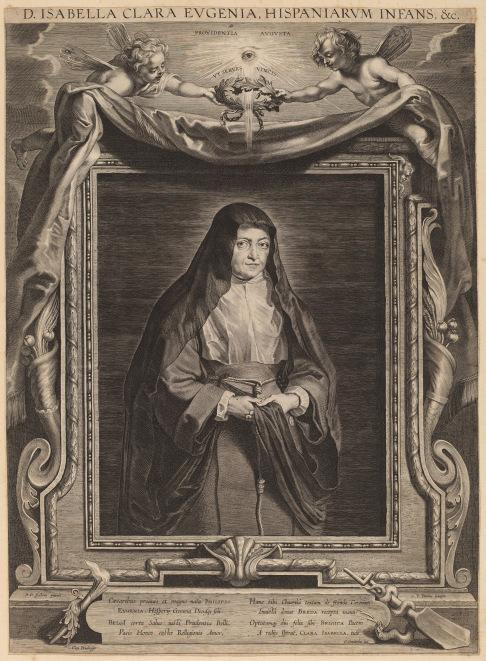
This picture is an important discovery of one of the most renowned - and most reproduced - portraits in Rubens’s oeuvre. It shows Isabella Clara Eugenia, daughter of Philip II of Spain and Elisabeth of Valois. She married Albert, Archduke of Austria, in 1598, and the couple reigned as independent sovereigns of the Spanish Netherlands from 1599 until Albert’s death in 1621, when the territory reverted to the Spanish crown. On account of their childless marriage, Isabella ruled exclusively as governor on behalf of her nephew, Philip IV. In October 1621, she joined the Third Order of St Francis and as a sign of mourning following her husband’s death, she wore the habit of the Poor Clares, as in this portrait. This became her official state portrait for the remainder of her life.
Rubens had been appointed court painter by Isabella and Albert in September 1609, and maintained a close rapport with the Infanta until her death in 1633. Isabella visited Antwerp in 1625, following the capture of Breda in June, a triumphant trip that was well documented by a number of contemporary sources. During this visit, Rubens is known to have painted her portrait and designed a related engraving (fig. 1), where Isabella is shown precisely as she is here: in three-quarter-length pose, holding her long black veil in her hands while she gazes at the viewer, against a neutral background with an aura, likely symbolising Divine Providence, surrounding her head. It is possible that she sat for the portrait during a recorded visit to Rubens’ house on 10 July 1625. The making of the portrait and the engraving are recounted by writers of the time, including Philippe Chifflet and Hermanus Hugo. Chifflet wrote: ‘1625. Rubens peignit l’Infante à Anvers avec una coronne civique sur laquelle M. Gevart fit les vers qui sont dans sa lettre’; while Hugo related: ‘While Isabella was in Antwerp she was painted by the brush of the eminent artist Rubens and engraved in copper by his etching needle, and saw herself adorned with a civic crown in this truly noble picture. After this glorious triumph [the capture of Breda] she deserved to be depicted thus, and by no other hand than that of the famed Apelles; [in the margin] ‘The famous portrait of the victorious Isabella, painted by Rubens’ (H. Hugo, Obsidio Bredana, Antwerp, 1626, p. 125).


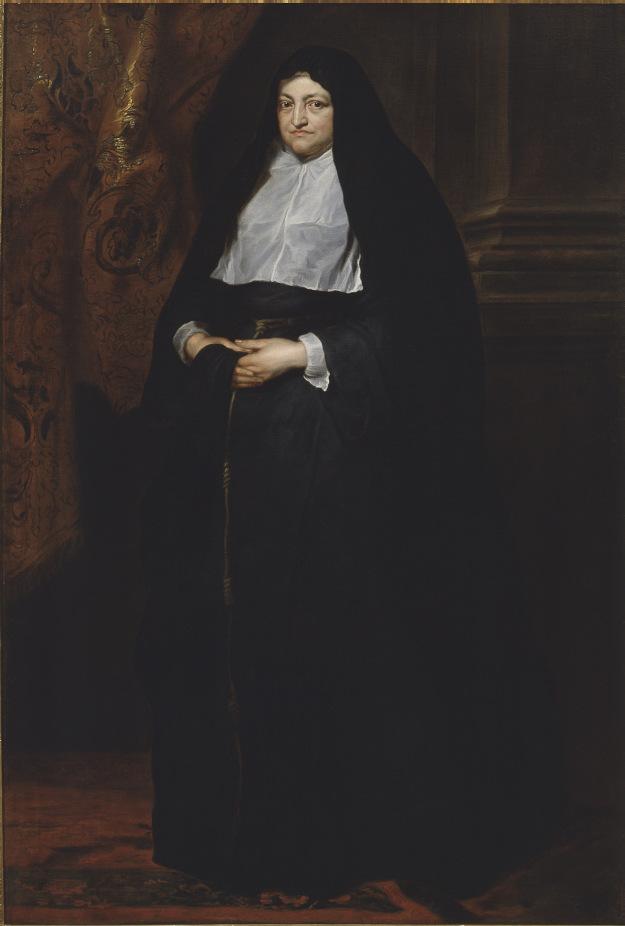
The present, hitherto unpublished, canvas has emerged, after restoration treatment, as one of the most compelling known portraits of this type. There are a number of clear pentiments that are now visible, notably the adjustment of the black veil on her (proper) left, and the repositioning of the fingers on her right hand. Rubens’s typically confident, spontaneous brushwork creates a sense of true volume in the drapery and the modelling of the face lends sharp characterisation to the sitter’s features. Hans Vlieghe discussed the versions previously known in his Corpus volume, including one formerly in the collection of Lord Aldenham, which despite not showing the aura around her head was believed by Burchard to be autograph and the best of the then known versions; this view was however rejected by Vlieghe. Another canvas in the Norton Simon Museum in Pasadena was also given to Rubens by Burchard, an opinion only accepted ‘with much reserve’ by Vlieghe. Interestingly, the Norton Simon picture is smaller than the present lot (116 x 89.5 cm.), as are all of the three further copies listed in the Corpus, each of similar dimensions (116 x 96 cm.; 115 x 85 cm.; 116 x 92 cm.) (H. Vlieghe, Rubens Portraits of Identified Sitters in Antwerp, Corpus Rubenianum, Ludwig Burchard, XIX, London and New York, 1987, pp. 119-123, nos. 109-112, figs. 128-131).
Such was the success of the portrait that van Dyck based his full-length of the Infanta, made circa 1628 (fig. 2; Turin, Galleria Sabauda) very closely on Rubens’s composition. Van Dyck’s portrait was equally acclaimed: he received
from the Infanta a gold chain valued at 750 guilders following its completion. As with Rubens’s canvas, a number of repetitions and copies are known, including a full-length version now in the collection of the Prince of Liechtenstein, that may be identical with the portrait for which van Dyck was paid £25 on 8 August 1632, and three-quarter-length versions formerly in the collections of King Louis XIV of France and Archduke Leopold Wilhelm in Vienna (see S.J. Barnes, N. De Poorter, O. Millar and H. Vey, Van Dyck: A Complete Catalogue of the Paintings, New Haven and London, 2004, p. 319, under no. III.90). Another picture from the studio of van Dyck also recently came to light, formerly in the collection of King Louis-Philippe d’Orléans at Château d’Eu (sold Christie’s, New York, 1 May 2019, lot 245).
This lot was formerly in the collection of James Jewett Stillman (1850-1918), the founder of one of America’s great banking families, the chairman of National City Bank, which later became Citibank. He forged great links with the Rockefellers, with both of his daughters marrying members of the latter family.
We are grateful to Ben van Beneden and Katlijne Van der Stighelen for both endorsing an attribution to Sir Peter Paul Rubens and his studio.
A stack of cheese on a pewter platter, with butter on a plate, a stoneware jug, bread, pretzels, wine in a façon-de-Venise glass and a knife, on a ledge oil on panel 18º x 25Ω in. (46.1 x 64.8 cm.)
£100,000-150,000
US$130,000-190,000
€120,000-180,000
PROVENANCE:
Mrs. Nelson Vandevoort Judah, Los Angeles (according to RKD records). Anonymous sale; Sotheby's, London, 8 May 1974, lot 105. with Thomas Agnew and Sons Ltd, London, 1975. with K. & V. Waterman, Amsterdam, 1981. Private collection, Kiel, and by descent to the following, Private collection, Hamburg.
Anonymous sale; Stahl, Hamburg, 28 April 2018, lot 16, where acquired by the present owner.
EXHIBITED:
Los Angeles, Los Angeles County Museum of Art; Austin, University of Texas Art Museum; Pittsburgh, Carnegie Museum of Art; and New York, The Brooklyn Museum, Women Artists 1550-1950, 21 December 1976-27 November 1977, no. 18.
LITERATURE:
A. Sutherland Harris and L. Nochlin, Women Artists 1550-1950, Los Angeles, 1976, p. 133, no. 18, illustrated.
C. Grimm and I. Bergström, et al., Natura in posa: La grande stagione della natura morta in Europa, Milan, 1977, p. 206, illustrated.
N.R.A. Vroom, A Modest Message as intimated by the Painters of the Monochrome Banketje, II, Schiedam, 1980, p. 103, no. 516. 'Waterman Advertisement', Tableau, January-February 1981, p. 492.
P. Hibbs Decoteau, Clara Peeters, 1594-ca. 1640, and the development of still-life painting in northern Europe, Lingen, 1992, pp. 47, 58, fig. 43, as 'Circle of Peeters'. C.C. Barko, 'Rediscovering Female Voice and Authority: The Revival of Female Artists in Wendy Wasserstein's "The Heidi Chronicles"', Frontiers: A Journal of Women Studies, XXIX, no. 1, pp. 125-6 and 137.

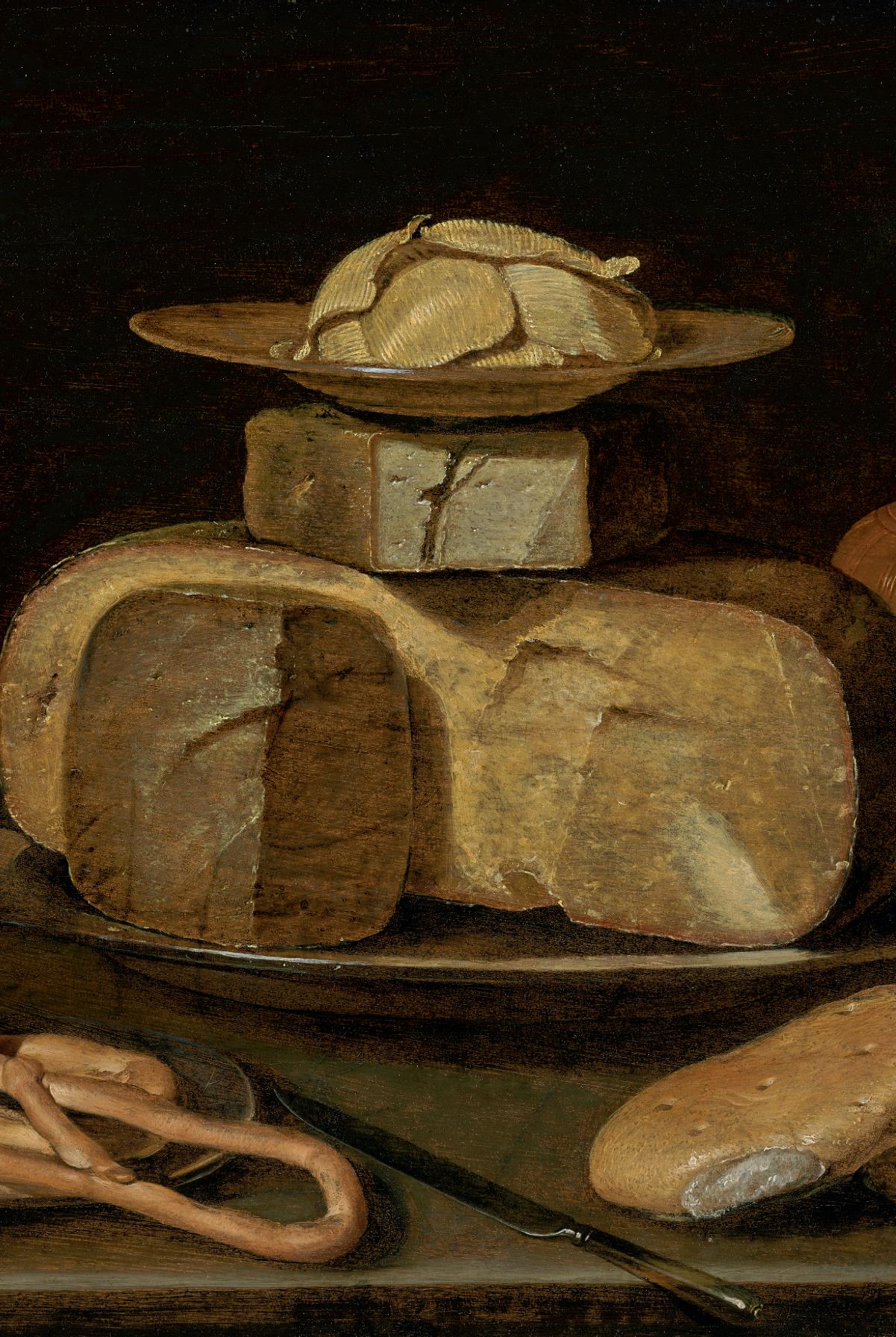
In her Pulitzer Prize-winning play The Heidi Chronicles, Wendy Wasserstein’s protagonist spoke of pictures like the present and how they made Clara Peeters ‘the greatest woman artist of the seventeenth century’: ‘she used more geometry and less detail than her male peers. Notice here the cylindrical silver canister, the disc of the plate, and the triangular cuts in the cheese. Trust me. This is cheese’ (Barko, op. cit. p. 125). Peeters belonged to the first generation of European artists specialising in still-life painting and was one of its most original practitioners in the seventeenth-century Lowlands. Her earliest dated work appeared within six years of the first known food and flower still-life paintings in northern Europe, and she was also in all likelihood the first European artist to paint a fish still-life (1611; Madrid, Museo Nacional del Prado), which would become something of her specialty. As one of the first great female artists, she declared her distinctive artistic personality by discreetly including self-portraits in the reflective surfaces of objects in a number of her works.
Despite her central position in the development of the still-life genre in the Netherlands, biographical details remain scarce, with fewer than forty signed works by her known today. Neither her place nor date of birth is documented, though all available evidence suggests she worked chiefly in or around Antwerp, with at least six of her copper and panel supports bearing the maker’s marks of the city. Equally unknown is when (and whether) she joined Antwerp’s painters guild, from which women were not specifically forbidden, though in practice comparatively few did. However, that Peeters’s name does not appear among the extant records should not be taken as an indication that she was not a member. As Pamela Hibbs Decoteau noted when addressing this issue, the guild lists in Antwerp are missing for the critical years between 1607 and 1628, a period that encompasses the entirety of Peeters’s known activity (op. cit. p. 9).
Peeters used the motif of the cheese stack and dish of butter in six further works, all of which share clear geometric patterns and are viewed from a low vantage point. These include the painting from the Carter collection at the Los Angeles County Museum of Art; Amsterdam, formerly Westermann collection; Amsterdam, Willem Russell collection; The Hague, formerly A. von Welie collection; The Hague, Mauritshuis; and the picture sold in these Rooms, 12 December 2001, lot 6 (£498,750). Knowing the present example only through black and white images, Hibbs Decoteau deemed it a variant of the Russell picture, with compositional differences, and painted by an artist from Peeters’s

circle (op. cit.). Dr. Fred G. Meijer, in concurrence with previous scholarship, most recently reconfirmed Peeters’s authorship (private communication, 2024).
In this still-life genre, which Ingvar Bergström classified as ontbijtes, or ‘breakfast still-lifes’, cheese held a special place, gaining its own particular subgenre. Cheese could be used as a reference to the centrality of dairy products in the agricultural and economic health of the Netherlands, standing as a symbol of national pride and prosperity. It was both a display of gastronomic luxury and a symbol of religious ideas, alluding to overabundance, with a well-known Dutch saying warning: ‘one dairy product upon another is the work of the devil’ (‘zuivel op zuivel is ‘t werk van den duivel’). It was equally regarded as Lenten fare among Protestants, described by the Dutch poet Jacob Westerbaen as ‘a metaphor of the powerful flavour of a simple repast’, particularly when coupled with bread and wine as reminders of the Eucharist.
As here, all of Peeters’s cheese stacks have pride of place in their compositions, and, while each possess their own distinguishing features, they follow a consistent formula. At the base is Gouda, on top of which lies a triangular sheep’s cheese, and in the foreground, a ripe, green, Edam-like cheese, with the shavings of butter always on top. In each cheese can be seen a small carvedout sample suggesting the presence of their taster. Cheeses of this kind, made primarily of cow’s milk, were produced mainly in the province of North Holland and can be recalled in the still-lifes of Haarlem painters like Floris van Dijck (c. 1575-1651), Nicolaes Gillis (c. 1592-c.1632/55) and Floris van Schooten (1585/881656). Peeters seems to have been one of the only painters in the Southern Netherlands to have painted cheese so distinguishably ‘made in Holland’ (see A. Vergara, The Art of Clara Peeters exhibition catalogue, Antwerp and Madrid, 2016, p. 50).
Peeters exchanged the rich colour of her early works for more humble tones, rendering the textures and surfaces of objects with evident relish. Describing the stack of cheese and butter with particular brio, she uses thick impasto in the highlights and extraordinary subtlety in the rendering of the grooves in the surfaces, at once making them tangible and consumable objects. Bright light from the left creates brilliant accents on the glass, jug, butter and pretzels, offset against the earthy brown of the ledge, while the red currants and yellow and white tones of the cheese and bread draw attention to the silver platters and knife, which balances precariously over the edge of the ledge to reinforce the impression of depth. Peeters employed a standard repertoire of objects in her compositions, including the present façon-de-Venise glass, which can be seen in the Westermann and Russell cheese stacks, as well as in the picture sold in these Rooms in 2001, and the stoneware Raeren jug, which also features in the Mauritshuis picture at a different angle (fig. 1) and the Still life with an artichoke (Germany, Private collection; Hibbs Decoteau, op. cit. no. 21).
Absent any definitive documentary information about Peeters’s life, the works themselves provide the clearest evidence for reconstructing her painterly activities. Eleven dated works allow for something of a chronology to be developed, which show general tendencies towards an ever-increasing command over the drawing of objects and an ever-lower vantage point from which they are viewed. While none of Peeters’s ‘cheese stack’ paintings are dated, they have traditionally been placed in the artist’s maturity. Hibbs Decoteau, Ann Sutherland Harris and Linda Nochlin argued for a dating of the group to the late 1620s and early 1630s, when the artist’s style moved away from the highly finished, vibrant compositions of her earlier pictures towards the ‘monochrome banketje tradition that evolved in Haarlem with Pieter Claesz. (1597-1624) and Willem Claesz. Heda (1593-1680) in the second quarter of the seventeenth century (op. cit.). Recent scholarship, however, has reassessed this dating, placing works in the group to an earlier period, from circa 1612 to 1621, the year that the last document referred to her as an active artist (see Vergara, op. cit., nos. 14 and 15). Yet given the paucity of details regarding Peeters’s life and activities, any dating remains hypothetical.

The Crucifixion
tempera on gold ground panel, in a later engaged frame, arched top 11 x 9¿ in. (28 x 23 cm.)
£80,000-120,000
US$110,000-160,000
€96,000-140,000
PROVENANCE: with Moretti Galleria d'Arte, Florence, by November 2011, where acquired by the present owner.
This is a characteristic work by one of the more productive Sienese masters in the orbit of Duccio di Buoninsegna, who was subsequently influenced by Simone Martini and Ugolino di Nerio. Active in the opening decades of the trecento, the master takes his name from the Maestà in the monastery of Monte Oliveto Maggiore, east of Siena, which G. de Nicola associated with a number of other pictures in 1912. His oeuvre has subsequently been considerably enlarged by Cesare Brandi, to whom his soubriquet is due, and Gertrude CoorAchenbach, James Stubblebine and other scholars. Stubblebine (Duccio di Buoninsegna and his School, Princeton, 1979, I, p. 92) believed his was ‘a oneman operation’ and that there was ‘insufficient evidence’ that he ‘had assistance’. In design, this panel conforms closely with the treatment of the figure in a series of representations of the crucifixion by the master (op. cit., II, figs. 219, 211, 213, 214 and 217), but such details as the diagonal folds of the loincloth distinguish it from these.
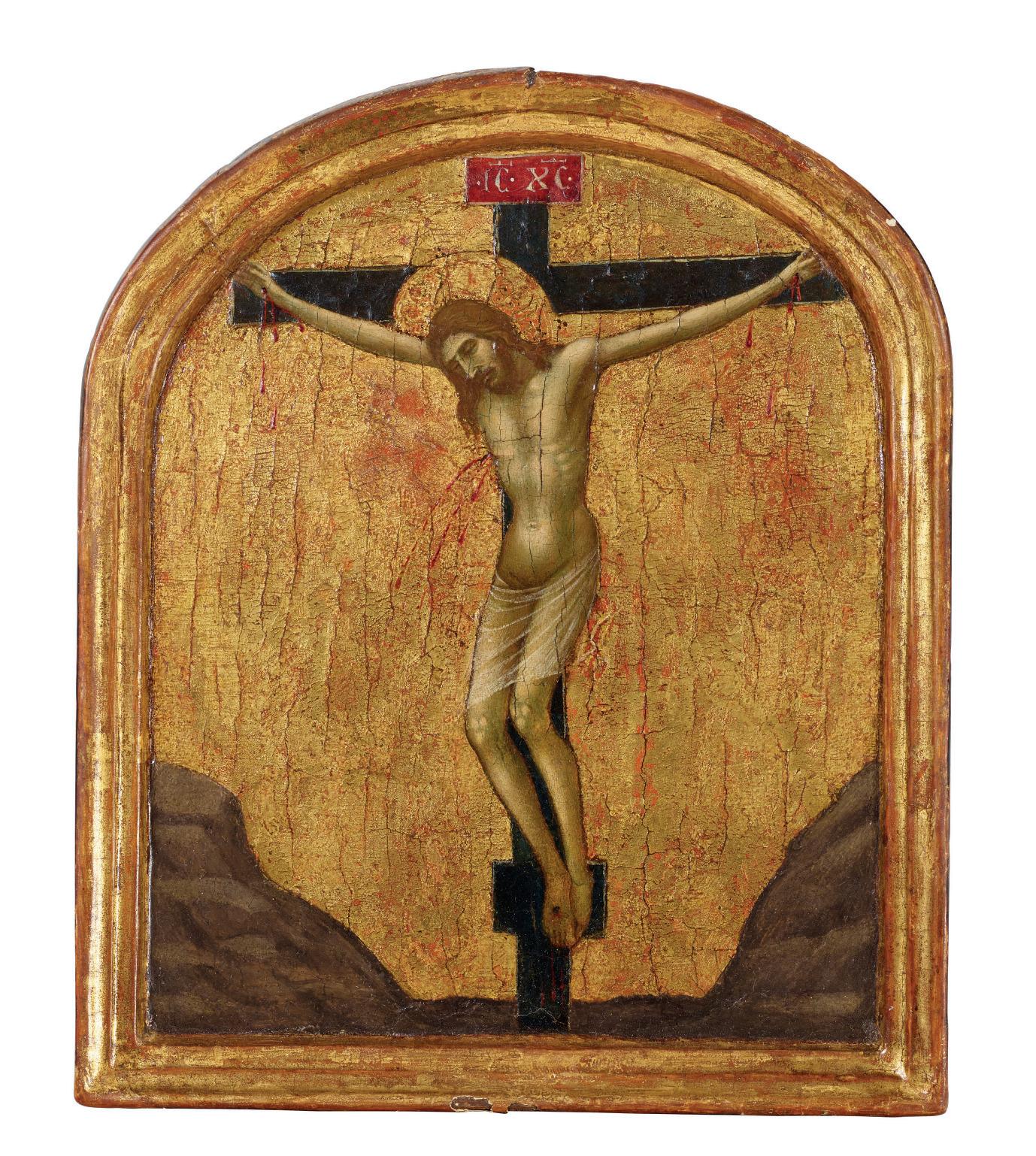
PROPERTY OF CARITAS OF THE ARCHDIOCESE OF
The Cesarini Venus
bronze; on an integrally cast square plinth and on a square ebonised wood base; the underside of the base with two paper labels, one inscribed 'M / 660', the other '400' 13º in. (33.5 cm.) high; 19Ω in. (49.5 cm.) high, overall
£200,000-300,000

US$260,000-390,000
€250,000-360,000
PROVENANCE:
Private collection, Austria, until 2024, when bequeathed to the present owners.
EXHIBITED:
Very likely the example exhibited in De Triomf van het Maniërisme: een Europese stijl van Michelangelo tot El Greco, Rijksmuseum, Amsterdam, July - October 1955, p. 162, no. 303.
COMPARATIVE LITERATURE:
J. von Schlosser, Werke der Kleinplastik in der Skulpturensammlung des A. H. Kaiserhauses, Vienna, I, 1910, p. 10.
C. Avery and A. Radcliffe, eds., Giambologna (1529-1608): Sculptor to the Medici, London, 1978, p. 62.
C. Avery, Giambologna: The Complete Sculpture, Frome, Somerset, 1987, pp. 97-107, 254, no. 12.
A. Radcliffe, Giambologna's Cesarini Venus, exhibition catalogue, Washington, D.C., 1993, pp. 15-16.
A. Radcliffe, 'Giambologna's "Venus" For Giangiorgio Cesarini: A Recantation, La Scultura: Studi in Onore Di Andrew S. Ciechanowiecki, A. González-Palacios, II, 1996, p. 64.
S. Sturman, 'A Group of Giambologna Female Nudes: Analysis and Manufacture,' Small Bronzes in the Renaissance, New Haven and London, 1998, pp. 131, 133.
M. Leithe-Jasper and P. Wengraf, European Bronzes from the Quentin Collection, exhibition catalogue, New York, 2004, pp. 146-157, no. 12.
W. Seipel, ed., Giambologna: Triumph des Körpers, exhibition catalogue, Vienna, 2006, no. 21, pp. 15-19, 196-198, 203.
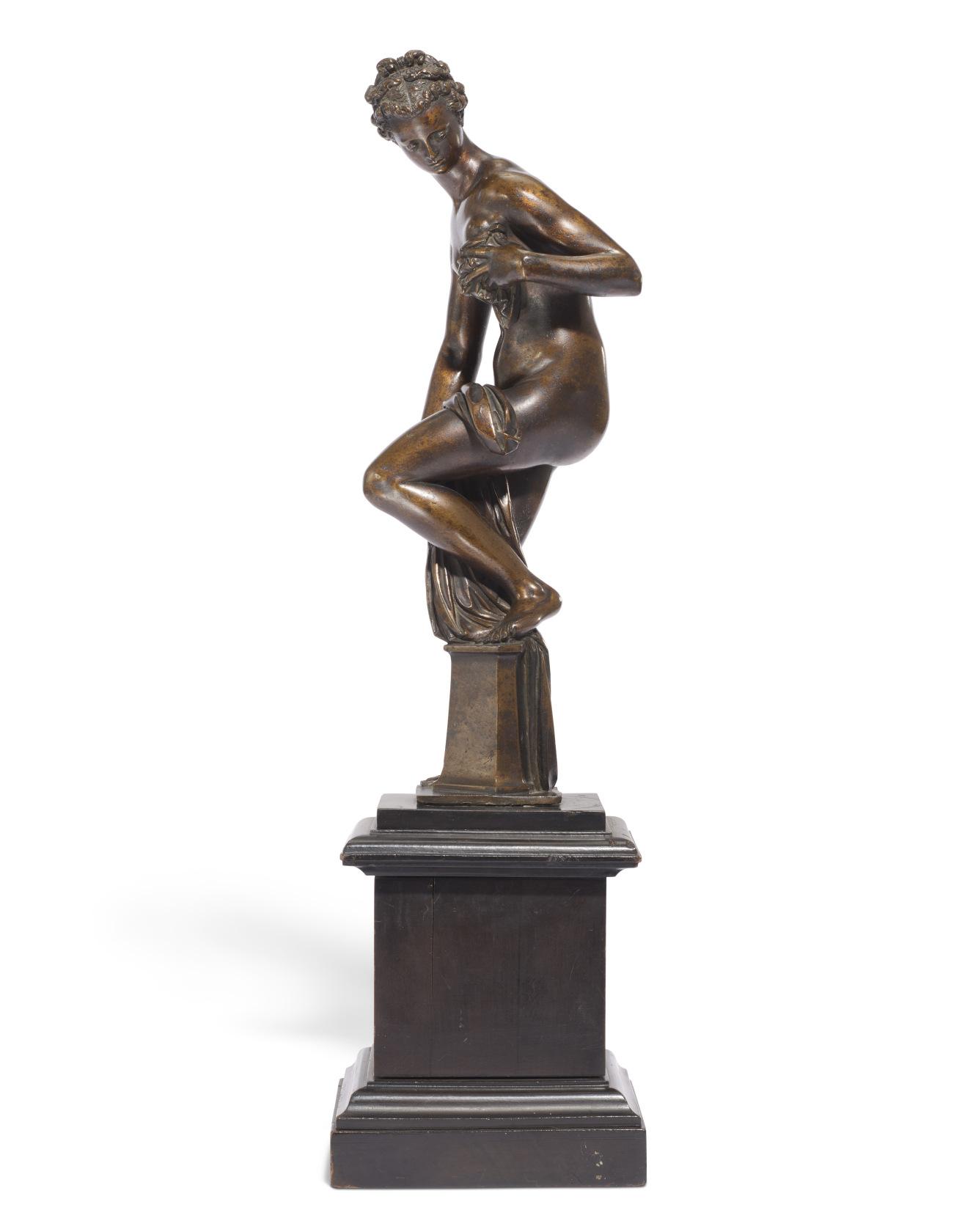
This bronze is an exceptional example of the work of master Renaissance sculptors Giambologna (1529-1608) and his principle assistant Antonio Susini (fl. 1580-1624). Many of Giambologna’s most celebrated compositions are believed to have been executed by Susini, combining the former’s ingenious compositions with the latter’s unparalleled technical ability in bronze production. Their combined talents are exemplified in this cast of the Cesarini Venus which records the overall, mannered, posture of the figure alongside fine details such as the plaits of hair, her elongated fingers and her carefully delineated toenails.
Tabletop bronzes like the present lot were in high demand among wealthy patrons in the late sixteenth and early seventeenth centuries and were often given by the ruling Medici family as diplomatic gifts. To meet this demand, Giambologna trained a series of assistants who assimilated his style and were able to execute bronzes from the master's models. Antonio Susini is known to have trained and worked in Giambologna’s foundry between circa 1580 and 1600, and specialised in preparing moulds of Giambologna’s models for casting and finishing these statuettes when cast (Avery, 1978, op. cit., p. 157). After 1600 he left to work independently, becoming successful in his own right. He continued to cast bronzes from models by his former master in addition to creating his own original compositions. Even after he set up on his own, Susini’s style remained very close to that of Giambologna meaning that it is not always easy to distinguish between the sculptures of the assistant and those of the master as their works are both stylistically and compositionally intertwined.
The composition of the present lot is related to a marble figure carved by Giambologna in Florence in the period 1580-1583, today known as the Cesarini Venus. A letter dated 28 July 1580 records that Grand Duke Francesco I de' Medici promised Giangiorgio II Cesarini, Marquis of Civitanova, that he would allow Giambologna - the most brilliant artist of his court - to undertake the carving of a marble statue for the Villa Ludovisi, Cesarini's palace in Rome, as soon as the sculptor had completed all his existing commissions (Wengraf in Seipel, op. cit., p. 118). On 9 April 1583 the Duke of Urbino’s ambassador Simone Fortuna wrote to Duke Francesco Maria II della Rovere, stating that the sculptor had the figure of Venus in hand (‘fra mano’), suggesting that the sculpture was then in the process of being carved (Radcliffe, 1996, op. cit., p. 60). Presumably completed in 1583, it was installed in the Villa Ludovisi. It eventually found its way to another Ludovisi property, the Villa Margherita, today the home of the American embassy, where it stands today.
The dating of this group of bronzes, and their relation to Giambologna’s marble figure, has long been the subject of debate. They come in two distinct sizes: a group of smaller examples including the signed bronze in Vienna which measures 24.8 cm, and a larger size – including the present bronze – which measures between 33 and 34 cm. In 1584, Giambologna's biographer Raffaello Borghini described a diplomatic gift from Cosimo I de’ Medici to Emperor Maximillian II in 1565 of ‘una figurina pur di metallo’ which von Schlosser associated with the bronze model of Venus Drying Herself in Vienna (Schlosser, loc. cit.). This assumption led scholars to conclude that the bronzes had to pre-date the marble Venus and that for Cesarini’s commission Giambologna transformed a small model he made twenty years earlier into a life-size marble. This would be in direct contrast to his usual practice, which involved the creation of small bronzes based on his large-scale marbles (Radcliffe, 1996, loc. cit.). However, as Radcliffe has argued (ibid.), at the time of Cesarini’s commission Giambologna was exceptionally busy and re-working an earlier model would have been a significant time-saving device.
Some scholars have continued to question whether Giambologna would have been content to reproduce an old model for one of his more important
commissions. Previous translations of Borghini’s note of ‘a female figure also of metal’ (Wengraf in Seipel, op. cit., p. 118) may also be misleading, as ‘figurina’ literally translates into English as 'figurine’ and is therefore not gender specific. It should also be noted that the signed Venus in Vienna only appears with certainty in an inventory of 1730, though it may be identifiable with entries in very early seventeenth-century inventories.
Although the early provenance for the present lot is not known there are several descriptions of the composition in sixteenth- and early seventeenthcentury inventories which could describe the present bronze. For example, in 1586 Ferdinando de’ Medici sent Emperor Rudolf 'Una Venere di mano di Giovanni Bologna, simile a quella del S.or Cesarini’ (‘a Venus from the hand of Giambologna similar to that of Signor Cesarini’). By the 1607-1611 inventory of Rudolf’s Kunstkammer, the Emperor had seemingly acquired a second cast. A third cast of this model is also recorded in inventories of the Villa Medici in 1588 and 1671 (Wengraf in Seipel, op. cit., pp. 118-120).
It has been argued that, stylistically, the model for the ‘Cesarini’ Venus fits best into Giambologna’s oeuvre in the 1560s (Leithe-Jasper in Seipel, op. cit., p. 203, and Radcliffe, op. cit.). However, there is a general consensus that the larger group of bronzes of this subject was probably cast by Antonio Susini and the model was therefore created around the time of the carving of the large-scale marble – that is, in the 1580s (ibid., p. 199). Some believe that the larger model represents an evolution of the composition, with its slightly more elongated proportions and greater sense of torsion.
As noted by Avery (op. cit., no. 52, p. 259), this model was among Giambologna’s most popular compositions and there exist many examples from later foundries of the seventeenth, eighteenth and nineteenth centuries. Wengraf and LeitheJasper have discussed the variant models and divided them into types ‘A’, ‘B’, ‘C’ and ‘D’. The present bronze corresponds broadly to type ‘C’, that is, the larger model but on a square plinth. Other examples from this group include the bronze from Anglesey Abbey (National Trust, Fairhaven Collection) and the example in the Quentin Collection (Leithe-Jasper and Wengraf, op. cit., p. 146). Although the authors suggest that most of these bronzes probably date from the second and third quarters of the seventeenth century, there is an important distinction to be noted regarding the present example. As discussed in the entry of the Quentin bronze, the marble example of the Cesarini Venus was originally displayed outdoors and was badly damaged at some point before 1616 (Radcliffe, op. cit., p. 70). During the restoration, which was largely confined to the lower sections but also the top of the head, the area of the hair within the circular section formed by the intertwined plaits was altered from a central parting with hair combed out to both sides, to hair combed directly down from the front of the head to the back. They argue convincingly that the rare number of bronzes with the central parting must pre-date the restoration of the marble, which took place before 1624 (ibid., p. 154). The much more common bronzes with the hair combed from front to back therefore post-date the restoration. This would place the bronze offered here among the rare examples cast in the late sixteenth and very early seventeenth centuries. The relative freedom of details such as the naturalistic curls of hair framing the forehead of this figure would suggest a relatively early dating in Susini’s time with Giambologna – perhaps in the 1580s or 1590s; his later casts seem to become more rigid and goldsmith-like in their finishing.
With its lustrous reddish-gold patina and its exquisite details, the present bronze represents an exciting discovery in the world of late Renaissance bronzes. It is perhaps notable that it has appeared from a collection in Austria, where the Hapsburg dynasty represented one of Giambologna’s greatest and most enduring patrons.

The Crucifixion with the Virgin, Mary Magdalene, John the Evangelist and a Franciscan Saint tempera on gold ground panel, in its original engaged frame 16¿ x 10º in. (40.9 x 26 cm.) with its original painted reverse
£80,000-120,000
US$110,000-160,000
€96,000-140,000
PROVENANCE:
Achillito Chiesa (1881-1951), Milan, by 1926; his sale, American Art Association, New York, 16 April 1926, lot 12, as 'Pietro Lorenzetti', when acquired for $5,600 by the following, with Ercole Canessa, New York and Naples. with Albrighi, Florence, 1946-1950. with Frascione, Florence, 1950. with Wildenstein and Co., New York, by 1974, where acquired by the following, Private collection, New York, from whom acquired by the present owner in circa 2018.
EXHIBITED:
London, Helikon Gallery, Exhibition of Old Masters, June-September 1974, no. 1, as 'Pietro Lorenzetti'.
LITERATURE:
'Chiesa Paintings', Art News, XXIV, 24 April 1926, p. 11, no. 12.
E.T. Dewald, Pietro Lorenzetti, Cambridge Mass., 1930, p. 38.
R. Longhi, 'Una Crocefissione di Pietro Lorenzetti', Paragone, II, no. 23, November 1951, pp. 26-27, pl. 15, as 'Pietro Lorenzetti', dated 1330-1335.
M. Meiss, 'Nuovi dipinti e vecchi problemi', Rivista d'Arte, XXX, 1955, p. 135, under note 40.
B. Nicholson, 'Current and Forthcoming Exhibitions', The Burlington Magazine, CXVI, July 1974, p. 418.
T. Crombie, 'Round the Galleries: Highlights from Helicon', Apollo, C, August 1974, p. 156, fig. 1, as 'Pietro Lorenzetti'.
E. Skaug, 'Notes on the chronology of Ambrogio Lorenzetti and a new painting from his shop', Mitteilungen des Kunsthistorischen Institutes in Florenz, XX, 1976, p. 313, under note 40, as an anonymous pupil of Lorenzetti.
M. Seidel, 'Das Frühwerk von Pietro Lorenzetti', Städel-Jahrbuch, VIII, 1981, pp. 79-158.
G. Chelazzi Dini, in Il gotico a Siena, exhibition catalogue, Florence, 1982, p. 253, as 'Pietro Lorenzetti', dating to just before 1335.
M. Boskovits, 'Considerations on Pietro and Ambrogio Lorenzetti', Paragone, XXXVII, no. 439, September 1986, p. 5, under note 10, as 'Pietro Lorenzetti'.
M. Laclotte, 'Quelques tableautins de Pietro Lorenzetti', "Il se rendit en Italie": Etudes offertes à André Chastel, Rome, 1987, p. 31, as 'Pietro Lorenzetti', dating between 1330-1335?.
C. Volpe and M, Lucco, eds., Pietro Lorenzetti: L'opera Completa, Milan, 1989, pp. 209-210, no. A28, as an artist very close to Pietro Lorenzetti.
M.J. Frinta, Punched Decoration on late Medieval Panel and Miniature Painting, I, Prague, 1998, p. 114, no. Ca15, as 'close to Lorenzetti (Simone de Gheri?)'.
M. Boskovits, ed., The Alana Collection: Italian Paintings from the 13th to the 15th Century, Florence, 2009, pp. 167-171, no. 29, illustrated, with catalogue entry by A. Labriola.
The workshop of Pietro Lorenzetti was one of the most important in Siena in the early fourteenth century. Pietro and his brother Ambrogio were responsible for many key commissions in the city, including the now lost frescoes that decorated the Ospedale della Scala.
This panel, which has been extensively published and the subject of much scholarly debate, would likely have been part of a diptych, and may have been painted circa 1330-35. A slightly later date however is suggested by the punchwork, with its intricate tooling that is complex in its design and highly skilled in its execution. Notwithstanding the exceptional tooling and the high quality of the figures, in particular the expressivity of the two figures kneeling at the base of the Cross, opinion has been divided on the panel’s attribution. Some scholars, including Millard Meiss, Carlo Volpe and Erling Skaug judged that it was by an artist in the circle of Pietro and Ambrogio Lorenzetti. It was most recently published in 2009 by Ada Labriola as by Pietro, a view that was also shared by Ernest DeWald, Roberto Longhi, Michel Laclotte, Giulietta Chelazzi Dini and Miklós Boskovits. The last of these published the panel in 1986, comparing it to the figure of Christ in both the fresco in the basilica of San Francesco in Siena, of circa 1330, and the Crucifixion with the Virgin, Saints John the Evangelist, Clare and Francis, made around 1320, now in the Harvard Art Museums, Boston. Gaudenz Freuler, who has inspected the painting recently in the original and to whom we are grateful, believes that Pietro himself may have had a hand in the execution of this work. Debate has also surrounded the identification of the figure to the lower right of the cross. Longhi, in 1951, suggested that it might represent Saint Monica, Saint Clare or Saint Scholastica, however it has since been proposed that she is Saint Elizabeth of Hungary.

A smoker lighting his pipe
signed 'G: Metsü.' (on the table edge, lower right) oil on panel
9¿ x 8¡ in. (23.2 x 21.2 cm.)
£200,000-300,000
US$260,000-390,000
€250,000-360,000
PROVENANCE:
Anonymous sale [Lenglier]; his sale, Lebrun a.o., Paris, 24-27 April 1786, lot 80 (FF 1,100). Anonymous sale; Saubert, Paris, 25 March 1793, lot 55, as 'L'intérieur d'un appartement où l'on voit un homme vêtu d'un habit brun et linge blanc rabattu sur le col, la tête couverte d'un chapeau. Il est assis devant une table et allumant sa pipe; à côté est un réchaux, un verre, un bocal et un linge. Ce tableau, qui est d'une touche legère et savante, est du beau faire de ce maître. Haut. 9 pouces, larg. 8 pouces et demi'.
Féréol Bonnemaison (1766-1827), Paris; his sale, Lebrun a.o., Paris, 15-17 July 1802, lot 92 (FF 500 to Bouteville).
(Possibly) J.S. Lazarus, Elisabeth’s Cottage, George Green, Langley Park, Buckinghamshire (according to Waiboer, op. cit.). with John Mitchell, London, by 1957, from whom acquired by the following, Private collection, and by descent; [The Property of a Private Collector]; Christie’s, London, 3 July 2012, lot 13, where acquired by the present owner.
EXHIBITED:
Boston, Museum of Fine Arts, February-May 2014, on loan.
LITERATURE:
J. Smith, A Catalogue Raisonné of the Works of the Most Eminent Dutch, Flemish, and French Painters, IV, London, 1833, p. 109, no. 118, as ‘A Portrait of the Artist’. (Possibly) E.W. Moes, Iconographia Batava: Beredeneerde lijst van geschilderde en gebeeldhouwde portretten van Noord-Nederlanders in vorige eeuwen, II, Amsterdam, 1905, p. 95, no. 5005, no. 11.
C. Hofstede de Groot, A Catalogue Raisonné of the Works of the Most Eminent Dutch Painters of the Seventeenth Century, I, London, 1908, p. 325, no. 230a, as a self-portrait. H. van Hall, Portretten van Nederlandse beeldende kunstenaars, Amsterdam, 1963, p. 207, no. 4, as a self-portrait.
S.J. Gudlaugsson, ‘Kanttekeningen bij de ontwikkeling van Metsu,’ Oud Holland, LXXXIII, 1968, pp. 19 and 25, fig. 8.
F.W. Robinson, Gabriel Metsu (1629-1667): A Study of his Place in Dutch Genre Painting of the Golden Age, New York, 1974, p. 48, fig. 112.
A.E. Waiboer, Gabriel Metsu Life and Work: A Catalogue Raisonné, New Haven and London, 2012, pp. 61 and 198, no. A-52, illustrated.
A.E. Waiboer, ‘Gone up in Smoke? Gabriel Metsu’s “Missing” Self-Portrait with a Pipe,’ E. Buijsen, C. Dumas and V. Manuth, eds., Face Book: Studies on Dutch and Flemish Portraiture of the 16th-18th Centuries, Leiden, 2012, pp. 313 and 315, fig. 5.
ENGRAVED:
W. Pether, 1768.

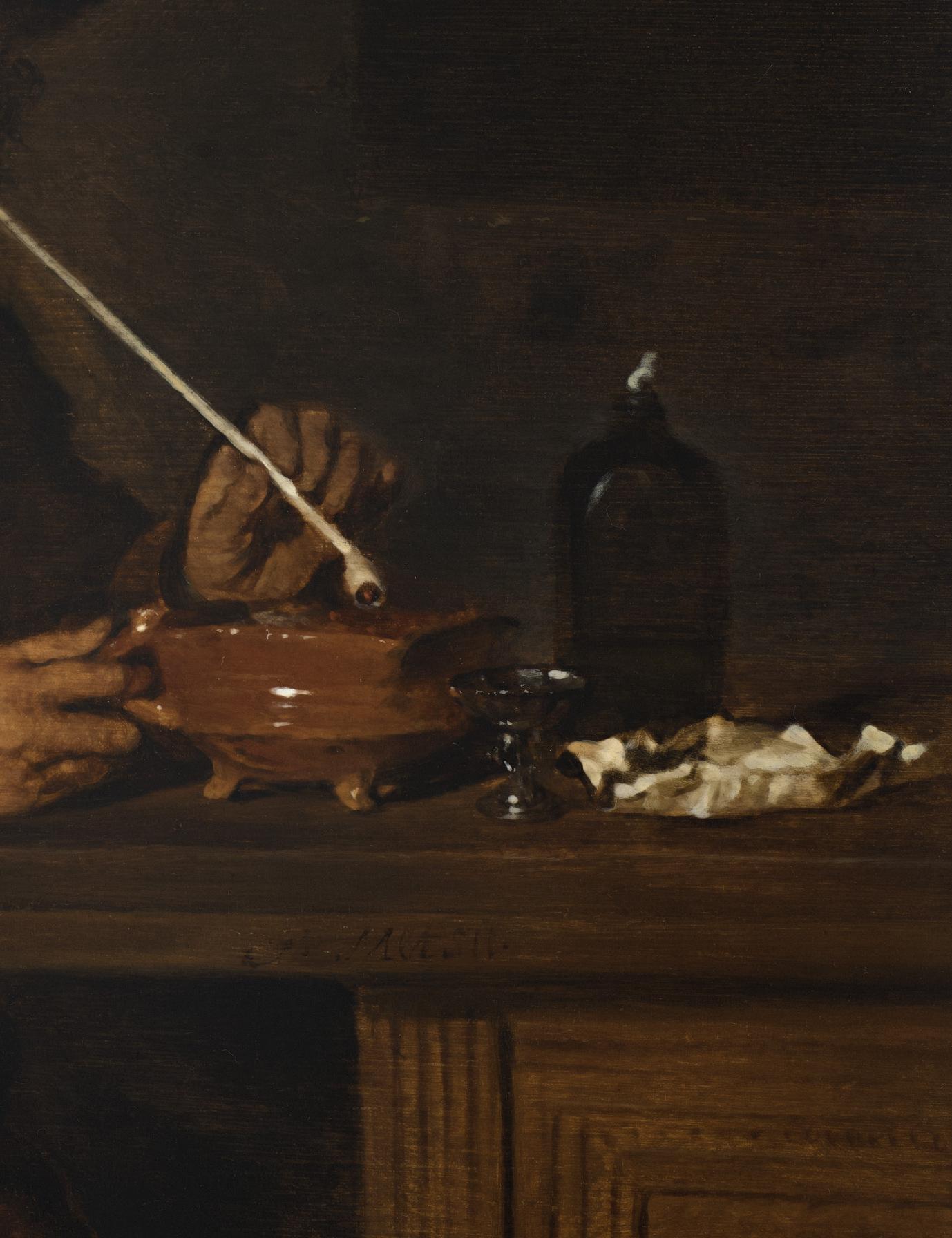
Gabriel Metsu was a founding member of the Guild of Saint Luke in Leiden, a city known for its fijnschilders ('fine painters'), so named on account of their meticulous manner of painting. Around 1650, Metsu probably spent time in Utrecht, as his paintings from this period resemble the works of Utrecht artists Nicolaus Knupfer and Jan Baptist Weenix. In 1657, he settled in Amsterdam, painting scenes of elegant young women in rich interiors in the vein of Gerard ter Borch and – less frequently – rough-hewn figures, among them several images of smokers.
Adriaan Waiboer has noted that, much like Gerrit Dou, men feature far less prominently in Metsu’s work than women (op. cit., p. 61). Moreover, the present painting is one of only two known examples of single male figures painted in the artist’s early years in Amsterdam. The other depicts an officer engaged in the same activity (fig. 1; Salzburg, Residenzgalerie). Much like Metsu’s paintings of elegant women in interiors, these two works display the influence of ter Borch’s smokers painted earlier in the decade. However, unlike ter Borch, Metsu’s smokers are solitary figures removed from the company of others.
In the seventeenth century, images of smokers evoked vanitas associations, with the rapid diffusion of smoke suggestive of the transience of life. In this painting, Metsu suppressed any overt narrative, emphasising instead the studied naturalism of the scene. He has carefully delineated the line of the man's mouth clenching his pipe and the tension in his wrist. Metsu frequently relished depicting such details, which lend his works a true-to-life appearance. For example, a picture of a smoker now in the Rijksmuseum, Amsterdam (inv. no. SK-A-250), includes a barrel bearing the symbol of the Red Stag, a tavern near Metsu's home on the Prisengracht (see L. Stone-Ferrier, 'Gabriel Metsu's Vegetable Market at Amsterdam: Seventeenth-Century Dutch Market Paintings and Horticulture', Art Bulletin, LXXI, 1989, p. 448). In this panel, the man’s coat and wooden chair are identical to that of the Rijksmuseum picture, suggesting it may also have been based on the artist’s immediate surroundings. It is perhaps on account of the painting’s verisimilitude that several earlier scholars – including Smith (1833), Hofstede de Groot (1908) and van Hall (1963) – erroneously considered the man to be a self-portrait. However, his features bear little resemblance to the artist’s two known self-portraits, the Self-Portrait as a Painter in the Royal Collection and the Self-Portrait with a Pipe, last seen with the dealers Boehler and Steinmeyer in Lucerne in 1921 (see Waiboer, op. cit., nos. A-49 and B-17).


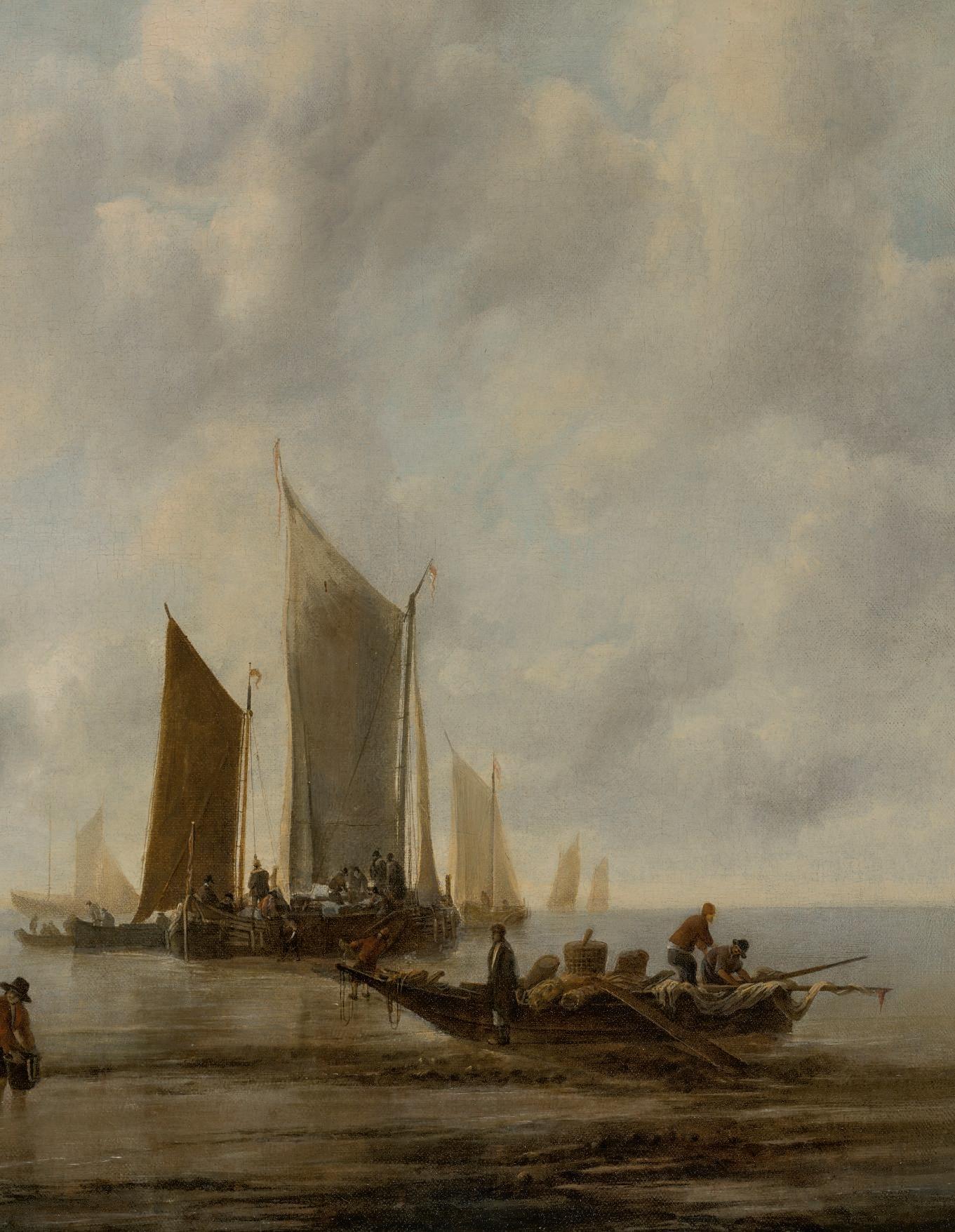
A calm with fishing boats and figures on a jetty signed and dated 'I.V. Cappelle 1651' (lower left) oil on canvas
19¬ x 29√ in. (49.7 x 76 cm.)
£150,000-200,000
US$200,000-260,000
€190,000-240,000
PROVENANCE:
with Martin H. Colnaghi, by 1892. with Brunner Gallery, Paris, 1920.
Dr. E. Guinle, Casa Guinle, Rio de Janeiro; Christie's, London, 28 July 1926, lot 27 (unsold).
with Thomas Agnew & Sons, Ltd (according to RKD research files).
Major-General Sir Harold A. Wernher (1893-1973); (†) Christie's, London, 27 June 1975, lot 75.
with Leonard Koetser Gallery, by November 1975.
Anonymous sale [Property of the Executors of a Deceased's Estate]; Sotheby's, London, 3 December 1997 (=1st day), lot 86, where acquired by the present owner.
EXHIBITED:
London, Royal Academy, Exhibition of Works by the Old Masters, January-March 1892, no. 63 (lent by M.H Colnaghi).
LITERATURE:
C. Hofstede de Groot, A Catalogue Raisonné of the works of the Most Eminent Dutch Painters of the Seventeenth Century, VII, London, 1923, p. 188, no. 116.
W.R. Valentiner, 'Jan van de Cappelle', The Art Quarterly, IV, Autumn 1941, p. 296, under note 1.
M. Russell, Jan van de Cappelle 1624/6-1679, Leigh-on-Sea, 1975, p. 77, no. 116.
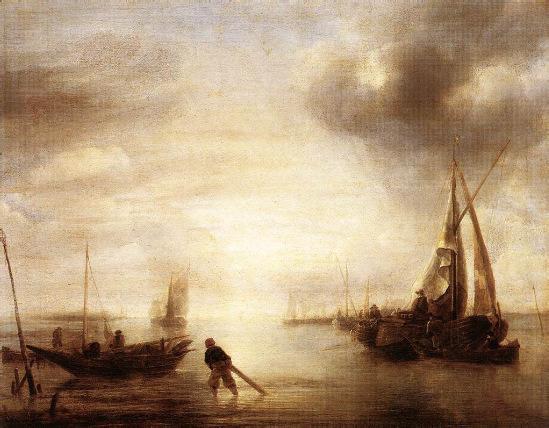
Described by Cornelis Hofstede de Groot as ‘an excellent picture’ (op. cit.), this painting is in many respects a synthesis of van de Cappelle’s visual vocabulary in the late 1640s and early 1650s. Here, the artist depicts a small cluster of sailing and fishing boats positioned parallel to the picture plane and receding in strict linear perspective toward the distant horizon to create a sense of great pictorial depth. Two fishermen trudging through the shallows anchor the painting’s foreground. Much as with the Calm of approximately the same date in the Wallraf-Richartz-Museum, Cologne (fig. 1), a painting that has been regarded as among the artist’s masterpieces, van de Cappelle here employs a deliberately reductive group of vessels set against a characteristically luminous, silver-hued sky. His introduction of the wooden jetty with various figures taking in the ocean breeze or going about their daily activities anchors the left side of the composition and can similarly be found in other marines datable to around 1650, including the example dated 1649 in the Nationalmuseum, Stockholm (inv. no. NM 562), and that of 1650 in the National Gallery, London (inv. no. NG 6406).
Van de Cappelle was the son of a wealthy dyer and may have been self-taught, as suggested by the painter Gerbrand van den Eeckhout, who began a poem in the album amicorum of the Amsterdam poet Jacob Heyblocq with the line ‘In praise of the art of Jan van de Cappelle who taught himself to paint out of his own desire’. Documentary evidence suggests that van de Cappelle was extremely affluent and may therefore have painted more for his personal pleasure than a need for pecuniary gain, as suggested by his comparatively small body of work totalling fewer than 150 surviving paintings. He spent much of his life resident on the Keizersgracht, one of the wealthiest addresses in Amsterdam, before moving to a house on the Koestraat, for which he paid the princely sum of 9,600 guilders. An inventory of van de Cappelle’s estate following his death in 1679 showed he had amassed a fortune of 92,720 guilders in cash, seven houses, various parcels of land in Amsterdam, a country estate near Nieuwersluis aan de Vecht, a pleasure yacht and an extensive art collection composed of some 200 paintings – including lost portraits by Rembrandt and Frans Hals – and more than 6,000 drawings, roughly half of which were by four leading Dutch artists: Hendrick Avercamp (900 drawings), Rembrandt (500 drawings), Jan van Goyen (400 drawings) and Simon de Vlieger (1,300 drawings). The group by de Vlieger, who may have informally trained van de Cappelle, no doubt provided seemingly endless source material for the younger artist’s own paintings.
Despite nothing much of its history being known before the turn of the twentieth century, this painting must nevertheless have enjoyed considerable early fame. According to Wilhelm Valentiner (op. cit.), a somewhat larger variant formerly in the collection of P.A.B. Widener, catalogued as autograph by Hofstede de Groot (op. cit., no. 127), is a copy. A second copy, signed and dated ‘1651’ but with a third fisherman wading in the middle distance, sold Christie’s, South Kensington, 21 November 1991, lot 161.
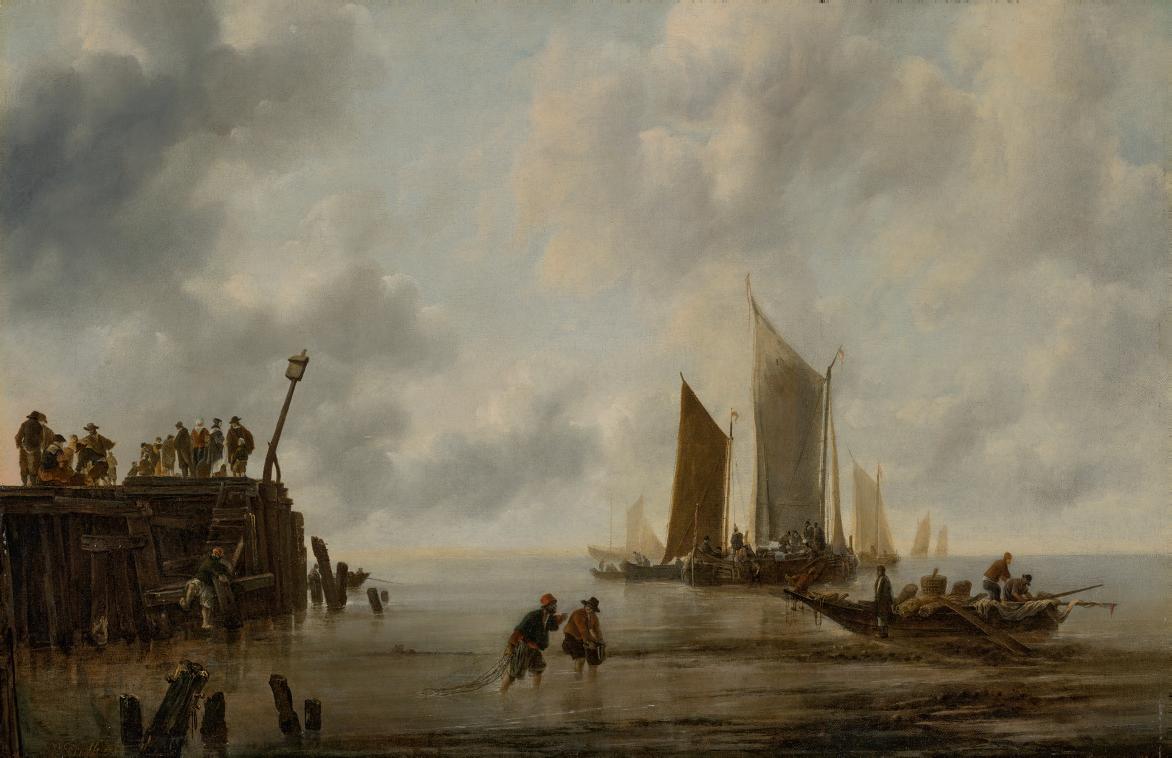
Portrait of a gentleman, half-length, in a black cloak oil on canvas
27 x 23º in. (68.5 x 59 cm.)
£60,000-80,000
US$78,000-100,000
€72,000-96,000
PROVENANCE:
Acquired by the father of the present owner in circa 1955, as 'Anthony van Dyck'.
This impressive Portrait of a gentleman testifies to the consummate skill of one of the most exceptional female painters of the seventeenth century — Michaelina Wautier — an artist whose oeuvre has only recently begun to receive the attention it so rightly deserves. Though Wautier turned her brush to all genres, including history painting and still life, it is in her portraits and genre scenes that the artist's lively freshness and observational accuracy find their fullest expression. Her powerful depictions invite comparisons with some of the most outstanding seventeenth-century painters, including Anthony van Dyck,
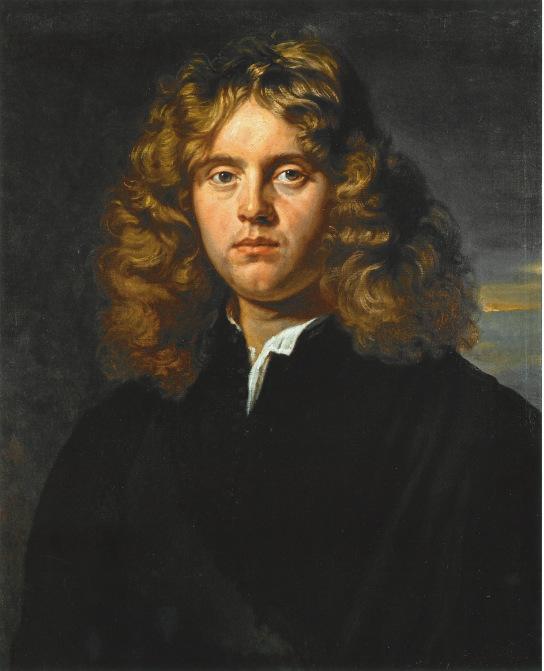
to whom the present work was previously misattributed. Indeed, the infrequent references to Michaelina in subsequent centuries note her particular talent as a portrait painter. The nineteenth-century German art historian Georg Kasper Nagler, for example, wrote that she ‘made herself known…through portraits’ (Neues Allgemeines Künstler-Lexikon, XXII, Munich, 1852, p. 101). As far as can be discerned from the historical record, the production of portraits formed an integral part of Wautier’s activity as an artist from the beginning of her career, with her earliest identifiable work being the Portrait of Andrea Cantelmo, known today exclusively through a 1643 engraving by Paulus Pontius, and her first extant signed and dated painting, the Portrait of a Commander in the Spanish Army from 1646 (Brussels, Les Musées royaux des Beaux-Arts).
The present painting showcases Wautier’s remarkable talent for capturing the personality of her sitters and can be dated to the latter 1650s, when the artist showed evident engagement with the works of van Dyck and Rubens. Our sitter’s introspective gaze, directed away from the viewer, imbues him with a noble dignity, despite his status remaining elusive. With his mane of auburn hair and pose against the horizon of a cloud-filled sky, the portrait also finds semblance in a work by Michaelina’s elder brother Charles: the Portrait of a man of 1656 (Brussels, Royal Museums of Fine Arts of Belgium; fig. 1), similar in both composition and pensive tenor. Yet, as Katlijne van der Stighelen has noted, they could not have been painted by the same artist, finding the present sitter’s heroic expression and pose very typical of Michaelina, together with the handling of the physiognomy and the costume (after first-hand inspection; private communication, September 2004).
Wautier lavished evident attention on rendering the nuances of the sitter’s skin and features with exceptionally free brushwork, with the versatile handling of paint speaking to a wide range of influences on her practice. Nothing specific is known about her training. Newly discovered archival documents show that she was born and baptised in Mons in 1604; as an unmarried woman, it is likely that she remained there to care for her parents, at least until her mother’s death in 1638. There is evidence of her being active as a painter in Brussels from circa 1640 onwards, an opportunity that was open to her thanks to her brother, Charles, who was then living and working in the town. However, given the lack of contemporary documentary sources, Wautier’s works provide the only clues regarding her artistic training. While she may well have obtained some degree of tutoring training from her brother, it is clear that she equally drew eclectically from sources as disparate as sixteenth and seventeenth-century Italian paintings and Michael Sweerts, who had set up a drawing academy in Brussels in 1656 following his return from Rome. Indeed, echoes can be found in the present portrait of Sweerts's Self-Portrait of circa 1656 (Oberlin, Allen Memorial Art Museum). By this time, Michaelina must have already established herself as one of Brussels' leading painters: the 1659 inventory of the collection of Archduke Leopold Wilhelm, who, as Governor of the Spanish Netherlands, was resident in Brussels between 1647 and 1656, includes four paintings by the artist (Vienna, Kunsthistorisches Museum), the only works by a female painter included in this illustrious collection.
We are grateful to Professor Katlijne Van der Stighelen for her assistance in the cataloguing of this lot.



A river landscape with a horse-drawn cart carrying a lady with baskets of vegetables across a ford next to a castle, a drover, cattle and windmill beyond signed and indistinctly dated 'j siberechts A.o. 16...' (lower centre, on the shaft of cart) oil on canvas
38¿ x 47√ in. (96.8 x 121.6 cm.)
£60,000-80,000
US$78,000-100,000
€72,000-96,000
PROVENANCE:
Abbot Family, the Priory, Abbotsleigh, in the 19th century, and by descent. Anonymous sale [Property of a Lady]; Sotheby's, London, 9 July 1998, lot 28, where acquired by the present owner.
Jan Siberechts was a leading painter of bucolic landscapes, first in his native Antwerp, where he became a member of the Antwerp Guild of Saint Luke in 1648/9, and later in England, where he resided from about 1672/4. As with many seventeenth-century Dutch and Flemish artists, Siberechts was greatly inspired by the Roman campagna and suffused his early landscapes with Italianate light. While it is uncertain whether the artist travelled to Italy himself, he no doubt encountered the work of contemporaries like Nicolaes Berchem, Karel Dujardin and Jan Both and absorbed their observations on light and atmosphere. Between 1661 and 1672, Siberechts developed a distinctive style of Flemish landscape painting that focuses on the idylls of country life, of which the present painting is a particularly striking example.
Siberechts here presents a charming depiction of rustic Flemish life using, as is typical of his paintings of the period, a symmetrical triangular composition anchored by the castle at left, the woman wading through the water viewed from behind in the painting’s foreground and the windmill in the right background. The simple red clothing of both the standing female figure and the woman in the cart bringing vegetables to market are set off from the cool green tonality of the verdant landscape. As he so often does in works like this, Siberechts revelled in painted details like the prominent patch along the lower edge of the standing woman’s jacket, the still-life elements at the back of the cart and the play of light as the horse splashes through an otherwise placid stream.
Though the final two digits of the date are currently illegible, the painting probably dates to the second half of the 1660s or early 1670s. It was in this period that Siberechts’s distinctive approach reached its apogee. Figures are placed more prominently in the foreground to create a sense of volume and space and trees and branches like the sinuous trunk in the central middle ground stand out as distinctive features deployed to enhance the painting’s decorative appeal.
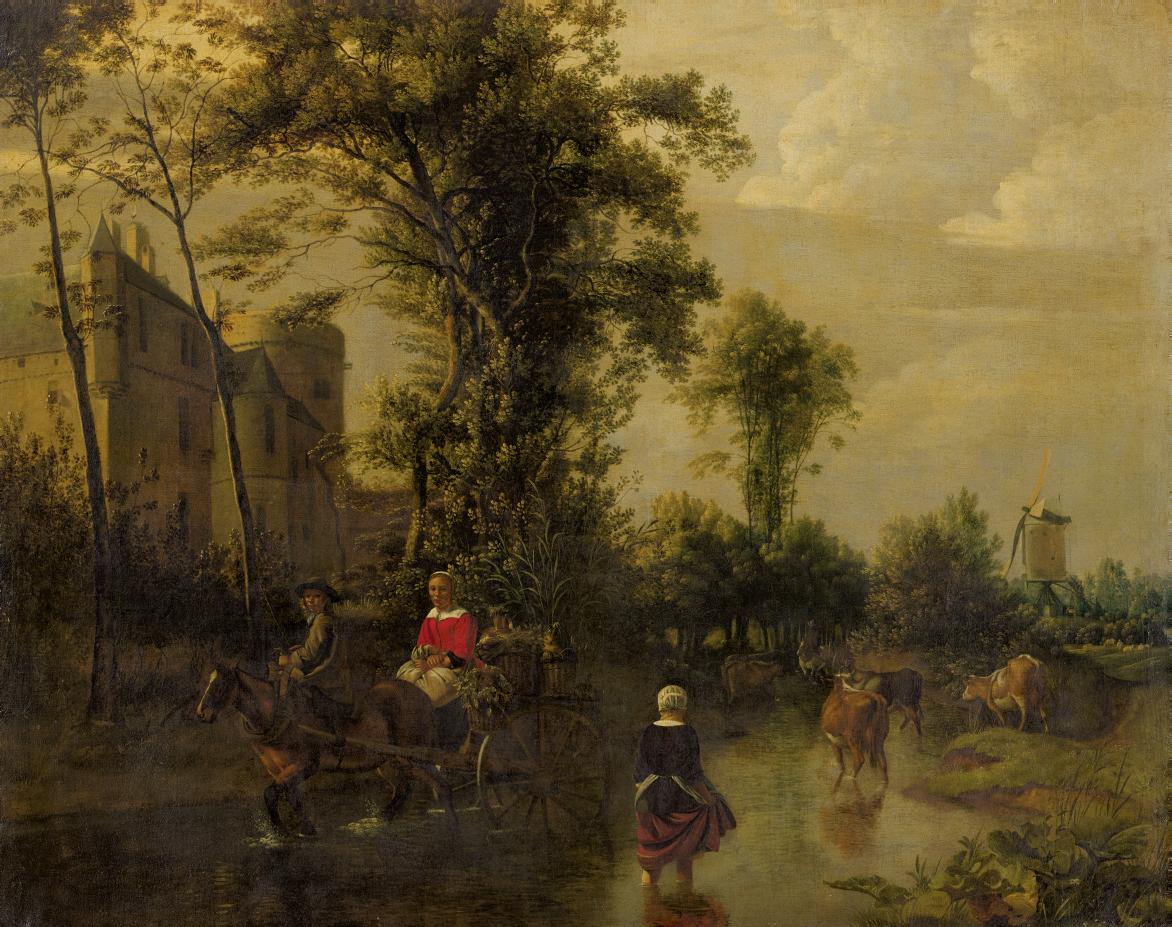
Allegory of Lust
signed and dated 'GHonthorst fe. 1628' ('GH' in ligature, lower left)
oil on canvas
37 x 30æ in. (94 x 78 cm.)
£150,000-250,000
US$200,000-320,000
€190,000-300,000
PROVENANCE:
By family tradition from the Devonshire collection at Chatsworth until 1920, when given to Lady Dorothy Macmillan (née Cavendish), on her marriage in 1920, and thence by descent; [The Property of the Macmillan Trusts, removed from Birchgrove House]; Sotheby's, London, 6 December 1989, lot 73, where acquired by the present owner.
LITERATURE:
W.E. Franits, 'Emerging from the Shadows: Genre Painting by the Utrecht Caravaggisti and its Contemporary Reception', eds. J. Spicer and L. Federle Orr, Masters of Light: Dutch Painters in Utrecht in Golden Age, exhibition catalogue, New Haven and London, 1997, pp. 118-19, fig. 7.
J.R. Judson & R.E.O. Ekkart, Gerrit van Honthorst, 1592-1656, Doornspijk, 1999, pp. 196-197, no. 253, pl. 143.
W.E. Franits, Dutch Seventeenth-Century Genre Painting: Its Stylistic and Thematic Evolution, New Haven and London, 2004, pp. 81-2, fig. 78.
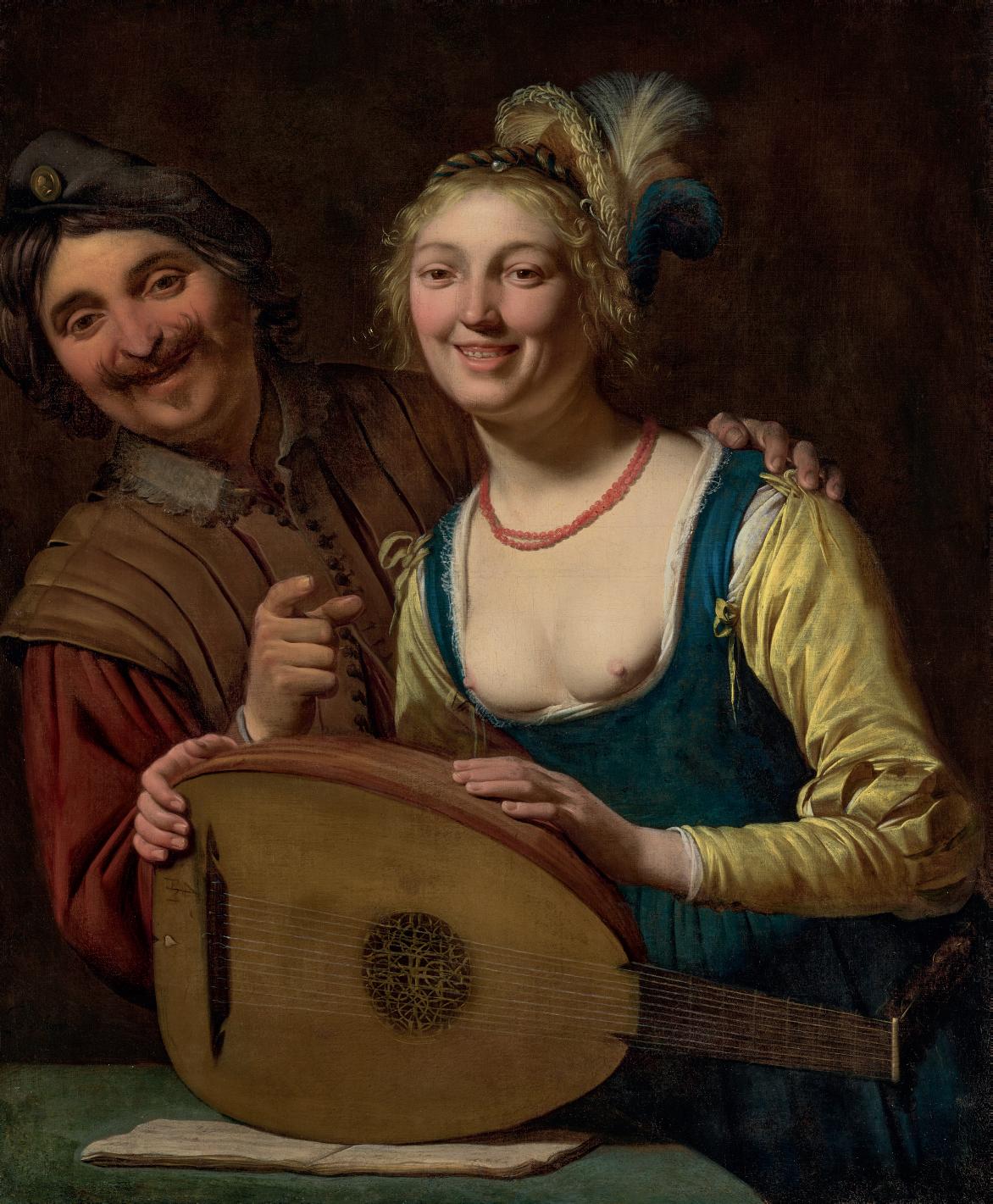

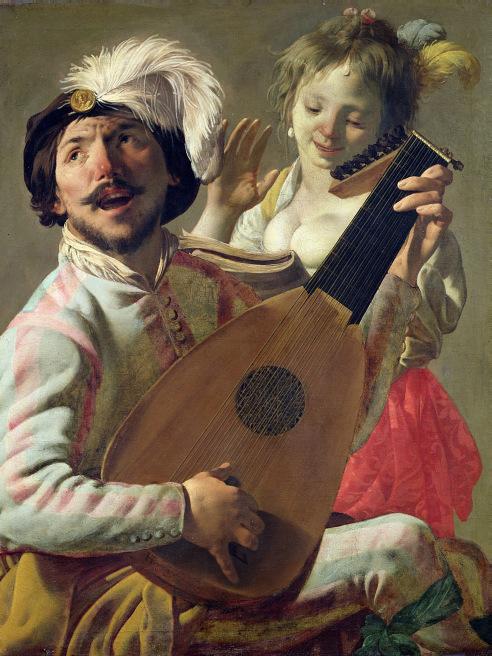
This painting, which is dated 1628, the year in which Honthorst departed his native Utrecht for a monthslong stay in England, reflects the artist’s changing approach to his art in the second half of the 1620s. In addition to distinctly Caravaggesque pictures – strikingly illuminated compositions, often with illusionistic effects, that recall the time he spent in Italy in the 1610s –Honthorst expanded his visual repertoire to include exuberantly coloured classicizing or pastoral subjects that reflected the growing taste for such works among courtly circles of Dutch society. Though conceived largely in the earthen tones that prevailed in his earlier work, Honthorst has here similarly introduced passages of bright local colour, including the woman’s yellow sleeves and cap and her double-stranded coral necklace.
Honthorst has staged his protagonists behind a table draped in a green cloth on which can be seen a music book and lute on its side. In their catalogue raisonné, J. Richard Judson and Rudolf E.O. Ekkart posit that the painting may represent the sense of Hearing (op. cit., p. 197). In seventeenth-century literature, particularly the ever-popular picaresque novel, correspondence was drawn between love and colourful characters making music. In turn, musical instruments became a conventional motif in such Caravaggesque brothel scenes and conveyed a not particularly thinly veiled meaning. As Wayne Franits has observed, scantily-clad young women touching the rounded belly of a lute would have connoted to contemporary viewers the implicit sexuality (and fecundity) of the female body (op. cit., p. 118). Such images must have appealed immensely to connoisseurs, who likely concerned themselves less with moralistic warnings about succumbing to carnal appetites than the titillation inherent in such imagery.
Judson and Ekkart have further pointed out that the courtesan in the present painting is closely akin to the young woman who appears in a pair of Honthorst’s most successful pictures in the period, the Smiling girl (St. Louis Art Museum) and Procuress (Utrecht, Centraal Museum), both executed in 1625 (op. cit.). Further connections can be drawn with Hendrick ter Brugghen’s celebrated Duet (fig. 1; Paris, Musée du Louvre), which dates to the same year as the present painting and likewise shows a young woman in extreme décolleté with a lute and music book seen in the painting’s foreground.
The present painting probably formed part of the famed collection assembled by the Dukes of Devonshire at Chatsworth, from which it appears to have been gifted in the early twentieth century. When it emerged on the market in 1989, it achieved a world record price for any painting by Honthorst at auction (£264,000). The price would not be exceeded until the sale of the Merry musician with violin under his left arm, a painting that graces the front cover of the catalogue raisonné for the artist, nearly a decade later.
A wedding feast in an inn
signed (?) 'AV ostade' ('AV' in ligature, lower left)
oil on panel
22æ x 33√ in. (57.9 x 86 cm.)
£100,000-150,000
US$130,000-190,000
€120,000-180,000
PROVENANCE:
The Earls Fitzwilliam, Wentworth Woodhouse, by 1842, and by descent in the family, until sold by The Trustees of The Olive, Countess Fitzwilliam Chattels Settlement and of other members of the family; Christie's, London, 8 July 1998, lot 50, where acquired by the father of the present owner.
EXHIBITED:
London, Royal Academy, Winter Exhibition of works by the Old Masters and Deceased Masters of the British School, 1912, no. 73 (lent by Earl Fitzwilliam).
LITERATURE:
J. Smith, Supplement to the Catalogue Raisonné of the Works of the Most Eminent Dutch, Flemish, and French Painters, IX, London, 1842, p. 102, no. 78.
G.F. Waagen, Treasures of art in Great Britain: being an account of the chief collections of paintings, drawings, sculptures, illuminated mss., etc., III, London, 1854, p. 339, where listed in the Gallery of Wentworth Woodhouse.
Black's Picturesque Guide to Yorkshire, Edinburgh, 1862, 2nd ed., p. 318, where listed in the Gallery of Wentworth Woodhouse.
C. Hofstede de Groot, A Catalogue Raisonné of the Works of the Most Eminent Dutch Painters of the Seventeenth Century, III, London, 1910, p. 367, no. 733.
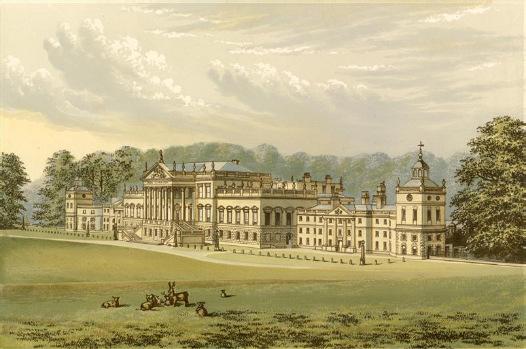
Ostade was one of the foremost genre painters of seventeenth-century Holland, recorded as having started his career as a pupil of Frans Hals in Haarlem, concurrently with Adriaen Brouwer. Following Brouwer's influence, in his early work Ostade adopted a satirical, almost caricatured, manner in his painting, but from the 1640s onwards he began to endow his low-life protagonists with increasing degrees of restraint and dignity, his palette becoming richer and his detail more precise.
This unusually large-scale panel epitomizes Ostade’s approach to interior scenes in the 1630s. Several groups of carefree revellers carouse, embrace, sing, make music and dance within the rustic confines of a ramshackle inn. The painting’s jaunty atmosphere is untrammelled by peasants pulling knives, brawling or engaging in other types of (mis)behaviour that so frequently characterise Ostade’s early work. An untended young boy seated at the centre of the painting strikes the only obvious note of caution to an otherwise ebullient scene. With his slouched posture, splayed legs and the humble gruel that he picks at with his hands, from a tender age he affects the stereotypes that in the seventeenth century were believed to be hallmarks of the ‘uncivilised’ masses. Nor is it clear who exactly is charged with his upbringing, the two likeliest candidates being the two young couples amorously locking lips.
By the mid-nineteenth century, this painting was in the collection of the Earls Fitzwilliam at Wentworth Woodhouse in South Yorkshire (fig. 1), in whose collection it remained until it was sold in these Rooms at the end of the last century. The collection also included works by Claude and Sir Anthony van Dyck as well as paintings that in earlier times bore attributions to the likes of Raphael and Titian.
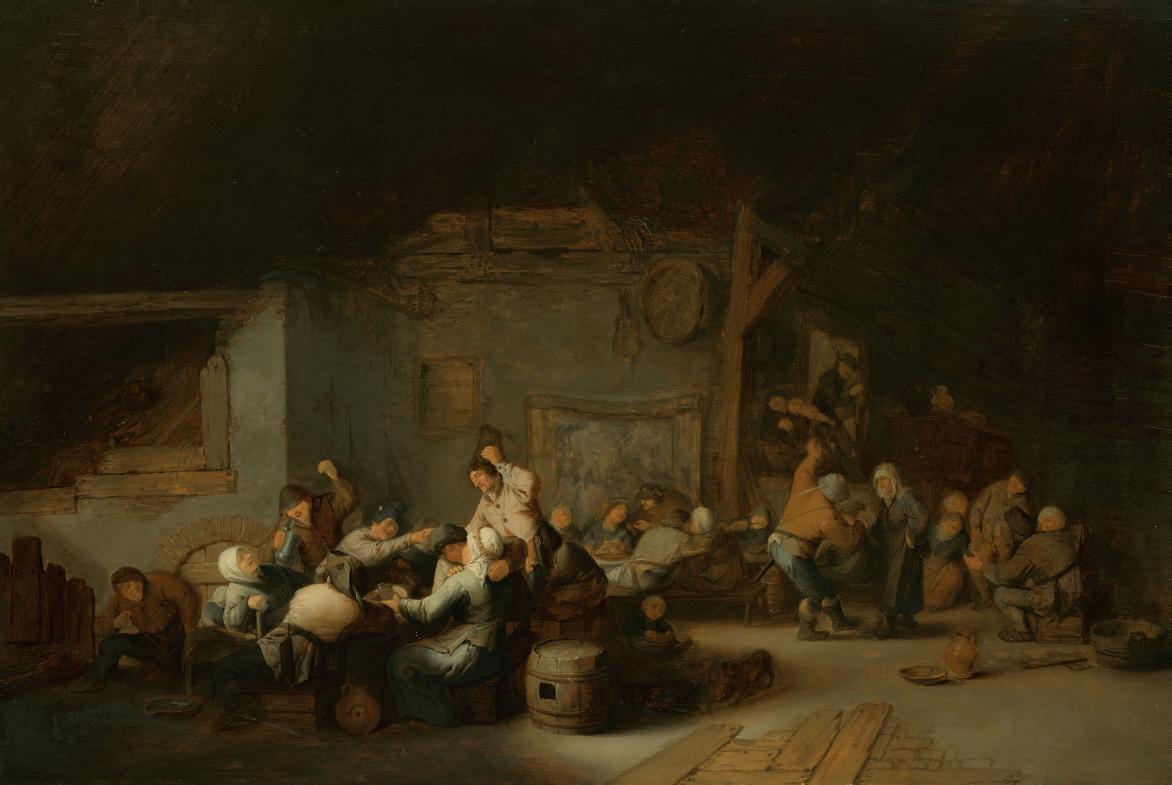
The Prodigal Son
oil on canvas
19æ x 26æ in. (50.2 x 67.9 cm.)
£80,000-120,000
US$110,000-160,000
€96,000-140,000
PROVENANCE:
Private collection, England (according to Weltkunst, 1953).
with Wengraf Old Master Galleries Ltd., London, by 1953, where acquired on 17 April 1958 by, with Julius Böhler, Munich, where acquired on 12 August 1958 by, Heinz Kisters (1912-1977), Kreuzlingen. with Brod Gallery, London, 1969. Private collection, England.
Anonymous sale [The Property of a Gentleman]; Sotheby's, London, 12 December 1979, lot 64.
Saul P. Steinberg (1939-2012), New York, and by descent.
EXHIBITED:
London, Arcade Gallery, Italian Influence on French, Flemish and Dutch Painting 1550-1650, 17 March-10 April 1954, no. 16.
Bregenz, Künstlerhaus Palais Thurn und Taxi, Meisterwerke der Malerei aus Privatsammlungen im Bodenseegebiet, 1 July-30 September 1965, no. 58 (lent by Heinz Kisters, Kreuzlingen).
Augsburg, Rathaus; Cleveland, The Cleveland Museum of Art, Johann Liss, 2 August 1975-7 March 1976, no. A33, with catalogue entry by A. Tzeutschler Lurie.
LITERATURE:
Dr. L.F-B, in Weltkunst, XXIII, no. 20, 15 October 1953, p. 3.
E. Schilling, 'Betrachtungen zu Zeichnungen von Johan Liss', in Festschrift für Karl Lohmeyer, Saarbrücken, 1954, p. 37, note 2.
K. Steinbart, 'Das Werk des Johann Liss in alter und neuer Sicht', Saggi e Memorie di Storia dell’arte, II, 1958-59, pp. 180-181, fig. 26.
C. Donzelli and G.M. Pilo, I Pittori del Seicento Veneto, Florence, 1967, p. 242. 'Brod Gallery Advertisement', XC, Apollo, July 1969, p. v.
E.A. Safarik, 'La Mostra di Johann Liss', Arte Veneta, XXIX, 1975, p. 303, as possibly a pastiche.
R. Spear, 'Johann Liss Reconsidered', The Art Bulletin, LVIII, no. 4, December 1976, pp. 584, 586, 588 and 590.
R. Klessman, 'Addenda to Johann Liss', The Burlington Magazine, CXXVIII, no. 996, March 1986, p. 192, note 9.
R. Klessman, 'Gartenfeste und Gelag. Ein bevorzugtes Bildthema von Johann Liss', Kunst und Antiquitaten, IX, 1992, pp. 30-1, fig. 5.
J. Wojciechowski, 'A Preparatory Drawing for Liss’s "Temptation of St. Anthony"', The Burlington Magazine, CXXXVIII, no. 1116, March 1996, p. 191.
R. Klessmann, Johann Liss: A Monograph and Catalogue Raisonné, Doornspijk, 1999, pp. 71 and 138, no. 10, pl. 23.
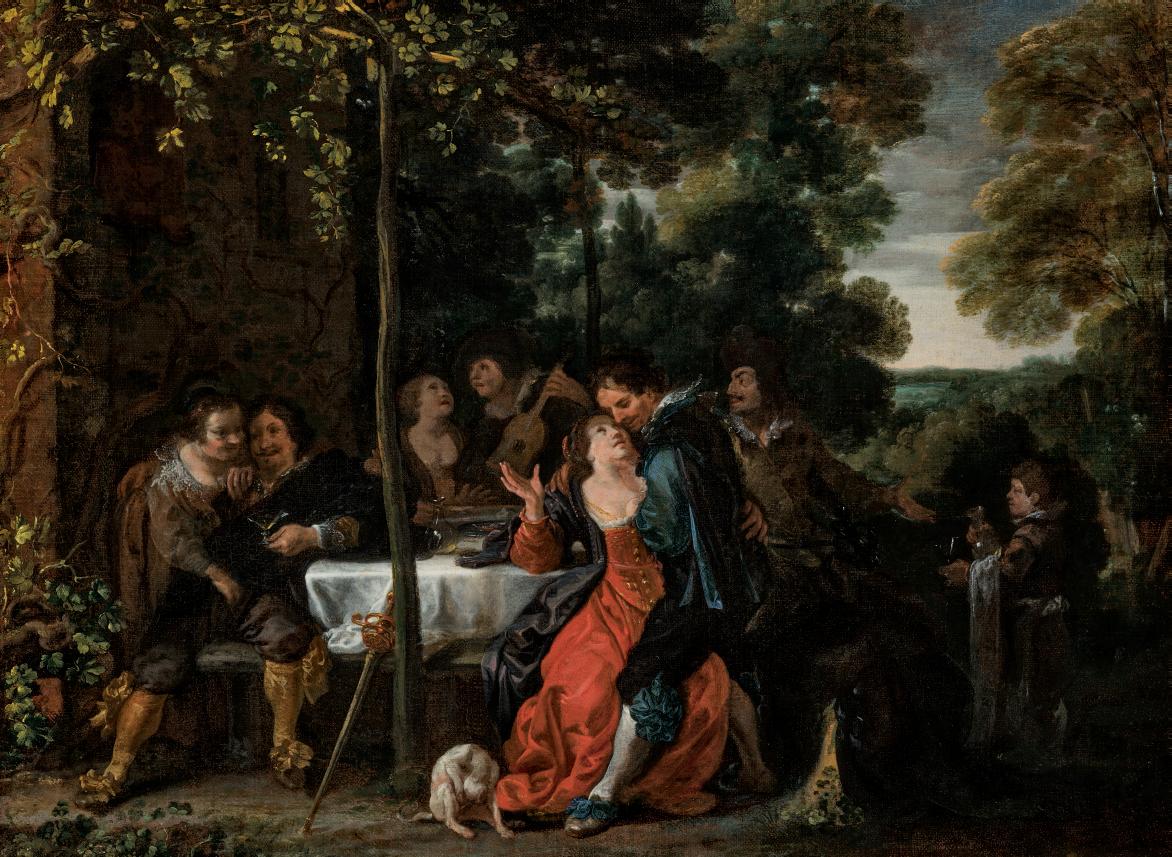
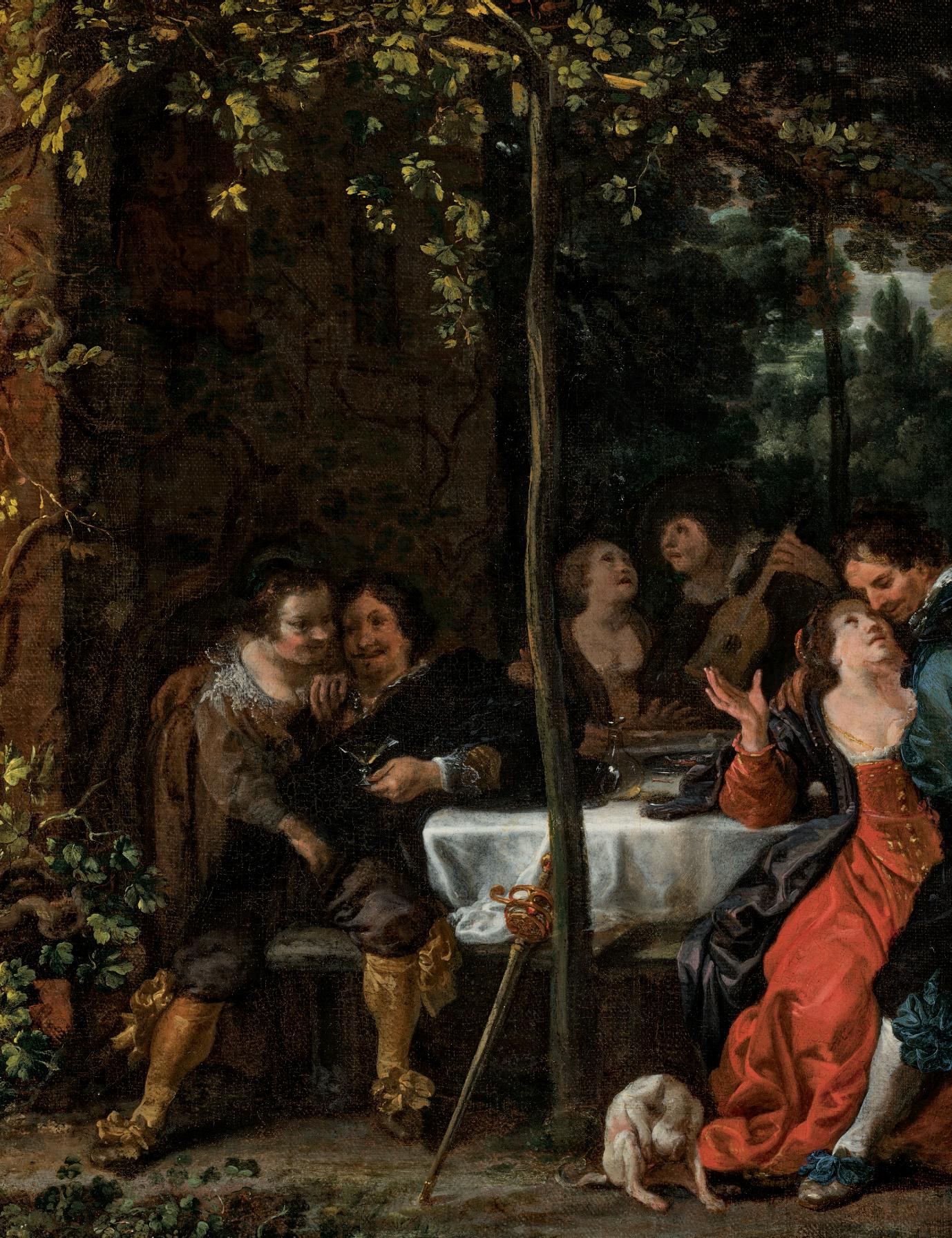
Liss's remarkable career, cut short by his premature death from the plague raging in Venice in 1629-30, was spent far from his native Germany. He left for Holland in about 1615 and never returned to his homeland. Along with Adam Elsheimer, he was one of the few seventeenth-century German artists whose paintings were widely known across Europe. The unusually large number of autograph repetitions attests to the demand for his work. His influence extended beyond Italy, the Netherlands and France to countries where he had never been active and lasted well into the eighteenth century.
Most of what is known about Liss today is due to Joachim von Sandrart's highly personal account of the artist, written when he was Liss’s guest in Venice in 1629 (Academie der Bau-, Bild-, und Mahlerey-Künste von 1675, ed. A.R. Pelttzer, Munich, 1925, pp. 187-8). Liss was born in Holstein in the Oldenburg area north of Lübeck, a province that had no strong artistic tradition of its own. Relatively little is known about his origins, but it is presumed that his parents were the painters Johann and Anna Liss, who furnished banners and escutcheons for the dukes of Holstein. It was probably in their workshop that he learned to paint, but it was not until his arrival in Holland around 1615-16 that he became exposed to the international art scene. According to Sandrart, it was in Amsterdam and Haarlem that he first came under the influence of Hendrick Goltzius. Soon, however, he allied himself with younger artists, including Frans Hals, who were paving the way for the future of Dutch painting. Upon his arrival in Antwerp around 1617-18, Liss's paintings began to exhibit an entirely individual character. The influence of the leading artists of Antwerp – Rubens, Jordaens and Abraham Janssens – had a profound and lasting impact on Liss’s art. It was during this period that his propensity to absorb and integrate new artistic impulses into his own style began to emerge. As Rüdiger Klessman points out (op. cit., p. 22), such an impetuous development remains unparalleled, even among the Netherlandish artists of his generation.
Liss did not stay in the Netherlands long. The date of his arrival in Italy is uncertain, but he must have arrived in Venice, via Paris, by 1621. From Venice he went to Rome, where he adopted a completely different manner, seeking new ways to interpret traditional Northern subjects through contact with followers of Caravaggio – particularly Valentin – and artists from the school of the Carracci. He must have stayed in the city for a considerable enough period to be allowed into the Schildersbent, an association of Northern artists active in Rome from around 1623, in which he probably earned himself the sobriquet ‘Pan’ with his Banquet of Soldiers and Courtesans (also known as The Prodigal Son; Nürnberg, Germanisches Nationalmuseum), the erotic candour of which went beyond all boundaries of convention.
Merry companies such as this recurred throughout Liss’s stylistic development, a genre he had become acquainted with in Haarlem through artists like Willem Buytewech, Esaias van de Velde and Dirck Hals, and continued to develop during his first stay in Venice. While the genre moved from the realm of the sacred to the secular – making it one of the most popular subjects on the art market between 1615 and 1645 – in this composition, Ann Tzeutschler Lurie noted that the picture drew only a fine line ‘between depictions of the prodigal son dissipating his inheritance and scenes of pure genre’ (op. cit., 1975). Indeed, as is customary in such scenes of levity, subtle allusions to vanity and the folly of sensual enjoyment are hidden in the details, which, in combination with the subject of feasting young people, would have reminded contemporary beholders instantly of the Parable of the Prodigal Son (Luke 15:11-32).
In this lavish outdoor setting, young gentry are at play. A courtesan in a red dress sits centre stage, being amorously embraced by the cavalier in a dark-blue suit, considered to be the Prodigal Son. Klessman observed the behaviours of the figure group as symbolic of the five senses, with Hearing suggested by the lute player, Sight by the amorous lovers, Smell by the ablutions of the dog, Taste by the boy pouring a glass of wine and Touch by the fondling couple to the left. Often moralistic and admonitory, Liss also incorporated such symbolism in slightly earlier versions of The Prodigal Son (Vienna, Akademie der bildenden Künste; and the aforementioned painting in Nürnberg, Germanisches Nationalmuseum), which Klessman considered a further argument in favour of the present picture’s connection to the same biblical parable.
Klessman has dated the present picture to the beginning of Liss’s Roman period, circa 1622-24 (op. cit., p. 138), comparing the courtesan in the red gown to Voluptas in his Decision of Hercules (Dresden, Staatliche Kunstsammlungen), along with their shared leafy, sunlit trees (ibid., p. 71). Other particulars, like the page serving wine at the right edge of the picture and the guests gazing up at the occupants of the house, are also compared to the Prodigal Son in Vienna (loc. cit.). Tzeutschler Lurie, meanwhile, finds the present picture’s closest stylistic parallels in Liss’s Temptation of Saint Anthony (Cologne, Wallraf-Richartz Museum), with his quick manner of execution, soft modelling and fluid and open brushwork (op. cit., p. 111), dating it to the artist’s second Venetian period, while Richard Spear dates it to his first (op. cit., p. 588). Though it is evidently difficult to arrive at a safe stylistic chronology, the present picture betrays a connection with an earlier Merry Company by the artist, now lost and known only through a copy in the De Young Museum in San Francisco, together with a preparatory drawing in Berlin (Klessman, op. cit., no. D 5).
A military encampment, traditionally identified as the Siege of Antwerp
signed and dated 'J: Lingelbach . fecit. / 1661' (lower right)
oil on canvas
36Ω x 46æ in. (92.5 x 118.8 cm.)
£70,000-100,000
US$91,000-130,000
€84,000-120,000
PROVENANCE:
(Probably) Anonymous sale; Christie's, London, 28 June 1828, lot 34 (unsold). (Probably) Anonymous sale; William Buchanan, London, 14 February 1830, lot 15. (Probably) Anonymous sale [The Genuine Property of the Executors of A Gentleman, Dec'd and of John Annis, Esq.]; Phillips, London, 10 June 1831, lot 37, as 'Lingelback and Wouwermans, The Siege of Antwerp'. (Probably) Anonymous sale; Edward Foster, London, 23 May 1832 (=1st day), lot 64, as 'Lingelback and Wouwermans' (190 gns.).
(Probably) Charles John West, Surrey Street, Norwich; J. Culley, Norwich, 11 July 1834 (=5th day), lot 112.
Acquired by the great-great-grandfather of the present owner in circa 1850.
Painted in Lingelbach’s prime, in 1661, this unpublished work is one of the artist’s most ambitious landscapes, featuring a huge array of figures, animals and detail before a distant view of a town. It provides a beautiful illustration of how Lingelbach increasingly took inspiration from the great equestrian painter Philips Wouwerman (1619-1668) and helps explain why it was actually considered a work of collaboration between the two artists in the past, described in the 1831 sale as a work that 'has always been considered the chef d'oeuvre of this master' (op. cit.).
An unusually versatile painter, Johannes Lingelbach belonged to the so-called second generation of Dutch Italianate painters. It is assumed that he learned his trade in Amsterdam before making a trip to Rome, where he is recorded in 1647 and 1648 living in the via del Babuino - the epicentre of the so called Bamboccianti group of northern genre painters in Italy. After his return to Amsterdam in 1650, Lingelbach’s career flourished in the production of elegant genre scenes, Italianate landscapes and harbour scenes. Owing to his special talent as a figure painter, he was also frequently called upon to add staffage to the output of many of the leading landscape painters of his day, such as Meindert Hobbema (1638-1709), Jan Hackaert (c. 1629-c. 1685) and Frederick de Moucheron (1633-1686).
This type of expansive military scene is rare in Lingelbach’s oeuvre, with the only strictly comparable work being the Flemish town under Siege in the Hermitage, St. Petersburg (inv. no. 1829), and while the scene has traditionally been called the Siege of Antwerp, the town appears, as in the Hermitage painting, to be imaginary. The grey charger standing in profile in the foreground forms the focal point in both works, with hastily erected tents receding on both sides of the composition toward the town in the distance.

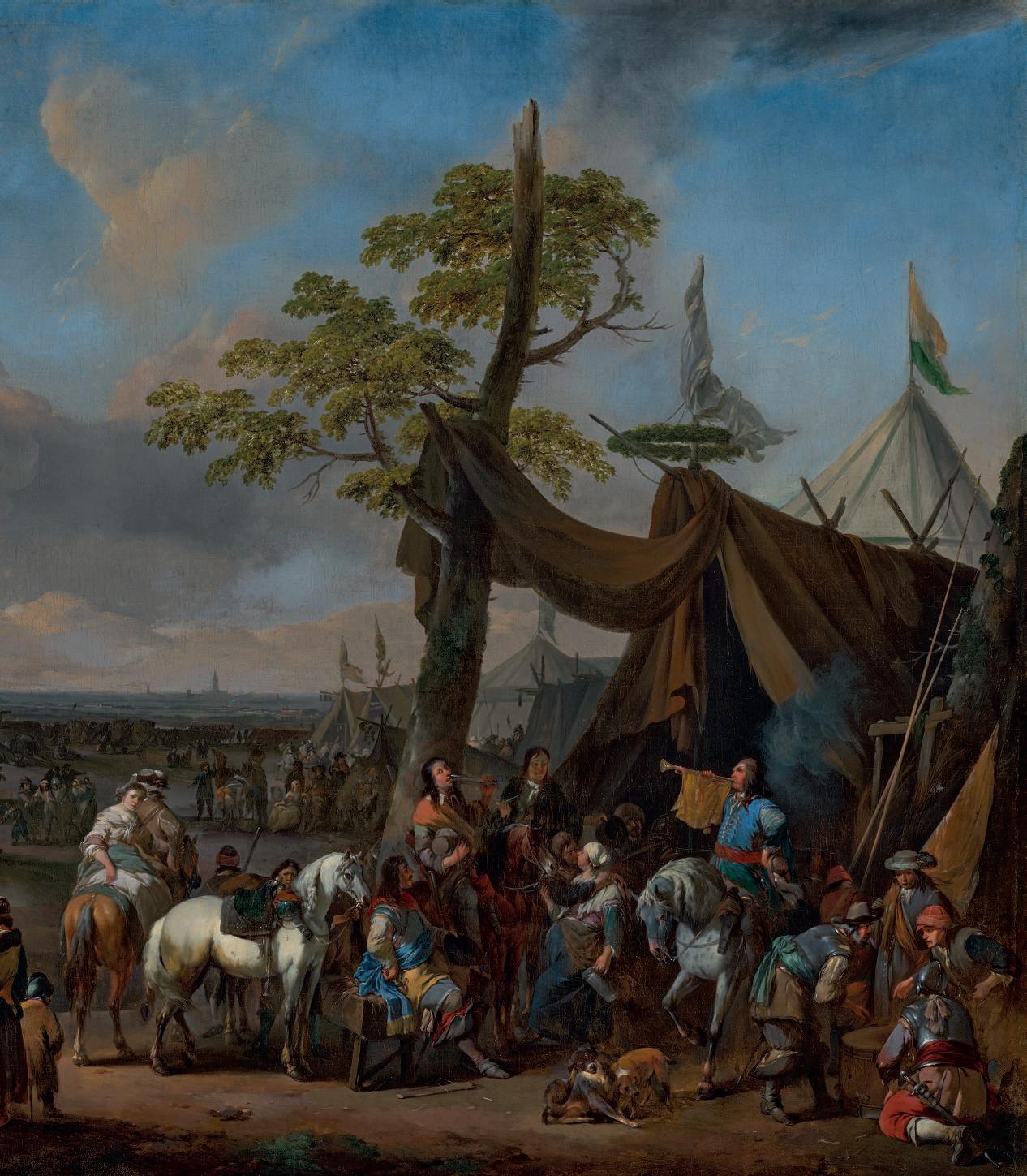
Portrait of Richard Payne Knight (1751-1824), half-length, in a black coat and white stock oil on canvas
30 x 25 in. (76.2 x 63.5 cm.)
£50,000-80,000
US$65,000-100,000
€60,000-96,000
PROVENANCE:
(Probably) Sir George Elliot Meyrick Tapps Gervis Meyrick, 3rd Bt. (1827-1896), Hinton Admiral, Hampshire, and Bodorgan Hall, Anglesey, by whom loaned, according to an inscription on the stretcher, to his daughter, Emma Douglas Tapps Gervis Meyrick (1851-1934), who, in 1878, married Major Gerald Robert Spencer, and presumably later returned to her nephew, Sir George Llewelyn Tapps Gervis Meyrick, 5th Bt. (1885-1960), by whom given to his younger brother, Captain Richard Owen Tapps Gervis Meyrick (1892-1948), Buckland Abbey, Devon, and Nutwell Court, Devon, and by descent; Bearnes Hampton and Littlewood, Exeter, 17 July 2024 (=2nd day), lot 481, as 'Attributed to William Owen', where acquired by the present owner.
Hitherto unpublished, this canvas is the earliest of three portraits Thomas Lawrence painted of Richard Payne Knight, one of the leading connoisseurs, collectors and scholars of his generation. The canvas, which is in a remarkably original state of preservation, can be dated on stylistic grounds to circa 1790, the period in which Lawrence was emerging as the natural successor to Sir Joshua Reynolds, then the pre-eminent portraitist in England.
When Lawrence and his sitter first encountered one another remains unclear, however, by 1788, the artist had begun Homer Reciting his Poems (1790; London, Tate Britain), the picture his biographer describes as 'painted for Mr. Richard Payne Knight... with great care and study' that was eventually exhibited at the Royal Academy in 1791 (D.E. Williams, The Life and Correspondence of Sir Thomas Lawrence, Kt. 1831, I, pp. 122-3). The Tate composition is considered Lawrence's visual crystallisation of Payne Knight's theories on painting, ideas which had been first ventilated in letters of 1776 and 1783 to the artists George Romney and James Barry, in which he reveals his position on the practice of contemporary art in Britain. The central tenets of Knight's doctrine were the importance of studying nature, that the human body should be painted from life, and that sublimity in history painting - the highest genre according to academic tradition - should be achieved on a small scale.
It is likely that Knight subsequently played a role in Lawrence succeeding Reynolds as Painter to the Society of Dilettanti following the latter’s death in 1792. Two years later, Lawrence exhibited at the Royal Academy the threequarter-length portrait of Knight now in the Whitworth Art Gallery, University of Manchester, a work described by Michael Levey as ‘memorable though hardly flattering’ (Sir Thomas Lawrence, New Haven and London, 2005, p. 104). Consciously following the pattern of earlier portraits of connoisseurs, Knight is shown seated with a large folio, beside one of the prized works from his collection; although its antiquity is now doubted by scholars, the vessel on the
right of the composition with its prominent handles was famously described by Knight as worthy 'of the time of the Macedonian kings'. By the time Knight sat to the artist for a third portrait in 1805 - a bust-length for the Society of Dilettanti - Lawrence's admiration for his sitter had somewhat cooled. In a letter to Farington in August of that year, he remarks that Knight's taste should not be adopted and warned that it was 'founded on Sensual feeling' (Farington Diary, 24 August 1805, p. 2606). A copy of the Dilettanti portrait by Margaret Sarah Carpenter was gifted by the artist to the British Museum in 1852.
Having travelled widely in Italy during his youth, when he befriended the celebrated archaeologist and diplomat William Hamilton, Knight became, upon his return to England, a keen Classics scholar and a leading authority on ancient art, although his reputation was tarnished towards the end of his life by his vociferous criticism of the Elgin marbles. In 1786, he published his notorious Discourse on the Worship of Priapus, in which he sought to recover the importance of ancient phallic cults. Knight's most influential book, An Analytical Inquiry into the Principles of Taste, was published in 1805. He served as a prominent member of the Society of Dilettanti and was a keen collector. On his death in 1824, he bequeathed to the British Museum a magnificent collection of antique coins, medals and bronzes, and a vast ensemble of 1,144 Old Master drawings, which transformed the museum’s holdings. Less wellknown was the heterogeneous group of paintings he amassed at his estate of Downton, Shropshire, which included works of remarkable quality and variety, notably Rembrandt’s late masterpiece of Saint Bartholomew (1661; Los Angeles, J. Paul Getty Museum), Mantegna’s Adoration of the Shepherds and Claude’s View of La Crescenza (c.1450 and 1648-50 respectively; both in New York, The Metropolitan Museum of Art). Knight was a leading exponent of the Picturesque movement in country house architecture and landscaping. Following picturesque principles, at Downton he oversaw the construction in 1773-4 of a castle with an asymmetrical plan. His design of surrounding gardens was inspired by the work of Claude, Gaspard Dughet and the great Dutch masters Meindert Hobbema and Jacob van Ruisdael.
The portrait compares stylistically with a number of portraits from the start of the 1790s, including that of the Scottish physician and author Dr. John Moore (c.1790; Edinburgh, Scottish National Portrait Gallery) and William Lock of Norbury (1790; Boston, Museum of Fine Arts), a work thought to have been executed in a single sitting and displaying the young artist’s precocious ability to capture a likeness at disarming speed. It was in 1790 that the artist exhibited his celebrated full-lengths of Queen Charlotte (1789; London, National Gallery) and Elizabeth Farren (1790; New York, The Metropolitan Museum of Art), two outstanding masterpieces that signalled that Lawrence had ‘unmistakably and permanently ‘arrived’’ (M. Levey, op. cit., 2005, p. 92).

Guilty Punchinello
oil on canvas
40 x 64æ in. (101.6 x 164.5 cm.)
£1,000,000-1,500,000
US$1,300,000-1,900,000
€1,300,000-1,800,000
PROVENANCE:
(Possibly) Francesco Scipione Maffei (1675-1755), Verona (according to G. Knox, 1984, op. cit. infra).
(Possibly) Francesco Algarotti (1712-1764), Venice (according to V. Sears Goldman, 2012, op. cit. infra).
Private collection, Milan (according to the family archives of the present owners). Albert Besnard (1849-1934), probably acquired between 1913 and 1921, when Besnard was the head of the Académie de France in Rome; his sale, Galerie Charpentier, Paris, 31 May-1st June 1934, (Maitre Petit presiding), lot 54 (=1st day), as 'Gian Domenico Tiepolo', where acquired for 5,000 francs by, Georges Terrisse (1885-1963) (according to the Archives de Paris, AP/D147E3 6), from whom acquired 1 August 1934, for 6,500 francs by, Édouard Mortier (1883-1946), duc de Trévise, founder and president of Sauvegarde de l'Art Français, and by descent in the family to the present owners.
EXHIBITED:
Chicago, The Art Institute of Chicago, Paintings, Drawings and Prints by the two Tiepolos. Giambattista and Giandomenico, 4 February-6 March 1938, no. 39, as 'Giambattista Tiepolo'.
LITERATURE:
A. Guinle, 'L'atelier d'Albert Besnard', Beaux-Arts. Chronique des Arts et de la Curiosité, 20 December 1929, XII, p. 25.
D. C. Rich, 'A Great Exhibition by the Two Tiepolos', Bulletin of the Art Institute of Chicago, February 1938, XXXII, 2, II, p. 26, as 'Gian Domenico Tiepolo'.
D. C. Rich, 'Laocoon and Punchinello', Parnassus, February 1938, XX, 2, p. 7, as 'Gian Domenico Tiepolo'.
U. Middeldorf, 'Eine Tiepolo-Ausstellung in Chicago', Pantheon. Monatsschrift für freunde und sammler der Kunst, XXI, January-June 1938, p. 146 and p. 18 of the English language supplement.
B. Geis, 'Punchinello's Merry Pranks', Coronet, June 1938, IV, 2, p. 177, illustrated.
A. Morassi, A complete catalogue of the paintings of G. B. Tiepolo, London, 1962, p. 40, erroneously listed in the collection of the duc de Trévise prior to the 1934 sale, unpaginated, fig. 421.
G. Piovene and A. Pallucchini, L'opera complete di Giambattista Tiepolo, Milan, 1968, p. 133, no. 284, p. 132, illustrated.
A. Mariuz, Giandomenico Tiepolo, Venice, 1971, p. 86, note 106, as 'Giambattista Tiepolo', erroneously listed in the collection of the duc de Trévise prior to the 1934 sale.
J. Cailleux, 'La famille des Tiepolo', Giambattista Tiepolo 1696-1770, Domenico Tiepolo 1727-1804, Lorenzo Tiepolo 1736-1776. Peintures - Dessins - Pastels, exhibition catalogue, Paris, 1974, unpaginated, as 'Giambattista Tiepolo'.
A. Lowe, La Serenissima.The Last Flowering of the Venetian Republic, London, 1974, p. 147, as 'Giambattista Tiepolo'.
M. Vetrocq, The Divertimento per le regazzi of Domenico Tiepolo, doctoral thesis, Stanford University, Stanford, 1979, pp. 45-6, p. 265, fig. 17, as 'Domenico Tiepolo'.
M. Vetrocq, Domenico Tiepolo's Punchinello Drawings, exhibition catalogue, Bloomington and Stanford, 1979, pp. 27 and 32, note 27, as 'Domenico Tiepolo'. J. Browning, Satire in the 18th century, New York-London, 1983, p. 133, as 'Giambattista Tiepolo'.
G. Knox, 'The Punchinello Drawings of Giambattista Tiepolo', D. Rosand ed., Interpretazioni veneziane: Studi di storia dell’ arte in onore di Michelangelo Muraro, Venice, 1984, pp. 442-3, fig. 13, as 'Giambattista Tiepolo'.
Y. Bonnefoy et al., Tout l'oeuvre peint de Tiepolo, Paris, 1990, p. 135, no. 293, p. 134, illustrated, as 'Giambattista Tiepolo'.
F. C. Greco, Pulcinella maschera del mondo. Pulcinella e le arti dal Cinquecento al Novecento, exhibition catalogue, Naples, 1990, pp. 280 and 284, under no. 6.6, p. 281, illustrated, as 'Giambattista Tiepolo'.
V. Carlson, Italian, French, English, and Spanish Drawings and Watercolors. Sixteenth through Eighteenth Centuries, New York, 1992, p. 134, as 'Giambattista Tiepolo'.
M. Gemin and F. Pedrocco, Giambattista Tiepolo. I dipinti. Opera completa, Venice, 1993, p. 480, no. 506, erroneously listed in the collection of the duc de Trévise prior to the 1934 sale, illustrated.
S. Loire and J. de Los Llanos, Giambattista Tiepolo 1696-1770, exhibition catalogue, Paris, 1998-1999, p. 232, under no. 78, listed as lost, but likely in the UK in the collection of the Prince of Wales, p. 233, fig. 119.
A. Mariuz, 'Tiepolo 1998', Arte Veneta, January 1999, CIV, p. 90, as 'Giambattista Tiepolo'.
F. Pedrocco, Giambattista Tiepolo, Paris, 2002, p. 249, no. 154.1, illustrated. J. Anderson, Tiepolo’s Cleopatra, Melbourne, 2003, p. 87, as 'Giambattista Tiepolo'.
A. Mariuz and F. Pedrocco, Giandomenico Tiepolo. Les fresques de Zianigo à Ca' Rezzonico, Venice, 2004, p. 31, note 10, as 'Giambattista Tiepolo'.
A. Zorzi, L'Olimpo sul soffitto. Il due Tiepolo tra Venezia e l'Europa, Milan, 2006, p. 87, as 'Giambattista Tiepolo'.
C. Loisel ed., L’appel de l’Italie: artistes français et nordiques dans la péninsule. Dessins des XVIIe et XVIIIe siècles, exhibition catalogue, Montreuil, 2006, p. 182, under no. 78, as 'Giambattista Tiepolo'.
C. Loisel ed., Venise, l’art de la Serenissima. Dessins des XVIIe et XVIIIe siècles, exhibition catalogue, Montreuil, 2006, p. 144, under no. 62, as 'Giambattista Tiepolo'.
C. Gouzi, 'Albert Besnard (1849-1934) ou les stratégies du collectionneur', in P. PrévostMarcilhacy, P. Michel, Collectionner aux XIXe et XXe siècles. Les hommes, l’esprit et les lieux, Paris, Musée de la Chasse et de la Nature, 10-12 March 2011, 2021, p. 13, as 'Giambattista Tiepolo'.
G. Bergamini et al., Giambattista Tiepolo : 'il miglior pittore di Venezia', exhibition catalogue, Passariano, 2012, p. 237, under no. 31.
V. Sears Goldman, 'The Most Beautiful Punchinelli in the World'. A Comprehensive Study of the Punchinello Drawings of Giovanni Battista Tiepolo, doctoral thesis, Princeton University, Princeton, 2012, pp. 403, 410 and 523-528, no. A2, fig. 38, and p. 529, fig. 38.
R.-M. Herda-Mousseaux et al., Sérénissime ! Venise en fête de Tiepolo à Guardi, exhibition catalogue, Paris, 2017, p. 135, as 'Giambattista Tiepolo'.
M. Carraro, Maschera fra le maschere: I Pulcinella di Giandomenico Tiepolo nella società veneziana alla fine del Settecento, thesis, Università Ca' Foscari, Venice, 2020, pp. 31 and 83, illustrated, as 'Giambattista Tiepolo'.
T. Marks, 'A surfeit of gnocchi', Apollo, December 2021, 703, p. 113, as 'Giambattista Tiepolo'.
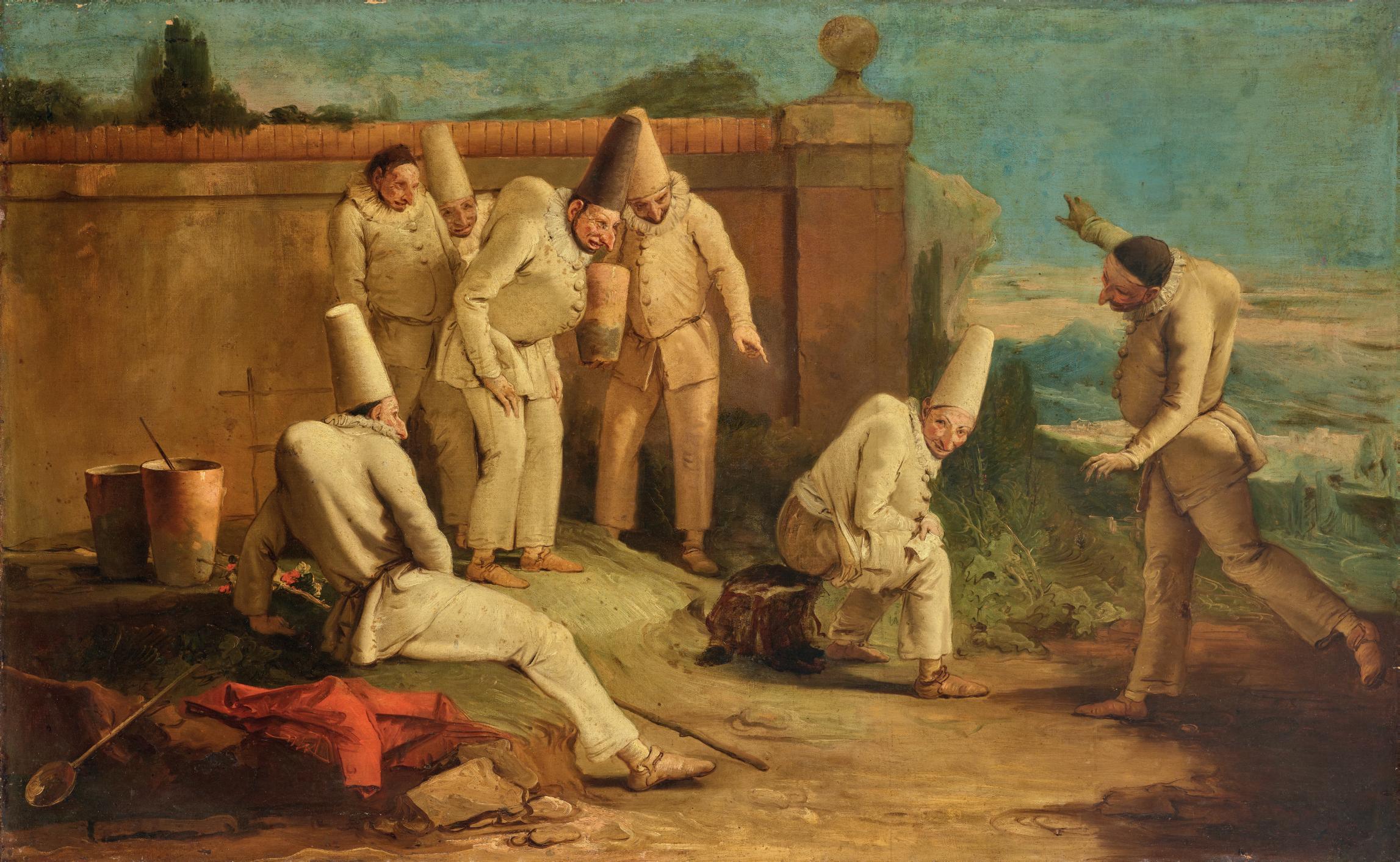
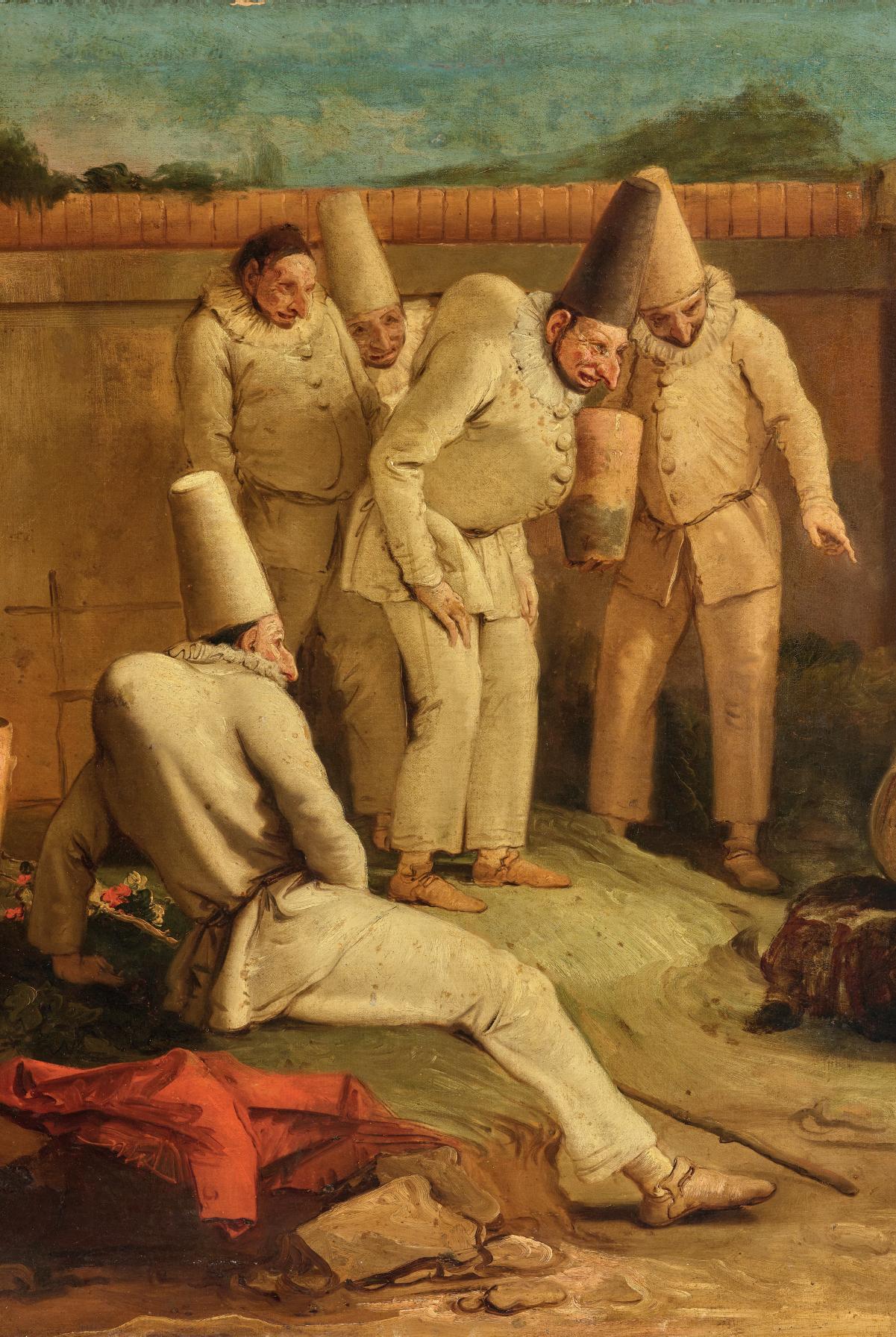

‘I am Prince of everything, Lord of land and main. Except for my public whose faithful servant I remain.’ These are traditionally the final words spoken by Punchinello, one of the stock characters in the Commedia dell’arte. They highlight his essential duality; in different scenes he flits between rich and poor, cunning genius and country bumpkin, sarcastic and sincere. He is a man often lacking in dignity, but who spares those around him from their own embarrassment. His customary appearance: the humpback, crooked nose, gangly legs, the potbelly, and the rosy cheeks, captured so brilliantly here in Giambattista Tiepolo’s swift, almost calligraphic brushstrokes, is inherited from two figures of Ancient Roman Atellan Farce, Maccus and Bucco, respectively a popular clown and a gluttonous fool. All this to say that it is hardly surprising that such a mercurial figure should have inspired arguably the greatest Venetian painter of the eighteenth century.
One of only two known paintings to depict Punchinello executed by Tiepolo, this whimsical composition is reappearing on the art market for the first time in almost a century. As a subject, Punchinello has, over time, come to be more closely associated with Giambattista’s son, Gian Domenico Tiepolo, to whom this work was attributed at the time of its last appearance on the art market in 1934. This is thanks for the most part to two exceptionally famous bodies of work within the oeuvre of the younger Tiepolo: the boisterous frescoes, begun in 1759, that he painted on the walls of the family villa at Zianigo (now in the Ca’ Rezzonico, Venice), where the distinctive characters can be seen cavorting happily through town and country, and his series of 104 drawings, the Divertimento per li regazzi (Entertainment for children), executed at the end of his career (circa 1797-1804), which depict the unfolding life of Punchinello.
Without wishing to detract from Gian Domenico’s achievements, Punchinello is, however, another trope that he inherited from his father. As George Knox explains in his seminal article on the Punchinello works of Giambattista, the artist first began to explore the subject in the 1720s and returned to it sporadically until the end of his life (op. cit.). The group of works connected with the subject is made up of some twenty-two finished drawings, a few fragmentary sketches, a couple of etchings and two major paintings: the present work and its pendant Punchinello cooking, currently in the collection at Leeds Castle (fig. 1).
Two elements set the father’s Punchinello works apart from those of his son. The first, specific to the paintings, is Giambattista’s very liquid handling of his subject matter, with his assured strokes of black outlining the details of the costumes, and the richness of the colouring, which are a far cry from Gian Domenico’s more nervous draftsmanship and slightly zestier colour palette. The second, and more general element, is the choice of activities undertaken by the subjects of the works. Gian Domenico’s compositions in the Divertimento per li Regazzi show Punchinello engaging in a wide range of everyday tasks. However, Giambattista almost exclusively depicts his Punchinello making, eating, overeating and suffering the consequences of over-eating gnocchi.
Punchinello Cooking and Guilty Punchinello depict the beginning and end of this story arc. In the centre of the Leeds Castle composition, one of the Punchinelli sits stirring a large pot of gnocchi, behind him stands another holding bellows, ready to stoke the fire, beyond them is a figure holding a silver platter and in the distance one brandishes a large serving spoon. Guilty Punchinello jumps forward in time. Cooking pots sit on the embers of the fire, the spoon lies discarded on the floor. However, all has not gone to plan. One mischievous Punchinello has evidently stolen and eaten all the gnocchi. He sits on a tree stump listening to his friends’ remonstrations, a mocking figure dancing before him.
A slightly different interpretation of the scene is suggested in some of the literature; in the place of the tree stump some authors have chosen to see a bucket into which the unfortunate thief is defecating, a fitting comeuppance for his crime, no doubt (see for instance G. Knox, 1984, ibid, p. 443). This is, however, not the case, and is likely a reading that comes from the poor quality of the black and white image available and connections to drawings such as Giambattista’s Groupe de Polichinelle regardant l’un d’eux déféquer, (sold Christie’s, Paris, 20 March 2024, lot 18). Recent infrared reflectography of the painting indicates that the stump was always conceived of as such, though some dark brush marks now hidden within the stump's shadows suggest that Tiepolo may have originally considered a more shameful subject.


The gnocchi trope has its roots in the venerdì gnoccolare, a traditional Veronese festival that occurs on the last Friday of Carnival. This dates back to the food shortage of 1531, when the wealthy Tommaso da Vico donated a large sum of money for the poor to buy flour to make gnocchi (and the event is still celebrated with a large parade held each year, led by Papa' de' gnocco – Father Gnocchi). This Veronese connection led Knox to suggest an execution date for Giambattista’s earliest Punchinello drawings of circa 1724-26, when the young artist was working in Verona. In relation to the present painting and its pendant, he proposed an execution date of 1735, possibly earlier (ibid, p. 441). However, others have more plausibly argued for them being much later, suggesting that they were painted circa 1760-1770 (see, for instance, A. Morassi, op. cit., p. 40, G. Piovene and A. Pallucchini, op. cit., p. 133 and S. Loire and J. de Los Llanos, op. cit., p. 232). For Loire and Pallucchini, the wonderfully harmonious colour palette and fluidity of line in the Leeds Castle painting – and, by extension, in the present work – are comparable with works executed at this date in Spain, such as Saint Peter of Alcantara (fig. 2; Madrid, Palacio Real.)
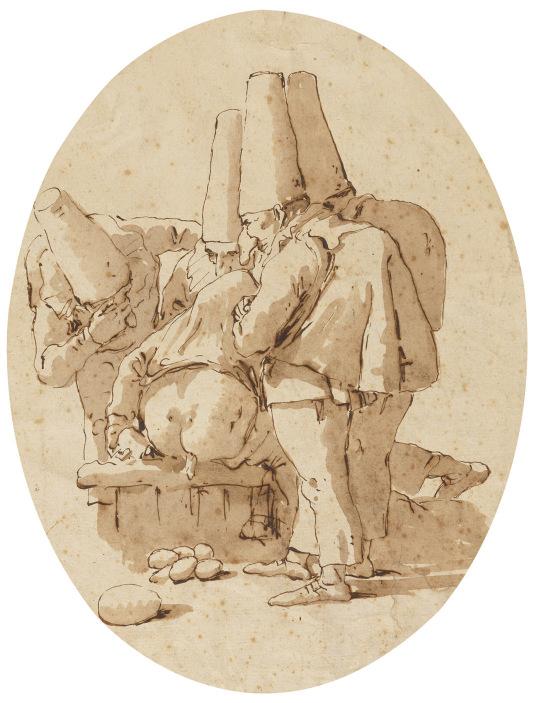
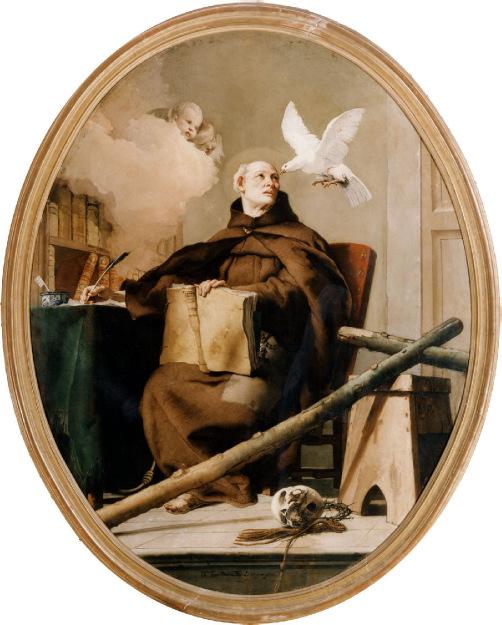
The difference in possible execution dates has led to some speculation as to the early provenance of Punchinello Cooking and Guilty Punchinello. Knox suggests that the pair may have been commissioned by Francesco Scipione Maffei, a Veronese writer and art critic, with whom Tiepolo worked on the illustrations for Verona Illustrata in circa 1730 (G. Knox, 1984, ibid, p. 443). This argument is, however, based on little more than Maffei’s known love of his native city and its folklore. Victoria Sears Goldman makes an argument instead for the Venetian Francesco Algarotti as the original owner of the works. This idea derives from a letter Algarotti wrote to his brother in 1762, in which he talks about having a Punchinello painting restored (V. Sears Goldman, op. cit., p. 523, note 763). Though this has the advantage of being based on a written source, the letter itself refers to the work in question as a ‘quadretto’ or ‘little painting’, and it is quite a stretch to imagine this being used to described either Punchinello canvas.
Though the original commission for Guilty Punchinello must remain, for now at least, an open question, the reappearance in public of such a rare work within Tiepolo’s oeuvre will undoubtedly fan the flames of further research into the history of one of the most mischievous and unusual compositions to be dreamt up by the great Venetian master.



PROPERTY FROM AN IMPORTANT PRIVATE COLLECTION
•*23
MICHELE MARIESCHI (VENICE 1710-1743)
Venice, a stonemason's yard on the Grand Canal, with a view of the Palazzo Ca' Tron, the Palazzo Belloni Battagia, the Fondaco del Megio and the Fondaco dei Turchi; and Venice, the Doge's Palace with the Campanile, the Libreria and Santa Maria della Salute beyond oil on canvas
21¬ x 28¡ in. (54.9 x 72 cm.) in contemporary carved English frames a pair (2)
£600,000-800,000
US$780,000-1,000,000
€730,000-960,000



PROVENANCE:
Sir John Brownlow, Bt., 1st Viscount Tyrconnel (1690-1754), Arlington Street, St. James's, London, by 1738, by whom bequeathed to his sister, Anne Brownlow, Lady Cust (1694-1779), widow of Sir Richard Cust, by whom removed to Belton House, Lincolnshire, and by descent there through her grandson, Sir Brownlow Cust, 1st Baron Brownlow (1744-1807), to,
Sir Peregrine Francis Adelbert Cust, 6th Baron Brownlow, and by descent.
Anonymous sale; Christie's, New York, 15 April 2008, lot 54, where acquired by the present owner.
LITERATURE:
The Goods belonging to the Right Honourable Lord Viscount Tyrconnel in his Lordship's House in Arlington Street, St. James's, London, taken the 22nd and folowing days in May 1738, ms. in the Belton Archives, Lincolnshire record office.
Inventory of Pictures of the Right Hon Viscount Tyrconnel, deceased, taken in Arlington Street, St. James's, 2nd day of April 1754, ms., '2 views of Venice by Marieski & Chenerole' in the Dining Room'.
Mr. Patch's Account of the pictures at Belton, ms., 1779 or shortly after, among four pictures described as 'Canaletti - A View in Venice'.
The Hon. Elizabeth Cust, A Catalogue of the Pictures at Belton House, ms., c. 1805-6, nos. 19-20, described as 'Canaletti - View of Venice: companion to the Former', in the Small Dining Room.
Lady Elizabeth Cust, Records of the Cust Family, II, The Brownlows of Belton, London, 1909, p. 232 (transcript of the 1754 inventory).
F. Russell, 'The Picture Collection at Belton', in the catalogue of Christie's Belton House Sale, 30 April-2 May 1984, p. 162.
R. Toledano, Michele Marieschi. L'opera completa, Milan, 1988, p. 70, no. V.5.1, illustrated.
M. Manzelli, Michele Marieschi e il suo alter-ego Franceso Albotto, Venice, 1991, p. 88, no. A.42.6.
R. Toledano, Michele Marieschi: Catalogo ragionato, 2nd ed., Milan, 1995, pp. 58-59, no. V.5b, illustrated.
F. Montecuccoli degli Erri and F. Pedrocco, Michele Marieschi: La vita, l'ambiente, l'opera, Milan, 1999, pp. 248-9 and 251, no. 29.
Prior to their sale in 2008, these exceptional paintings, which mark a high point in Marieschi's production of views on this scale, had never surfaced on the market or been publicly exhibited, which no doubt contributed to their excellent state of preservation. Toledano (op. cit., 1995) dates them to circa 1737, by comparison with The Grand Canal with the Rialto Bridge from the North and the Arrival of the Patriarch Antonio Correr, 7 February 1735 in the collection of the National Trust at Osterley (fig.1), for which payment was made by Marshal von der Schulenburg on 20 April 1737 (his no. V.II). Pedrocco (op. cit.), who does not accept the identification of the Osterley picture as that painted for Schulenburg, does, however, agree on the stylistic similarities between it and the present pair and dates all three to circa 1735. He further points out that the marble architectural fragments shown in the Campo San Marcuola in the left foreground of the second painting must be related to the work on the construction of a façade designed by Giorgio Massari for the church and begun in 1728; this was terminated in 1736, leaving the façade unfinished, which would seem to provide a terminus ante quem for the execution of these views.
Before 2008, it had not previously been observed that the two paintings were recorded as early as May 1738 in an inventory of the collection of Sir John Brownlow, Bt., 1st Viscount Tyrconnel, in his house in Arlington Street, St. James's, London. They are thus among the few paintings by Marieschi of which the first owner can be identified with certainty. Brownlow had succeeded his father as 5th baronet in 1701, at the age of ten, and made a brief Grand Tour of Italy in the company of his governor T. Latreille between December 1710 and July 1711 (see J. Ingamells, A Dictionary of British and Irish Travellers in Italy 1701-1800 compiled from the Brinsley Ford Archive, New Haven and London, 1997, p. 142). He arrived in Venice on 5 December for the carnival and is next recorded in Rome the following April. After his return he married his cousin Eleanor Brownlow in 1712, and the following year was elected a Member of Parliament, a position he was to hold until 1741. After a period of financial difficulties circa 1715-17, Brownlow's fortunes improved and he became better able to satisfy his appetite for pomp and show. He was elevated to the Irish peerage as Viscount Tyrconnel in 1718 and created one of the first new knights of the recently revived Order of the Bath in 1725. He became a Fellow of the Royal Society in 1735 and a Fellow for the Society of Antiquities in 1740.
Tyrconnel may have been inspired by memories of his Grand Tour to acquire a small group of views of Venice, which also included an exceptional pair of Grand Canal views by Canaletto, also of circa 1735. The Grand Canal, Venice, looking East from the Campo di San Vio, sold at Christie's, New York, 27 January 2000, lot 30 (W.G. Constable, Canaletto, London, 1962, no. 185), was accompanied until the sale of both paintings from Belton in 1956 by a pendant showing The Grand Canal, looking South-West from the Rialto Bridge to the Palazzo Foscari (op. cit., no. 222), sold by Charles Beddington Ltd. in 2015. That pair is recorded in the same inventories of the paintings at Arlington Street, and subsequently Belton, as are the present views. By the time of Mr. Patch's inventory of circa 1779, all four pictures were believed to be by Canaletto. The correct attribution of the present paintings had already been confused in the 1754 inventory, in which they are described as the work of 'Marieski & Chenerole'. This must be a reference to Giovanni Battista Cimaroli, who, though now largely forgotten, was one of the leading rivals of Canaletto and Marieschi in the production of Venetian views. These paintings, however, reveal no trace of his distinctive style and are entirely characteristic of Marieschi, both in the buildings and in the figures.
The view of the Doge's Palace and the Molo from the Bacino di San Marco was one of Marieschi's most popular compositions. The artist himself executed an etching of it, plate 6 in his Magnificentiores Selectioresque Urbis Venetiarum Prospectus published in 1741, and four painted variants, with different boats and figures, are known (Pedrocco, op. cit., nos. 14, 28, 82 and 110). Only one other version of the pendant view The Grand Canal with the Fondaco dei Turchi from the campo San Marcuola is, however, known; that acquired by Henry Howard, 4th Earl of Carlisle, who was in Venice in 1738-39, and now in a Milanese private collection (op. cit., no. 32).
We are grateful to Charles Beddington for preparing this entry.
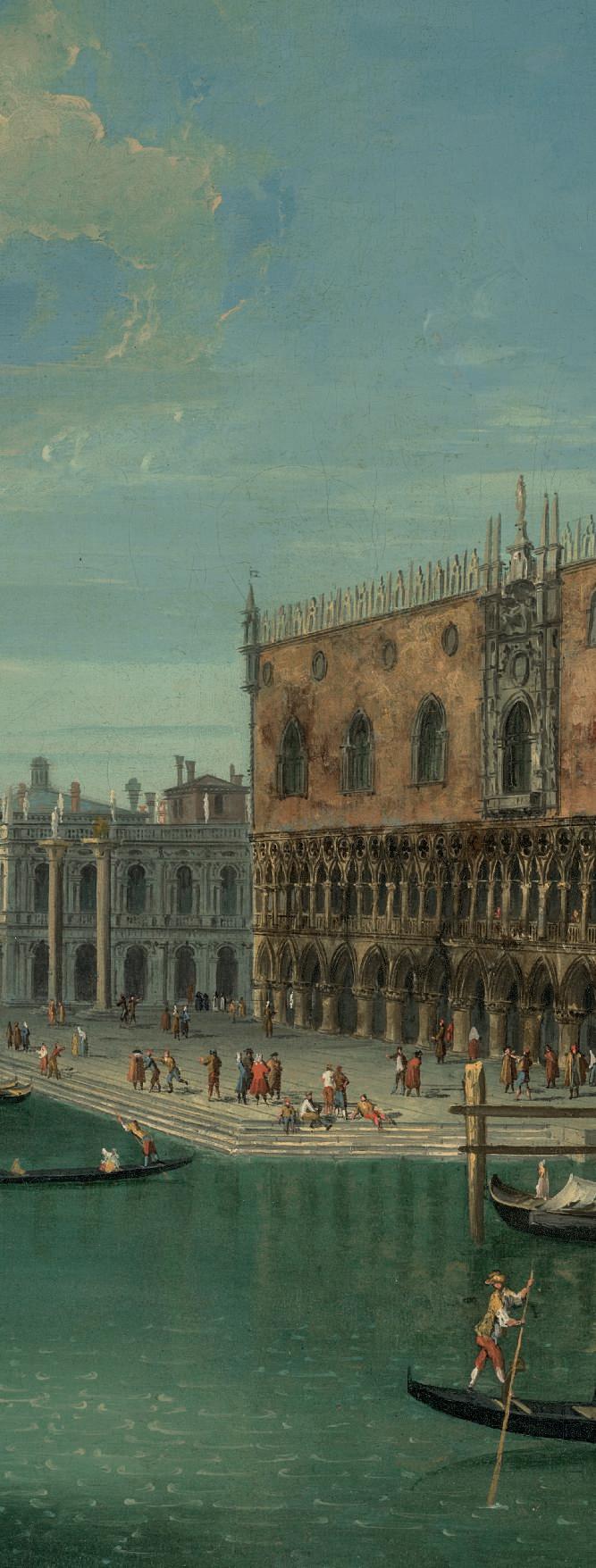

Le poète ou Le sculpteur
signed and dated 'G. Courbet./1845' (lower left)
oil on canvas
22¿ x 16Ω in. (55.9 x 41.9 cm.)
£250,000-350,000
US$330,000-450,000
€310,000-420,000
PROVENANCE:
Sold by the artist in 1845 to a Dutch dealer, probably H.J. van Wisselingh. Coll. V.; Hôtel Drouot, Paris, 12 June 1902, lot 10, for 320 francs. with Galerie Durand-Ruel, Paris. with Galerie Hessel, Paris, by 24 October 1916. with Galerie Georges Bernheim, Paris, by 16 October 1923. Dr. Hans Graber (1886-1959), Zurich, by 1935. with Gallery Knoedler, New York, (inv. A 6415), by 1956. Lore and Rudolf Heinemann sale; Christie's, New York, 22 May 1997, lot 230. Purchased at the above sale by the present owner.
EXHIBITED:
Zurich, Kunsthaus, Gustave Courbet, 15 December 1935- 31 March 1936, no. 12, as 'Le Poète'.
Montclair, Montclair Art Museum, Master Painters, 2 October- 27 October 1957, no. 14. London, Marlborough Gallery, 19th & 20th Century European Masters, Summer 1958, no. 8, fig. 24.
Philadelphia, Philadelphia Museum of Art; Gustave Courbet, 1819 - 1877, 17 December 1959-14 February 1960; this exhibition later travelled to Boston, Museum of Fine Arts, 26 February-14 April 1960, no. 6.
New York, Finch College Museum of Art, 19th & 20th Century French Masters, 1 May- 9 June 1962, no. 8.
Bern, Kunstmuseum Bern, Gustave Courbet, 22 September- 18 November 1962, no. 3. New York, The Trinity School, Nineteenth Century Romantic Painting, 8 February-4 March 1965, no. 8.
Paris, Grand Palais, Gustave Courbet, 30 September- 2 January 1978; this exhibition later travelled to London, The Royal Academy, 18 January- 19 March 1978, no 9. Paris, Grand Palais, Gustave Courbet, 13 October 2007- 28 January 2008, this exhibition later travelled New York, The Metropolitan Museum of Art, 27 February- 18 May 2008, no. 2.
LITERATURE:
C. Leger, Courbet, Paris, 1929, pp. 33-34.
C. Leger, Courbet et son temps, Paris, 1948, pp. 26-27.
A. Fermingera, Courbet, Geneva, 1971, p. 17.
T.J. Clark, Image of the People: Gustave Courbet and the 1848 Revolution, London, 1973, pp. 39-41, 44, fig. 9, illustrated.
M.T. de Forges, Autoportraits de Courbet, Paris, 1973, pp. 28 and 30, illustrated.
R. Fernier, La Vie et l'Oeuvre de Gustave Courbet, I, Lausanne and Paris, 1977, pp. 36-7, no. 58, illustrated.
A. Callen, Courbet, London, 1980, p. 43, illustrated.
S. Faunce and L. Nochlin, Courbet Reconsidered, exh cat., Brooklyn, 1988, pp. 91-92.
M. Fried, Courbet's Realism, Chicago, 1990, pp. 53-64, 67, illustrated.
P. Ten-Doesschate Chu, Letters of Gustave Courbet, Chicago, 1992, p. 56.
S. Faunce, Gustave Courbet, New York, 1993, pp. 11-12, illustrated.
H. Herding, 'Courbet, (Jean-Désiré-) Gustave', in Dictionary of Art, London, 1996, p. 51.
J. Zutter and P. Ten-Doesschate Chu, Courbet, Artiste et Promoteur de son Oeuvre, Paris, 1998, p. 54, fig. 52, illustrated.


The decade between 1840 and 1850 was a transitional period for many young French painters. Courbet, like Jean François Millet, worked in a romantic spirit in the 1840s. Both artists broke with this tradition around 1850 when they each developed their own unique style, styles that would characterize the rest of their careers. Nevertheless, the decade of the 1840s was an interesting time to be a young artist in Paris, and for Courbet, it was a time spent in search of self-expression. Courbet's output from this time included twelve self-portraits executed between 1840 and 1848. They form a series in which Courbet assumed various disguises and dramatic postures. He cast himself in such guises as the dashing companion to a young woman, as a wounded man resting by a tree, as a Mephistophelian gnome playing a game of draughts and as a sculptor dressed in medieval costume.
Painted in 1845, The Sculptor, also called The Poet, was the pendant to Courbet's 1845 Salon entry, Le Guitarrero (fig.1), a painting also once believed to be a self-portrait, but now recognized as a portrait of Courbet's boyhood friend, the violinist, Alphonse Promayat. The two paintings may have been conceived by Courbet as a sort of diptych symbolizing the friendship of the two young men from Franche-Comte. Both sitters are depicted in picturesque and fantastic costumes, very much in the spirit of the Troubador style, which was so popular at the time. They are each set in a rocky terrain which is reminiscent of the landscape of Courbet's native Ornans. Hélène Toussaint (Gustave Courbet, exh. cat., 1977, no. 9) notes that in The Sculptor Courbet painted himself with the emblems of a Masonic apprentice: he is shown sculpting the 'living rock' with a mallet in his right hand and a chisel in his left. Carved in the rock next to him is a woman's head leaning against an amphora from which water is pouring. The connection between water and women is also part of Masonic symbolism. It is not known whether Courbet was in fact a Mason: this was an era in which romantic minds were attracted by secret societies and Courbet may very well have known of the symbolism.
Courbet most likely sold The Sculptor to a Dutch dealer named H.J. Wisselingh, whose portrait he painted in 1846. He wrote the following in a letter to his family dated summer 1845: "Lately I had a visit from a Dutch dealer from Amsterdam who liked my work a lot. He had been making the rounds of the Paris ateliers and he told me that he had not seen anything as much to his liking as what I made. He claims that he will make a name for me in Holland. In the meantime, he has taken two paintings of mine: a small study as big as a hand for which he paid me twenty francs, and another small painting, a pendant of the one I had at the exhibition, for which he paid me four hundred francs." (P. tenDoesschate Chu, 1992, p. 56).
The present work is accompanied by a certificate from the Institut Gustave Courbet dated 12 October 2024, and will be included in their forthcoming Gustave Courbet catalogue raisonné

Bathsheba
oil on canvas
59 x 45Ω in. (149.9 x 115.6 cm.)
£400,000-600,000
US$520,000-780,000
€490,000-720,000
PROVENANCE:
Acquired from the artist by King William I of Württemberg (reigned 1816-64) in 1827, King William II of Württemberg sale; Felix Fleischhauer, Stuttgart, Rosenstein Castle, 10 October and following days, 1922, lot 29. Anonymous sale; Sotheby's, New York, 10 November 1998, lot 55. Purchased at the above sale by the present owner.
EXHIBITED:
Milan, The Brera, 1827, no. 41. Padua, Palazzo Zabarella, Hayez dal mito al bacio, September 1998-January 1999, no. 36
LITERATURE:
F. Hayez, Le mie memorie, Milan, 1890, pp. 63, 275.
S. Coradeschi, L'opera completa di Francesco Hayez, Milan, 1971, p. 92, no. 95a. F. Mazzocca, Francesco Hayez. Catalogo Ragionato, Milan, 1994, p. 180, no. 104.

The biblical narrative featuring the beautiful Bathsheba involves no lesser themes than adultery and bloodshed, divine rebuke and tragic consequences, and the breaking and making of kings. From the roof of his palace, King David sees Bathsheba, wife of Uriah, bathing and he is so taken by lust because of her beauty that he sleeps with her. Her husband Uriah, away at war, is summoned by the king to return home so that Bathsheba can disguise the true source of her resulting pregnancy, but when he refuses to leave the campaign, David orders him moved to the frontline so that he will be slain in battle. David then marries the widowed Bathsheba, who bears a son. In response to their adultery and murder, Nathan the prophet curses David’s House, resulting in the death of the infant conceived in adultery. Bathsheba ensures that their second son, Solomon, becomes David’s successor, and indeed one of the most important kings in the Biblical tradition.
The present work is Francesco Hayez’s first of three paintings on the subject of Bathsheba, and its rediscovery in 1998 was called by Fernando Mazzocca, the great scholar of Hayez, ‘one of the most sensational rediscoveries in the history of 19th century Italian art.’ Bathsheba was entirely of Hayez’s own conception, painted without commission for the 1827 exhibition at the Brera. Hayez described the work in his memoirs as ‘…a Bather, to keep my hand practiced at painting nudes, and also to demonstrate how I liked painting large-scale figures, even when not obliged to do so for clients’ (F. Hayez, Le mie memorie, 1890, p. 63). The only non-commissioned work in the exhibition, it was purchased at the exhibition by King William I of Württemberg, who, not unlike King David before him, was so captivated by the work’s quality and beauty that he purchased it immediately, paying ‘in full the price requested by the artist’ according to contemporary news sources, and taking it home to Stuttgart with him.
While the work’s biblical subject matter made it appropriate for public display, Bathsheba is, above all else, a masterful depiction of a female nude, the kind of which Hayez – who would become famous (perhaps infamous) later in his career for exactly this subject – excelled at. Bathsheba and other traditional iconographic models provided Hayez cover as he explored a new vocabulary of both a marked naturalism and a provocative sensuality. In doing so, he sought to synthesize the examples of the Old Masters, such as Guido Reni, Titian, Domenichino, and Giulio Romano, with the Neoclassical revival of the ‘ideal beauty.’ The result was not the cold, impassive, exaggerated beauties of the Classicists that came before him, but instead the soft and sensual contours of a real woman, elevated to the ideal.
Conscious that he could only push the fleshy display so far, Hayez conceals as much as he reveals, adopting a half-turned position which he would turn to again in one of his most controversial paintings, his Venere che scherza con due colombe (Ritratto della ballerina Carlotta Chabert), of 1830 (fig. 1). The similar bangle, as well as the use of the white drapery behind the figure, suggest its composition might have been worked out around the same time through the use of the same model. Returning to the subject of Bathsheba in 1834 and 1841-42 (fig. 2, Pinacoteca di Brera), Hayez experimented with the adoption of a frontal pose, though he lifts the figure’s foreleg to maintain her modesty.
This first Bathsheba is an important work of Hayez’s early career. Her alert and intelligent gaze draws the viewer into the scene, where we find her pale skin perfectly set off against the dark background of her bath. The smooth line of her body is interrupted only by the golden bangle, slightly too tight against the flesh of her upper arm, though this detail only serves to emphasize her naturalism. In the background, also gazing out at the viewer from the highest extreme of the picture plane, we find the figure of David, already enthralled with his conquest. In its use of colour, execution and quality, Bathsheba is, at every level, an undoubted masterpiece by the artist.

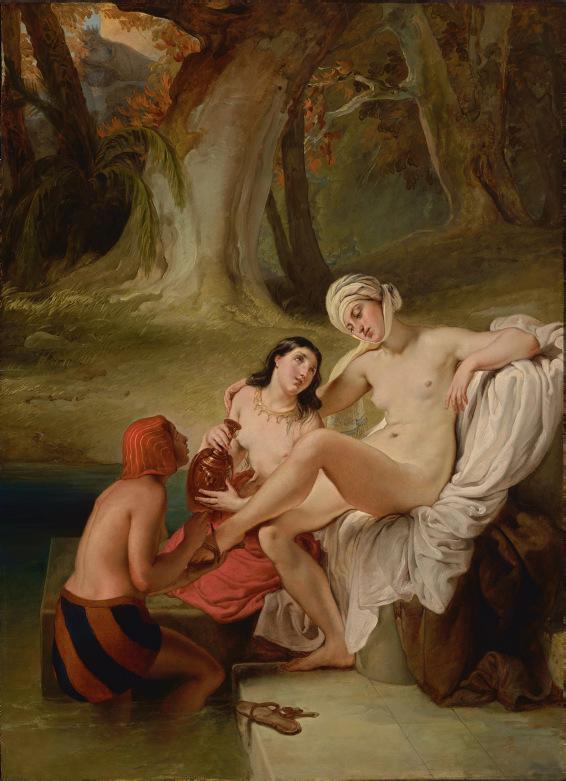
Young girl on Skagen Soenderstrand (Ung pige på Skagen Sønderstrand)
signed with initials and dated ‘m.a.14.’ (lower right)
oil on canvas
34º x 31Ω in. (90.5 x 80 cm.)
£250,000-350,000
US$330,000-450,000
€310,000-420,000
PROVENANCE:
Anonymous sale; Aalborg Craftsmen's Association, circa 1947/48. Purchased from the above sale by a private Danish collector, Thence by descent to the present owner.
EXHIBITED:
Skagen, Art Museums of Skagen, Michael Ancher and the women of Skagen (Michael Ancher og kvinderne fra Skagen), 21 April – 26 August 2018. Skagen, Art Museums of Skagen, Our Artworks, 2020-2022.
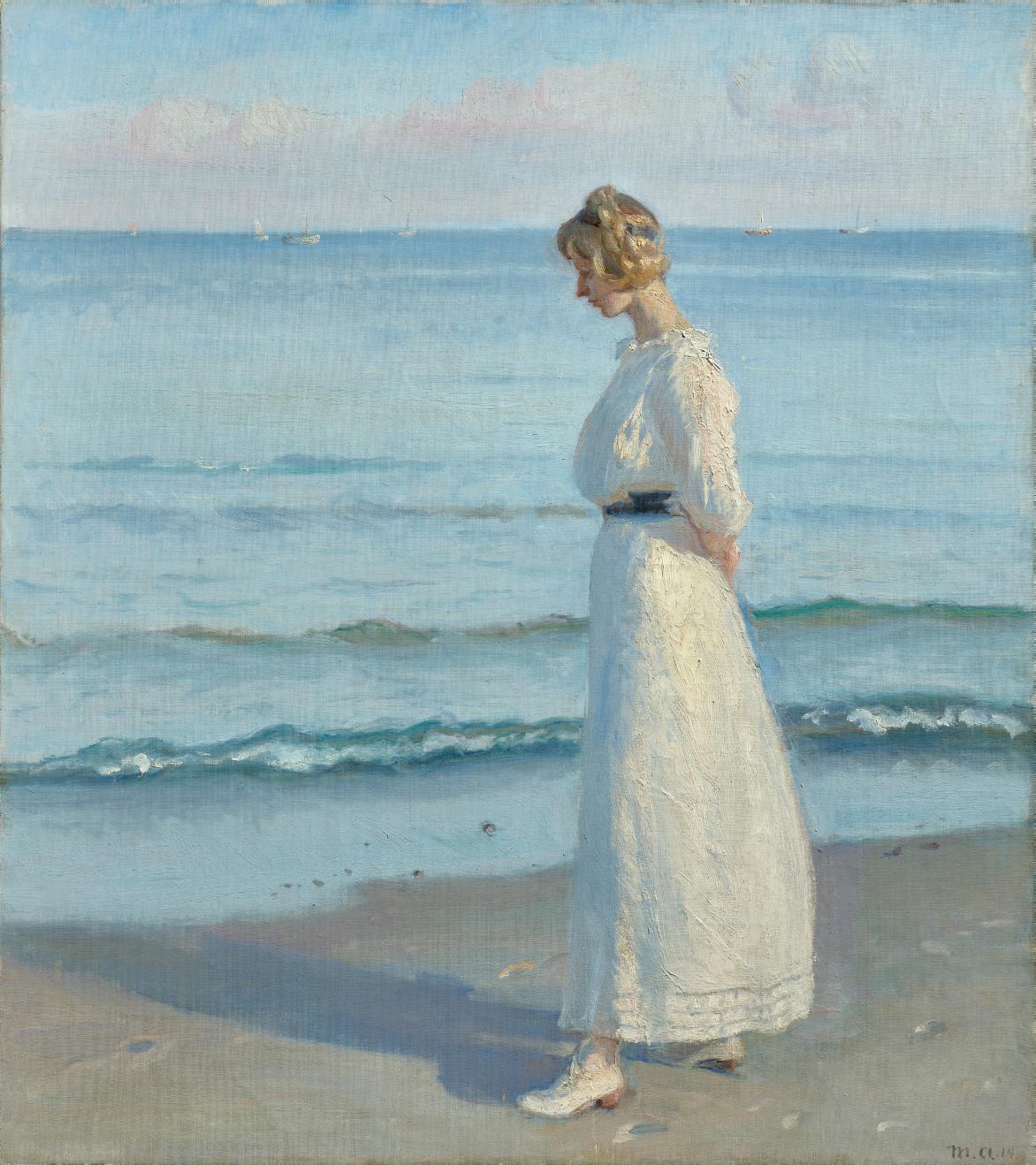
Michael Ancher was persuaded to visit Skagen in 1874 at the prompting of Karl Madsen, a leading Danish painter and art critic, who had relatives living nearby. As Ida Lehrmann Madsen attests “This would turn out to be an excellent move” (I. L. Madsen, ‘Michael Ancher’ in exh. cat. Michael Ancher and the Women of Skagen, 2018, p. 144).
Ancher set up his studio in the garden of Brøndum’s Gæstgiveri (then an inn, later a hotel), the heart of village life and what would become the heart of the Skagen’s painters' colony. It is during this first trip that Michael met the innkeeper’s daughter, a talented artist called Anna Brøndum. The artistic couple married in 1880. Anna “held a key position in the local artists' colony which took root …. in the 1880s, making Skagen a centre for the development of a new poetic realism in Denmark in the three decades that followed” (M. Bogh et. al., exh. cat. Anna Ancher, Copenhagen, 2020, p. 7).
In 1882, at Ancher’s request, P.S. Krøyer visited the artists’ colony at Skagen on the northern tip of Jutland in Denmark. He became both a frequent visitor and a central figure in the colony. Krøyer’s arrival brought with it a change in subject and style in Ancher’s art. His previous representations of the harsh living conditions of the fishing community, depicted in a heavy realist manner, gave way to more serene subjects and a freedom of expression visible in both Ancher’s brushstrokes and a lighter tone. As such, his change in style encapsulates artistic changes in Denmark at the time, seen within the context of the Modern Breakthrough, “meaning the artists associated with 1880s Modernism, [who] shared the belief that painting should be purely visual in nature, that composition should be banished, and that the art of painting should be unshackled from the notions of idealism and narrative content” (E. Fabritius, ‘Ancher and the Men of the Modern Breakthrough’ in ibid., 2020, p. 163).
Like Krøyer, Ancher became fascinated with the marvellous light playing over Skagen beach and its inhabitants. This was seen on a grand scale in the late 1890s in the near identical works, A Stroll on the Beach (fig. 1) and Summer Atmosphere (fig. 2). As Elisabeth Fabritius attests: “The artist’s source of inspiration is quite obvious: P.S. Krøyer’s evening scene, finished shortly before Ancher began work on his, depicting two other young women, Anna Ancher and Marie Krøyer, seen from behind on a summer evening” (E. Fabritus, ‘A Stroll on the Beach and Summer Atmosphere, 1895-7’, in ibid, 2018, p. 69). Here, the soft light infuses the scene and the figure, whose quiet reflective stance echoes the calm of the waves gently rolling on the shore.
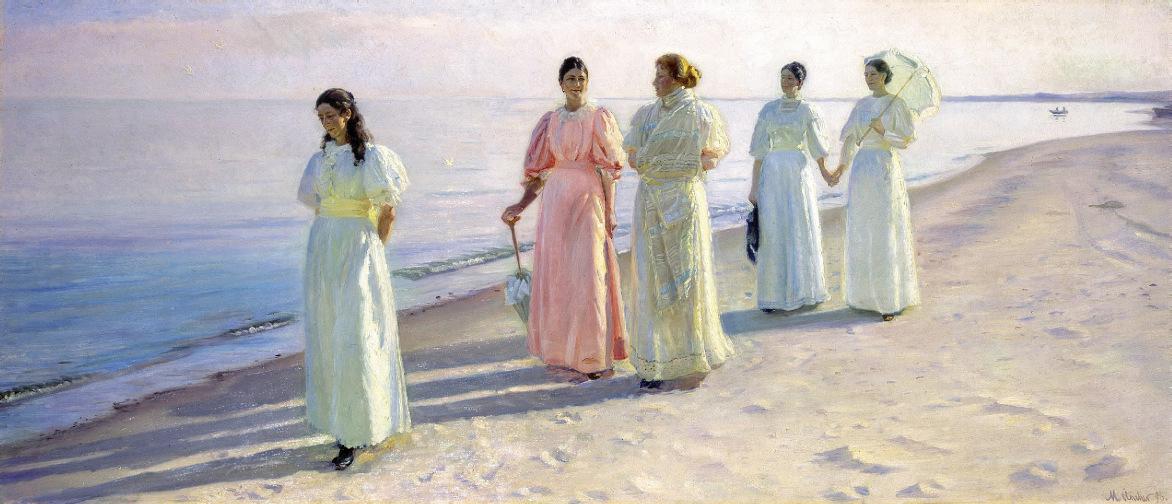


Wednesday 4 December 2024 at 10.30 am
8 King Street, St. James’s London SW1Y 6QT
Friday 29 November 9.00 am - 5.00 pm
Saturday 30 November 12.00 pm - 5.00 pm
Sunday 1 December 12.00 pm - 5.00 pm
Monday 2 December 9.00 am - 8.00 pm
Tuesday 3 December 9.00 am - 5.00 pm
Clementine Sinclair, Olivia Ghosh and Zack Boutwood
In sending absentee bids or making enquiries, this sale should be referred to as 22692-AMELIE
Tel: +44 (0)20 7389 2658
Fax: +44 (0)20 7930 8870
The sale of each lot is subject to the Conditions of Sale, Important Notices and Explanation of Cataloguing Practice, which are set out in this catalogue and on christies.com. Please note that the symbols and cataloguing for some lots may change before the auction. For the most up to date sale information for a lot, please see the full lot description, which can be accessed through the sale landing page on christies.com.
In addition to the hammer price, a Buyer’s Premium (plus VAT) is payable. Other taxes and/or an Artist Resale Royalty fee are also payable if the lot has a tax or λ symbol.
Check Section D of the Conditions of Sale at the back of this catalogue. Estimates in a currency other than pounds sterling are approximate and for illustration purposes only.



The Meeting of Alexander the Great and Roxana, behind a trompe l'oeil curtain oil on canvas
32¡ x 26æ in. (83.2 x 68 cm.)
£50,000-80,000
US$65,000-100,000
€60,000-96,000
Howth and Ireland's Eye pencil, watercolour and bodycolour, with scratching out, on wove paper 11º x 16æ in. (28.7 x 42.7 cm.)
£60,000-100,000
US$78,000-130,000
€72,000-120,000
Lady MacBeth
black chalk with stumping, on wove paper, unframed 17 x 12º in. (43.2 x 31.2 cm.)
£20,000-30,000
US$26,000-39,000 €24,000-36,000
PROPERTY FROM THE MOUGINS MUSEUM OF CLASSICAL ART
ALESSANDRO TURCHI, CALLED
(VERONA 1578-1649 ROME)
The Abduction of Helen with inscription 'Aless.ro Orb[etto ?] Veronese', the last two words written over with 'Roma Farnese' (verso)
black chalk, pen and brown ink and brown wash on laid paper 10¿ x 15¡ in. (25.7 x 39 cm.)
£10,000-15,000
US$13,000-19,000
€12,000-18,000

PROPERTY FROM THE MOUGINS MUSEUM OF CLASSICAL ART
ALESSANDRO TURCHI, CALLED
(VERONA 1578-1649 ROME)
The Abduction of Helen oil on Verona ‘marble’
15æ x 19º in. (40 x 48.7 cm.)
£60,000-80,000
US$78,000-100,000
€72,000-96,000

JACQUES-LAURENT AGASSE (GENEVA 1767-1849 LONDON)
Head of a leopard; and Head of a lion oil on panel
the first: 8Ω x 7 in. (21.7 x 17.9 cm.); the second: 8Ω x 7 in. (21.7 x 17.9 cm.) in contemporary composition frames a pair (2)
£25,000-35,000
US$33,000-45,000
€30,000-42,000

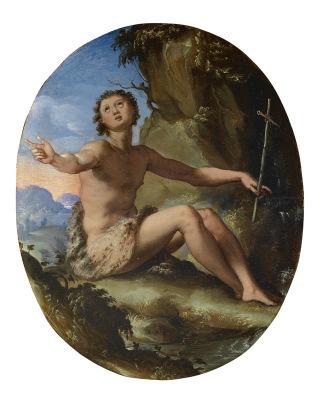

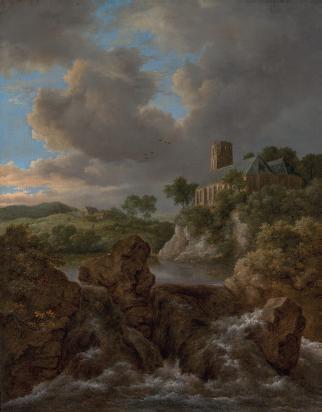
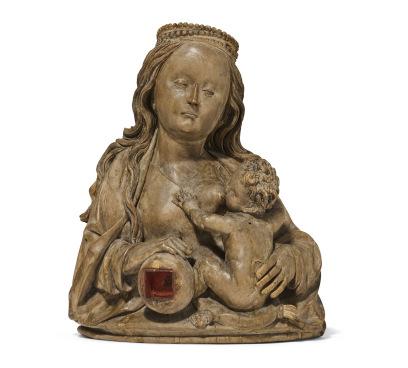
PROPERTY FROM A DISTINGUISHED PRIVATE COLLECTION
Saint John the Baptist in the Wilderness signed '•A•A•F' (on the rock, lower centre) oil on copper, oval
6 x 4√ in. (15.2 x 12.5 cm.)
£50,000-70,000
US$65,000-91,000
€60,000-84,000
PROPERTY OF A GENTLEMAN FOLLOWER OF TOMMASO 'DEL PORFIDO' FEDELE (1598-1658 ROME), SECOND HALF 17TH CENTURY
Reclining Venus porphyry; with a scallop shell to the naturalistic base, set within a later marble bow-ended base
5√ in. (15 cm) high; 24. 3/8 in. (62 cm.) wide
£25,000-35,000
US$33,000-45,000
€30,000-42,000
A wooded river landscape with a waterfall, a church and farm beyond indistinctly signed 'JRuisdael' ('JR' linked, lower right, on rock to the right of waterfall) oil on canvas
26Ω x 20Ω in. (67.3 x 52 cm.)
£40,000-60,000
US$52,000-78,000
€48,000-72,000
PROPERTY RESTITUTED TO THE HEIRS OF JAKOB GOLDSCHMIDT CIRCLE OF THE
Virgin and Child (Virgo Lactans)
limewood, reliquary group; the reverse inscribed '329', the underside inscribed '3-8527.' and '7-6827', and with two paper lablels iscribed '337' and 'I?.Nr./8527' 9in. (23cm.) high
£25,000-40,000
US$33,000-52,000
€30,000-48,000
Calypso lamenting the departure of Ulysses oil on copper, oval
11¿ x 8¬ in. (28.2 x 21.9 cm.)
£15,000-20,000
US$20,000-26,000
€18,000-24,000
Sunset over a rocky bay
signed and dated 'J. Martin. 1839 [?]' (lower left) pencil and watercolour, heightened with touches of bodycolour and with scratching out on paper
93/8 x 145/8 in. (23.8 x 37.1 cm.)
£40,000-60,000
US$52,000-78,000
€48,000-72,000
Saint Jerome in his study oil on panel
26¬ x 18√ in. (67.8 x 48 cm.)
£40,000-60,000
US$52,000-78,000
€48,000-72,000
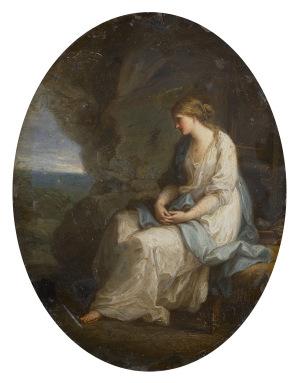

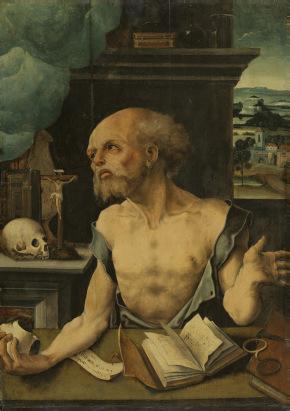
Portrait of Sir Thomas Wyatt the Younger (c.1521-1544), in profile oil on panel, roundel, with the brand of King Charles I (1600-1649) on the reverse 14 in. (35.5 cm.) diameter
£40,000-60,000
US$52,000-78,000
€48,000-72,000
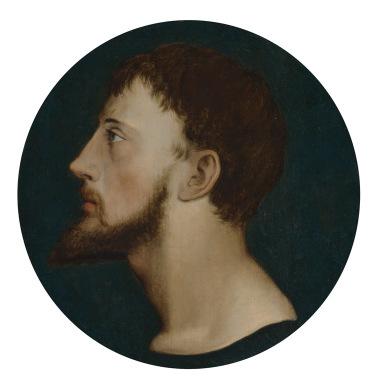
CONDITIONS OF SALE
These Conditions of Sale and the Important Notices and Explanation of Cataloguing Practice set out the terms on which we offer the lots listed in this catalogue for sale. By registering to bid and/or by bidding at auction you agree to these terms, so you should read them carefully before doing so. You will find a glossary at the end explaining the meaning of the words and expressions coloured in bold. As well as these Conditions of Sale, lots in which we offer Non-Fungible Tokens for sale are governed by the Additional Conditions of Sale – NonFungible Tokens, which can be found at Appendix A to these Conditions of Sale. For the sale of Non-Fungible Tokens, to the extent there is a conflict between the “London Conditions of Sale Buying at Christie’s” and “Additional Conditions of Sale – Non-Fungible Tokens”, the latter controls.
Unless we own a lot ( symbol), Christie’s acts as agent for the seller. This means that we are providing services to the seller to help them sell their lot and that Christie’s is concluding the contract for the sale of the lot on behalf of the seller. When Christie’s is the agent of the seller, the contract of sale which is created by any successful bid by you for a lot will be directly between you and the seller, and not between you and Christie’s.
• BEFORE THE SALE
A
1
• DESCRIPTION OF LOTS
(a) Certain words used in the catalogue description have special meanings. You can find details of these on the page headed ‘Important Notices and Explanation of Cataloguing Practice’ which forms part of these terms. You can find a key to the Symbols found next to certain catalogue entries under the section of the catalogue called ‘Symbols Used in this Catalogue’.
(b) Our description of any lot in the catalogue, any condition report and any other statement made by us (whether orally or in writing) about any lot including about its nature or condition artist, period, materials, approximate dimensions or provenance are our opinion and not to be relied upon as a statement of fact. We do not carry out in-depth research of the sort carried out by professional historians and scholars. All dimensions and weights are approximate only.
2
• OUR RESPONSIBILITY FOR OUR DESCRIPTION OF LOTS
We do not provide any guarantee in relation to the nature of a lot apart from our authenticity warranty contained in paragraph E2 and to the extent provided in paragraph I below.
• CONDITION
3
(a) The condition of lots sold in our auctions can vary widely due to factors such as age, previous damage, restoration, repair and wear and tear. Their nature means that they will rarely be in perfect condition Lots are sold ‘as is’, in the condition they are in at the time of the sale, without any representation or warranty or assumption of liability of any kind as to condition by Christie’s or by the seller.
(b) Any reference to condition in a catalogue entry or in a condition report will not amount to a full description of condition, and images may not show a lot clearly. Colours and shades may look different in print or on screen to how they look on physical inspection. Condition reports may be available to help you evaluate the condition of a lot Condition reports are provided free of charge as a convenience to our buyers and are for guidance only. They offer our opinion but they may not refer to all faults, inherent defects, restoration, alteration or adaptation because our staff are not professional restorers or conservators. For that reason they are not an alternative to examining a lot in person or taking your own professional advice. It is your responsibility to ensure that you have requested, received and considered any condition report.
• VIEWING LOTS PRE-AUCTION
4
(a) If you are planning to bid on a lot, you should inspect it personally or through a knowledgeable representative before you make a bid to make sure that you accept the description and its condition. We recommend you get your own advice from a restorer or other professional adviser.
(b) Pre-auction viewings are open to the public free of charge. Our specialists may be available to answer questions at pre-auction viewings or by appointment.
5
• ESTIMATES
Estimates are based on the condition, rarity, quality and provenance of the lots and on prices recently paid at auction for similar property. Estimates can change. Neither you, nor anyone else, may rely on any estimates as a prediction or guarantee of the actual selling price of a lot or its value for any other purpose. Estimates do not include the buyer’s premium or any applicable taxes.
• WITHDRAWAL
6
Christie’s may, at its option, withdraw any lot at any time prior to or during the sale of the lot. Christie’s has no liability to you for any decision to withdraw.
7 • JEWELLERY
(a) Coloured gemstones (such as rubies, sapphires and emeralds) may have been treated to improve their look, through methods such as heating and oiling. These methods are accepted by the international jewellery trade but may make the gemstone less strong and/or require special care over time.
(b) It will not be apparent to us whether a diamond is naturally or synthetically formed unless it has been tested by a gemmological laboratory. Where the diamond has been tested, a gemmological report will be available.
(c) All types of gemstones may have been improved by some method. You may request a gemmological report for any item which does not have a report if the request is made to us at least three weeks before the date of the auction and you pay the fee for the report.
(d) Certain weights in the catalogue description are provided for guidance purposes only as they have been estimated through measurement and, as such, should not be relied upon as exact.
(e) We do not obtain a gemmological report for every gemstone sold in our auctions. Where we do get gemmological reports from internationally accepted gemmological laboratories, such reports will be described in the catalogue. Reports from American gemmological laboratories will
describe any improvement or treatment to the gemstone. Reports from European gemmological laboratories will describe any improvement or treatment only if we request that they do so, but will confirm when no improvement or treatment has been made. Because of differences in approach and technology, laboratories may not agree whether a particular gemstone has been treated, the amount of treatment or whether treatment is permanent. The gemmological laboratories will only report on the improvements or treatments known to the laboratories at the date of the report. We do not guarantee nor are we responsible for any report or certificate from a gemmological laboratory that may accompany a lot
(f) For jewellery sales, estimates are based on the information in any gemmological report or, if no report is available, assume that the gemstones may have been treated or enhanced.
8 • WATCHES & CLOCKS
(a) Almost all clocks and watches are repaired in their lifetime and may include parts which are not original. We do not give a warranty that any individual component part of any watch or clock is authentic Watchbands described as ‘associated’ are not part of the original watch and may not be authentic. Clocks may be sold without pendulums, weights or keys.
(b) As collectors’ watches and clocks often have very fine and complex mechanisms, a general service, change of battery or further repair work may be necessary, for which you are responsible. We do not give a warranty that any watch or clock is in good working order. Certificates are not available unless described in the catalogue.
(c) Most watches have been opened to find out the type and quality of movement. For that reason, watches with water resistant cases may not be waterproof and we recommend you have them checked by a competent watchmaker before use. Important information about the sale, transport and shipping of watches and watchbands can be found in paragraph H2(g).
B • REGISTERING TO BID
1 • NEW BIDDERS
(a) If this is your first time bidding at Christie’s or you are a returning bidder who has not bought anything from any of our salerooms within the last two years you must register at least 48 hours before an auction to give us enough time to process and approve your registration. We may, at our option, decline to permit you to register as a bidder. You will be asked for the following:
(i) for individuals: Photo identification (driving licence, national identity card or passport) and, if not shown on the ID document, proof of your current address (for example, a current utility bill or bank statement).
(ii) for corporate clients: Your Certificate of Incorporation or equivalent document(s) showing your name and registered address together with documentary proof of directors and beneficial owners; and (iii) for trusts, partnerships, offshore companies and other business structures, please contact us in advance to discuss our requirements.
(b) We may also ask you to give us a financial reference and/or a deposit as a condition of allowing you to bid. For help, please contact our Credit Department on +44 (0)20 7839 9060.
2
• RETURNING BIDDERS
We may at our option ask you for current identification as described in paragraph B1(a) above, a financial reference or a deposit as a condition of allowing you to bid. If you have not bought anything from any of our salerooms in the last two years or if you want to spend more than on previous occasions, please contact our Credit Department on +44 (0)20 7839 9060.
• IF YOU FAIL TO PROVIDE THE RIGHT DOCUMENTS
3
If in our opinion you do not satisfy our bidder identification and registration procedures including, but not limited to completing any anti-money laundering and/or anti-terrorism financing checks we may require to our satisfaction, we may refuse to register you to bid, and if you make a successful bid, we may cancel the contract for sale between you and the seller.
• BIDDING ON BEHALF OF ANOTHER PERSON
4
(a) As authorised bidder. If you are bidding on behalf of another person who will pay Christie’s directly, that person will need to complete the registration requirements above before you can bid, and supply a signed letter authorising you to bid for them.
(b) As agent for a principal: If you register in your own name but are acting as agent for someone else (the “ultimate buyer(s)”) who will put you in funds before you pay us, you accept personal liability to pay the purchase price and all other sums due. We will require you to disclose the identity of the ultimate buyer(s) and may require you to provide documents to verify their identity in accordance with paragraph E3(b).
5
• BIDDING IN PERSON
If you wish to bid in the saleroom you must register for a numbered bidding paddle at least 30 minutes before the auction. You may register online at www.christies.com or in person. For help, please contact the Credit Department on +44 (0)20 7839 9060.
• BIDDING SERVICES
6
The bidding services described below are a free service offered as a convenience to our clients and Christie’s is not responsible for any error (human or otherwise), omission or breakdown in providing these services.
(a) Phone Bids
Your request for this service must be made no later than 24 hours prior to the auction. We will accept bids by telephone for lots only if our staff are available to take the bids. If you need to bid in a language other than in English, you must arrange this well before the auction. We may record telephone bids. By bidding on the telephone, you are agreeing to us recording your conversations. You also agree that your telephone bids are governed by these Conditions of Sale.
(b) Internet Bids on Christie’s LIVE™
For certain auctions we will accept bids over the Internet. For more information, please visit www.christies.com/register-and-bid As well as these Conditions of Sale, internet bids are governed by the Christie’s LIVE™ Terms of Use which are available at www.christies.com/christieslive-terms
c) Written Bids
You can find a Written Bid Form at any Christie’s office or by choosing the sale and viewing the lots online at www.christies.com. We must receive your completed Written Bid at least 24 hours before the auction. Bids must be placed in the currency of the saleroom. The auctioneer will take reasonable steps to carry out written bids at the lowest possible price, taking into account the reserve. If you make a written bid on a lot which does not have a reserve and there is no higher bid than yours, we will bid on your behalf at around 50% of the low estimate or, if lower, the amount of your bid. If we receive written bids on a lot for identical amounts, and at the auction these are the highest bids on the lot, we will sell the lot to the bidder whose written bid we received first.
• CONDUCTING THE SALE
C
1
• WHO CAN ENTER THE AUCTION
We may, at our option, refuse admission to our premises or decline to permit participation in any auction or to reject any bid.
• RESERVES
2
Unless otherwise indicated, all lots are subject to a reserve. We identify lots that are offered without reserve with the symbol • next to the lot number. The reserve cannot be more than the lot’s low estimate, unless the lot is subject to a third party guarantee and the irrevocable bid exceeds the printed low estimate. In that case, the reserve will be set at the amount of the irrevocable bid. Lots which are subject to a third party guarantee arrangement are identified in the catalogue with the symbol º♦
3 • AUCTIONEER’S DISCRETION
The auctioneer can at their sole option:
(a) refuse any bid; (b) move the bidding backwards or forwards in any way they may decide, or change the order of the lots; (c) withdraw any lot; (d) divide any lot or combine any two or more lots; (e) reopen or continue the bidding even after the hammer has fallen; and (f) in the case of error or dispute related to bidding and whether during or after the auction, to continue the bidding, determine the successful bidder, cancel the sale of the lot, or reoffer and resell any lot. If you believe that the auctioneer has accepted the successful bid in error, you must provide a written notice detailing your claim within 3 business days of the date of the auction. The auctioneer will consider such claim in good faith. If the auctioneer in the exercise of their discretion under this paragraph, decides after the auction is complete, to cancel the sale of a lot, or reoffer and resell a lot, they will notify the successful bidder no later than by the end of the 7th calendar day following the date of the auction. The auctioneer’s decision in exercise of this discretion is final. This paragraph does not in any way prejudice Christie’s ability to cancel the sale of a lot under any other applicable provision of these Conditions of Sale, including the rights of cancellation set forth in section B(3), E(2)(i), F(4) and J(1).
4
• BIDDING
The auctioneer accepts bids from: (a) bidders in the saleroom; (b) telephone bidders, and internet bidders through ‘Christie’s LIVE™ (as shown above in Section B6); and (c) written bids (also known as absentee bids or commission bids) left with us by a bidder before the auction.
5
• BIDDING ON BEHALF OF THE SELLER
The auctioneer may, at their sole option, bid on behalf of the seller up to but not including the amount of the reserve either by making consecutive bids or by making bids in response to other bidders. The auctioneer will not identify these as bids made on behalf of the seller and will not make any bid on behalf of the seller at or above the reserve If lots are offered without reserve, the auctioneer will generally decide to open the bidding at 50% of the low estimate for the lot If no bid is made at that level, the auctioneer may decide to go backwards at their sole option until a bid is made, and then continue up from that amount. In the event that there are no bids on a lot the auctioneer may deem such lot unsold.
6 • BID INCREMENTS
Bidding generally starts below the low estimate and increases in steps (bid increments). The auctioneer will decide at their sole option where the bidding should start and the bid increments.
7 • CURRENCY CONVERTER
The saleroom video screens (and Christies LIVE™) may show bids in some other major currencies as well as sterling. Any conversion is for guidance only and we cannot be bound by any rate of exchange used. Christie’s is not responsible for any error (human or otherwise), omission or breakdown in providing these services.
8 • SUCCESSFUL BIDS
Unless the auctioneer decides to use their discretion as set out in paragraph C3 above, when the auctioneer’s hammer strikes, we have accepted the last bid. This means a contract for sale has been formed between the seller and the successful bidder. We will issue an invoice only to the registered bidder who made the successful bid. While we send out invoices by post and/or email after the auction, we do not accept responsibility for telling you whether or not your bid was successful. If you have bid by written bid, you should contact us by telephone or in person as soon as possible after the auction to get details of the outcome of your bid to avoid having to pay unnecessary storage charges.
• LOCAL BIDDING LAWS
9
You agree that when bidding in any of our sales that you will strictly comply with all local laws and regulations in force at the time of the sale for the relevant sale site.
D • THE BUYER’S PREMIUM, TAXES AND ARTIST’S RESALE ROYALTY
1 • THE BUYER’S PREMIUM
In addition to the hammer price, the successful bidder agrees to pay us a buyer’s premium on the hammer price of each lot sold. On all lots we charge 26% of the hammer price up to and including £800,000, 21% on that part of the hammer price over £800,000 and up to and including £4,500,000, and 15.0% of that part of the hammer price above £4,500,000. VAT will be added to the buyer’s premium and is payable by you. For lots offered under the VAT Margin Scheme or Temporary Admission VAT rules, the VAT may not be shown separately on our invoice because of tax laws. You may be eligible to have a VAT refund in certain circumstances if the lot is exported. Please see the “VAT refunds: what can I reclaim?” section of ‘VAT Symbols and Explanation’ for further information.
2 • TAXES
The successful bidder is responsible for all applicable tax including any VAT, GST, sales or compensating use tax or equivalent tax wherever such taxes may arise on the hammer price and the buyer’s premium VAT charges and refunds depend on the particular circumstances of the buyer. It is the buyer’s responsibility to ascertain and pay all taxes due. VAT is payable on the buyer’s premium and, for some lots, VAT is payable on the hammer price. Following the departure of the UK from the EU (Brexit), UK VAT and Customs rules will apply only. For lots Christie’s ships or delivers to the United States, sales or use tax may be due on the hammer price, buyer’s premium and/or any other charges related to the lot, regardless of the nationality or citizenship of the purchaser. Christie’s will collect sales tax where legally required.
The applicable sales tax rate will be determined based upon the state, county, or locale to which the lot will be shipped or delivered. Successful bidders claiming an exemption from sales tax must provide appropriate documentation to Christie’s prior to the release of the lot. For shipments/deliveries to those states for which Christie’s is not required to collect sales tax, a successful bidder may be required to remit use tax to that state’s taxing authorities. Christie’s recommends you obtain your own independent tax advice with further questions.
For lots Christie’s ships or delivers to Jersey (Channel Islands), GST at a rate of 5% will be due on the hammer price, buyer’s premium, freight charges (as set out on your Shipping Quote Acceptance Form) and any applicable customs duty. Christie’s will collect GST from you, where legally required to do so.
For lots purchased by a successful bidder with a registered address in India and who has bid via Christie’s LIVE™, an Indian Equalisation Levy Tax at a rate of 2% will be due on the hammer price and buyer’s premium (exclusive of any applicable VAT) Christie’s will collect the Indian Equalisation Levy Tax from you, where required to do so.
• ARTIST’S RESALE ROYALTY
3
In certain countries, local laws entitle the artist or the artist’s estate to a royalty known as ‘artist’s resale right’ when any lot created by the artist is sold. We identify these lots with the λ symbol next to the lot number. If these laws apply to a lot, you must pay us an extra amount equal to the royalty. We will pay the royalty to the appropriate authority on the seller’s behalf.
The artist’s resale royalty applies if the hammer price of the lot is 1,000 GBP or more if located in the United Kingdom at the time of sale. The total royalty for any lot cannot be more than 12,500 GBP. We work out the amount owed as follows:
Royalty for the portion of the hammer price (in Pound Sterling)
4% up to 50,000
3% between 50,000.01 and 200,000
1% between 200,000.01 and 350,000
0.50% between 350,000.01 and 500,000 over 500,000, the lower of 0.25% and 12,500 GBP.
E • WARRANTIES
1
• SELLER’S WARRANTIES
For each lot, the seller gives a warranty that the seller:
(a) is the owner of the lot or a joint owner of the lot acting with the permission of the other co-owners or, if the seller is not the owner or a joint owner of the lot, has the permission of the owner to sell the lot, or the right to do so in law; and
(b) has the right to transfer ownership of the lot to the buyer without any restrictions or claims by anyone else.
If one or more of the above warranties are incorrect, the seller shall not have to pay more than the purchase price (as defined in paragraph F1(a) below) paid by you to us. The seller will not be responsible to you for any reason for loss of profits or business, expected savings, loss of opportunity or interest, costs, damages, other damages or expenses. The seller gives no warranty in relation to any lot other than as set out above and, as far as the seller is allowed by law, all warranties from the seller to you, and all other obligations upon the seller which may be added to this agreement by law, are excluded.
• OUR AUTHENTICITY WARRANTY
2
We warrant, subject to the terms below, that the lots in our sales are authentic (our ‘authenticity warranty’). If, within five years of the date of the auction, you give notice to us that your lot is not authentic, subject to the terms below, we will refund the purchase price paid by you. The meaning of authentic can be found in the glossary at the end of these Conditions of Sale. The terms of the authenticity warranty are as follows:
(a) It will be honoured for claims notified within a period of five years from the date of the auction. After such time, we will not be obligated to honour the authenticity warranty
(b) It is given only for information shown in UPPERCASE type in the first line of the catalogue description (the ‘Heading’). It does not apply to any information other than in the Heading even if shown in UPPERCASE type
(c) The authenticity warranty does not apply to any Heading or part of a Heading which is qualified Qualified means limited by a clarification in a lot’s catalogue description or by the use in a Heading of one of the terms listed in the section titled Qualified Headings on the page of the catalogue headed ‘Important Notices and Explanation of Cataloguing Practice’. For example, use of the term ‘ATTRIBUTED TO…’ in a Heading means that the lot is in Christie’s opinion probably a work by the named artist but no warranty is provided that the lot is the work of the named artist. Please read the full list of Qualified Headings and a lot’s full catalogue description before bidding.
(d) The authenticity warranty applies to the Heading as amended by any Saleroom notice
(e) The authenticity warranty does not apply where scholarship has developed since the auction leading to a change in generally accepted opinion. Further, it does not apply if the Heading either matched the generally accepted opinion of experts at the date of the sale or drew attention to any conflict of opinion.
(f) The authenticity warranty does not apply if the lot can only be shown not to be authentic by a scientific process which, on the date we published the catalogue, was not available or generally accepted for use, or which was unreasonably expensive or impractical, or which was likely to have damaged the lot
(g) The benefit of the authenticity warranty is only available to the original buyer shown on the invoice for the lot issued at the time of the sale and only if, on the date of the notice of claim, the original buyer is the full owner of the lot and the lot is free from any claim, interest or restriction by anyone else. The benefit of this authenticity warranty may not be transferred to anyone else.
(h) In order to claim under the authenticity warranty, you must:
(i) give us written notice of your claim within five years of the date of the auction. We may require full details and supporting evidence of any such claim;
(ii) at Christie’s option, we may require you to provide the written opinions of two recognised experts in the field of the lot mutually agreed by you and us in advance confirming that the lot is not authentic. If we have any doubts, we reserve the right to obtain additional opinions at our expense; and
(iii) return the lot at your expense to the saleroom from which you bought it in the condition it was in at the time of sale.
(i) Your only right under this authenticity warranty is to cancel the sale and receive a refund of the purchase price paid by you to us. We will not, in any circumstances, be required to pay you more than the purchase price nor will we be liable for any loss of profits or business, loss of opportunity or value, expected savings or interest, costs, damages, other damages or expenses.
(j) Books Where the lot is a book, we give an additional warranty for 14 days from the date of the sale that if on collation any lot is defective in text or illustration, we will refund your purchase price, subject to the following terms:
(i) This additional warranty does not apply to:
(a) the absence of blanks, half titles, tissue guards or advertisements, damage in respect of bindings, stains, spotting, marginal tears or other defects not affecting completeness of the text or illustration;
(b) drawings, autographs, letters or manuscripts, signed photographs, music, atlases, maps or periodicals;
(c) books not identified by title;
(d) lots sold without a printed estimate;
(e) books which are described in the catalogue as sold not subject to return; or (f) defects stated in any condition report or announced at the time of sale.
(ii) To make a claim under this paragraph you must give written details of the defect and return the lot to the sale room at which you bought it in the same condition as at the time of sale, within 14 days of the date of the sale.
(K) South East Asian Modern and Contemporary Art and Chinese Calligraphy and Painting.
In these categories, the authenticity warranty does not apply because current scholarship does not permit the making of definitive statements. Christie’s does, however, agree to cancel a sale in either of these two categories of art where it has been proven the lot is a forgery. Christie’s will refund to the original buyer the purchase price in accordance with the terms of Christie’s authenticity warranty, provided that the original buyer notifies us with full supporting evidence documenting the forgery claim within twelve (12) months of the date of the auction. Such evidence must be satisfactory to us that the lot is a forgery in accordance with paragraph E2(h)(ii) above and the lot must be returned to us in accordance with E2h(iii) above. Paragraphs E2(b), (c), (d), (e), (f) and (g) and (i) also apply to a claim under these categories.
(l) Chinese, Japanese and Korean artefacts (excluding Chinese, Japanese and Korean calligraphy, paintings, prints, drawings and jewellery).
In these categories, paragraph E2 (b) – (e) above shall be amended so that where no maker or artist is identified, the authenticity warranty is given not only for the Heading but also for information regarding date or period shown in UPPERCASE type in the second line of the catalogue description (the “SubHeading”). Accordingly, all references to the Heading in paragraph E2 (b) – (e) above shall be read as references to both the Heading and the SubHeading
3 • YOUR WARRANTIES
(a) You warrant that the funds used for settlement are not connected with any criminal activity, including tax evasion, and you are neither under investigation, nor have you been charged with or convicted of money laundering, terrorist activities or other crimes.
(b) Where you are bidding as agent on behalf of any ultimate buyer(s) who will put you in funds before you pay Christie’s for the lot(s), you warrant that:
(i) you have conducted appropriate customer due diligence on the ultimate buyer(s) and have complied with all applicable anti-money laundering, counter terrorist financing and sanctions laws;
(ii) you will disclose to us the identity of the ultimate buyer(s) (including any officers and beneficial owner(s) of the ultimate buyer(s) and any persons acting on its behalf) and on our request, provide documents to verify their identity;
(iii) the arrangements between you and the ultimate buyer(s) in relation to the lot or otherwise do not, in whole or in part, facilitate tax crimes;
(iv) you do not know, and have no reason to suspect that the ultimate buyer(s) (or its officers, beneficial owners or any persons acting on its behalf) are on a sanctions list, are under investigation for, charged with or convicted of money laundering, terrorist activities or other crimes, or that the funds used for settlement are connected with the proceeds of any criminal activity, including tax evasion; and
(v) where you are a regulated person who is supervised for anti-money laundering purposes under the laws of the EEA or another jurisdiction with requirements equivalent to the EU 4th Money Laundering Directive, and we do not request documents to verify the ultimate buyer’s identity at the time of registration, you consent to us relying on your due diligence on the ultimate buyer, and will retain their identification and verification documents for a period of not less than 5 years from the date of the transaction. You will make such documentation available for immediate inspection on our request.
• PAYMENT
F
1
• HOW TO PAY
(a) Immediately following the auction, you must pay the purchase price being:
(i) the hammer price; and
(ii) the buyer’s premium; and
(iii) any amounts due under section D3 above; and
(iv) any duties, goods, sales, use, compensating or service tax or VAT.
Payment is due no later than by the end of the seventh calendar day following the date of the auction, or no later than 24 hours after we issue you with an invoice in the case of payment made in cryptocurrency, as the case may be (the ‘due date’).
(b) We will only accept payment from the registered bidder. Once issued, we cannot change the buyer’s name on an invoice or re-issue the invoice in a different name. You must pay immediately even if you want to export the lot and you need an export licence.
(c) You must pay for lots bought at Christie’s in the United Kingdom in the currency stated on the invoice in one of the following ways:
(i) Wire transfer
You must make payments to: Lloyds Bank Plc, City Office, PO Box 217, 72 Lombard Street, London EC3P 3BT. Account number: 00172710, sort code: 30-00-02 Swift code: LOYDGB2LCTY. IBAN (international bank account number): GB81 LOYD 3000 0200 1727 10.
(ii) Credit Card
We accept most major credit cards subject to certain conditions. You may make payment via credit card in person. You may also make a ‘cardholder not present’ (CNP) payment by calling Christie’s Post-Sale Services Department on +44 (0)20 7752 3200 or for some sales, by logging into your MyChristie’s account by going to: www.christies. com/mychristies. Details of the conditions and restrictions applicable to credit card payments are available from our Post-Sale Services Department, whose details are set out in paragraph (e) below.
If you pay for your purchase using a credit card issued outside the region of the sale, depending on the type of credit card and account you hold, the payment may incur a cross-border transaction fee. If you think this may apply to, you, please check with your credit card issuer before making the payment.
Please note that for sales that permit online payment, certain transactions will be ineligible for credit card payment.
(iii) Cash
We accept cash subject to a maximum of £5,000 per buyer per year at our Cashier’s Department only (subject to conditions).
(iv) Banker’s draft
You must make these payable to Christie’s and there may be conditions.
(v) Cheque
You must make cheques payable to Christie’s. Cheques must be from accounts in pounds sterling (GBP) from a United Kingdom bank.
(vi) Cryptocurrency
With the exception of clients resident in Mainland China, payment for a lot marked with the symbol may be made in a cryptocurrency or cryptocurrencies of our choosing. Such cryptocurrency payments must be made in accordance with the Terms for Payment by Buyers in Cryptocurrency set out at Appendix B in these Conditions of Sale.
(d) You must quote the sale number, lot number(s), your invoice number and Christie’s client account number when making a payment. All payments sent by post must be sent to: Christie’s, Cashiers Department, 8 King Street, St James’s, London, SW1Y 6QT.
(e) For more information please contact our Post-Sale Service Department by phone on +44 (0)20 7752 3200 or fax on +44 (0)20 752 3300.
2
• TRANSFERRING OWNERSHIP TO YOU
You will not own the lot and ownership of the lot will not pass to you until we have received full and clear payment of the purchase price even in circumstances where we have released the lot to the buyer.
3 • TRANSFERRING RISK TO YOU
The risk in and responsibility for the lot will transfer to you from whichever is the earlier of the following:
(a) When you collect the lot; or
(b) At the end of the 30th day following the date of the auction or, if earlier, the date the lot is taken into care by a third-party warehouse as set out on the page headed ‘Storage and Collection’, unless we have agreed otherwise with you in writing.
• WHAT HAPPENS IF YOU DO NOT PAY
4
(a) If you fail to pay us the purchase price in full by the due date, we will be entitled to do one or more of the following (as well as enforce our rights under paragraph F5 and any other rights or remedies we have by law):
(i)to charge interest from the due date at a rate of 5% a year above the UK Lloyds Bank base rate from time to time on the unpaid amount due;
(ii) we can cancel the sale of the lot. If we do this, we may sell the lot again, publicly or privately on such terms we shall think necessary or appropriate, in which case you must pay us any shortfall between the purchase price and the proceeds from the resale. You must also pay all costs, expenses, losses, damages and legal fees we have to pay or may suffer and any shortfall in the seller’s commission on the resale;
(iii) we can pay the seller an amount up to the net proceeds payable in respect of the amount bid by your default in which case you acknowledge and understand that Christie’s will have all of the rights of the seller to pursue you for such amounts;
(iv) we can hold you legally responsible for the purchase price and may begin legal proceedings to recover it together with other losses, interest, legal fees and costs as far as we are allowed by law;
(v) we can take what you owe us from any amounts which we or any company in the Christie’s Group may owe you (including any deposit or other part-payment which you have paid to us);
(vi) we can, at our option, reveal your identity and contact details to the seller;
(vii) we can reject at any future auction any bids made by or on behalf of the buyer or to obtain a deposit from the buyer before accepting any bids;
(viii) to exercise all the rights and remedies of a person holding security over any property in our possession owned by you, whether by way of pledge, security interest or in any other way as permitted by the law of the place where such property is located. You will be deemed to have granted such security to us and we may retain such property as collateral security for your obligations to us; and
(ix) we can take any other action we see necessary or appropriate.
(b) If you owe money to us or to another Christie’s Group company, we can use any amount you do pay, including any deposit or other partpayment you have made to us, or which we owe you, to pay off any amount you owe to us or another Christie’s Group company for any transaction.
(c) If you make payment in full after the due date, and we choose to accept such payment we may charge you storage and transport costs from the date that is 30 calendar days following the auction in accordance with paragraphs Gc and Gd.
5
• KEEPING YOUR PROPERTY
If you owe money to us or to another Christie’s Group company, as well as the rights set out in F4 above, we can use or deal with any of your property we hold or which is held by another Christie’s Group company in any way we are allowed to by law. We will only release your property to you after you pay us or the relevant Christie’s Group company in full for what you owe.
However, if we choose, we can also sell your property in any way we think appropriate. We will use the proceeds of the sale against any amounts you owe us and we will pay any amount left from that sale to you. If there is a shortfall, you must pay us any difference between the amount we have received from the sale and the amount you owe us.
• COLLECTION AND STORAGE
G
(a) You must collect purchased lots within thirty days from the auction (but note that lots will not be released to you until you have made full and clear payment of all amounts due to us).
(b) Information on collecting lots is set out on the Storage and Collection page and on an information sheet which you can get from the bidder registration staff or Christie’s Post-Sale Services Department on +44 (0)20 7752 3200.
(c) If you do not collect any lot within thirty days following the auction we can, at our option:
(i) charge you storage costs at the rates set out at www.christies.com/ storage.
(ii) move the lot to another Christie’s location or an affiliate or third party warehouse and charge you transport costs and administration fees for doing so and you will be subject to the third party storage warehouse’s standard terms and to pay for their standard fees and costs.
(iii) sell the lot in any commercially reasonable way we think appropriate.
(d) The Storage Conditions which can be found at www.christies.com/ storage will apply.
• TRANSPORT AND SHIPPING
H
1
• TRANSPORT AND SHIPPING
We will enclose a transport and shipping form with each invoice sent to you. You must make all transport and shipping arrangements. However, we can arrange to pack, transport and ship your property if you ask us to and pay the costs of doing so. We recommend that you ask us for an estimate, especially for any large items or items of high value that need professional packing before you bid. We may also suggest other handlers, packers, transporters or experts if you ask us to do so. For more information, please contact Christie’s Art Transport on +44 (0)20 7839 9060. See the information set out at www.christies.com/ shipping or contact us at arttransportlondon@christies.com. We will take reasonable care when we are handling, packing, transporting and shipping a lot. However, if we recommend another company for any of these purposes, we are not responsible for their acts, failure to act or neglect.
• EXPORT AND IMPORT
2
Any lot sold at auction may be affected by laws on exports from the country in which it is sold and the import restrictions of other countries Many countries require a declaration of export for property leaving the country and/or an import declaration on entry of property into the country. Local laws may prevent you from importing a lot or may prevent you selling a lot in the country you import it into. We will not be obliged to cancel your purchase and refund the purchase price if your lot may not be exported, imported or it is seized for any reason by a government authority. It is your responsibility to determine and satisfy the requirements of any applicable laws or regulations relating to the export or import of any lot you purchase.
(a) You alone are responsible for getting advice about and meeting the requirements of any laws or regulations which apply to exporting or importing any lot prior to bidding. If you are refused a licence or there is a delay in getting one, you must still pay us in full for the lot. We may be able to help you apply for the appropriate licences if you ask us to and pay our fee for doing so. However, we cannot guarantee that you will get one. For more information, please contact Christie’s Art Transport Department on +44 (0)20 7839 9060. See the information set out at www.christies.com/shipping or contact us at arttransport_ london@ christies.com.
(b) You alone are responsible for any applicable taxes, tariffs or other government-imposed charges relating to the export or import of the lot If Christie’s exports or imports the lot on your behalf, and if Christie’s pays these applicable taxes, tariffs or other government-imposed charges, you agree to refund that amount to Christie’s.
(c) Lots made of protected species
Lots made of or including (regardless of the percentage) endangered and other protected species of wildlife are marked with the symbol ~ in the catalogue. This material includes, among other things, ivory, tortoiseshell, crocodile skin, rhinoceros horn, whalebone, certain species of coral, and Brazilian rosewood. You should check the relevant customs laws and regulations before bidding on any lot containing wildlife material if you plan to export the lot from the country in which the lot is sold and import it into another country as a licence may be required. In some cases, the lot can only be shipped with an independent scientific confirmation of species and/or age, and you will need to obtain these at your own cost. Several countries have imposed restrictions on dealing in elephant ivory, ranging from a total ban on importing African elephant ivory in the United States to importing, exporting and selling under strict measures in other countries. The UK and EU have both implemented regulations on selling, exporting and importing elephant ivory. In our London sales, lots made of or including elephant ivory material are marked with the symbol and are offered with the benefit of being registered as ‘exempt’ in accordance with the UK Ivory Act. Handbags containing endangered or protected species material are marked with the symbol ≈ and further information can be found in paragraph H2(h) below. We will not be obliged to cancel your purchase and refund the purchase price if your lot may not be exported, imported or it is seized for any reason by a government authority. It is your responsibility to determine and satisfy the requirements of any applicable laws or regulations relating to the export or import of property containing such protected or regulated material.
(d) Lots of Iranian origin
As a convenience to buyers, Christie’s indicates under the title of a lot if the lot originates from Iran (Persia). Some countries prohibit or restrict the purchase and/or import of Iranian-origin property. It is your responsibility to ensure you do not bid on or import a lot in contravention of any sanctions, trade embargoes or other laws that apply to you. For example, the USA prohibits dealings in and import of Iranian-origin “works of conventional craftsmanship” (such as carpets, textiles, decorative objects, and scientific instruments) without an appropriate licence. Christie’s has a general OFAC licence which, subject to compliance with certain conditions, may enable a buyer to import this type of lot into the USA. If you use Christie’s general OFAC licence for this purpose, you agree to comply with the licence conditions and provide Christie’s with all relevant information. You also acknowledge that Christie’s will disclose your personal information and your use of the licence to OFAC.
(e) Gold
Gold of less than 18ct does not qualify in all countries as ‘gold’ and may be refused import into those countries as ‘gold’.
(f) Jewellery over 50 years old
Under current laws, jewellery over 50 years old which is worth £39,219 or more will require an export licence which we can apply for on your behalf. It may take up to eight weeks to obtain the export jewellery licence.
(g) Watches
Many of the watches offered for sale in this catalogue are pictured with straps made of endangered or protected animal materials such as alligator or crocodile. These lots are marked with the symbol ψ in the catalogue. These endangered species straps are shown for display purposes only and are not for sale. Christie’s will remove and retain the strap prior to shipment from the sale site. At some sale sites, Christie’s may, at its discretion, make the displayed endangered species strap available to the buyer of the lot free of charge if collected in person from the sale site within one year of the date of the sale. Please check with the department for details on a particular lot. For all symbols and other markings referred to in paragraph H2, please note that lots are marked as a convenience to you, but we do not accept liability for errors or for failing to mark lots
(h) Handbags
A lot marked with the symbol ≈ next to the lot number includes endangered or protected species material and is subject to CITES regulations. This lot may only be shipped to an address within the country of the sale site or personally picked up from our saleroom. The term “hardware” refers to the metallic parts of the handbag, such as the buckle hardware, base studs, lock and keys and/or strap, which are plated with a coloured finish (e.g. gold, silver, palladium). The terms “Gold Hardware”, “Silver Hardware”, “Palladium Hardware”, etc. refer to the tone or colour of the hardware and not the actual material used. If the handbag incorporates solid metal hardware, this will be referenced in the catalogue description.
I • OUR LIABILITY TO YOU
(a) We give no warranty in relation to any statement made, or information given, by us or our representatives or employees, about any lot other than as set out in the authenticity warranty and, as far as we are allowed by law, all warranties and other terms which may be added to this agreement by law are excluded. The seller’s warranties contained in paragraph E1 are their own and we do not have any liability to you in relation to those warranties
(b) (i) We are not responsible to you for any reason (whether for breaking this agreement or any other matter relating to your purchase of, or bid for, any lot) other than in the event of fraud or fraudulent misrepresentation by us or other than as expressly set out in these Conditions of Sale; or (ii) we do not give any representation, warranty or guarantee or assume any liability of any kind in respect of any lot with regard to merchantability, fitness for a particular purpose, description, size, quality, condition, attribution, authenticity, rarity, importance, medium, provenance, exhibition history, literature, or historical relevance. Except as required by local law, any warranty of any kind is excluded by this paragraph.
(c) In particular, please be aware that our written and telephone bidding services, Christie’s LIVE™, condition reports, currency converter and saleroom video screens are free services and we are not responsible to you for any error (human or otherwise), omission or breakdown in these services.
(d) We have no responsibility to any person other than a buyer in connection with the purchase of any lot
(e) If, in spite of the terms in paragraphs (a) to (d) or E2(i) above, we are found to be liable to you for any reason, we shall not have to pay more than the purchase price paid by you to us. We will not be responsible to you for any reason for loss of profits or business, loss of opportunity or value, expected savings or interest, costs, damages, or expenses.
J
• OTHER TERMS
1 • OUR ABILITY TO CANCEL
In addition to the other rights of cancellation contained in this agreement, we can cancel a sale of a lot if: (i) any of your warranties in paragraph E3 are not correct; (ii) we reasonably believe that completing the transaction is or may be unlawful; or (iii) we reasonably believe that the sale places us or the seller under any liability to anyone else or may damage our reputation.
• RECORDINGS
2
We may videotape and record proceedings at any auction. We will keep any personal information confidential, except to the extent disclosure is required by law. However, we may, through this process, use or share these recordings with another Christie’s Group company and marketing partners to analyse our customers and to help us to tailor our services for buyers. If you do not want to be videotaped, you may make arrangements to make a telephone or written bid or bid on Christie’s LIVE™ instead. Unless we agree otherwise in writing, you may not videotape or record proceedings at any auction.
• COPYRIGHT
3
We own the copyright in all images, illustrations and written material produced by or for us relating to a lot (including the contents of our catalogues unless otherwise noted in the catalogue). You cannot use them without our prior written permission. We do not offer any guarantee that you will gain any copyright or other reproduction rights to the lot
5
4
• ENFORCING THIS AGREEMENT
If a court finds that any part of this agreement is not valid or is illegal or impossible to enforce, that part of the agreement will be treated as being deleted and the rest of this agreement will not be affected.
• TRANSFERRING YOUR RIGHTS AND RESPONSIBILITIES
You may not grant a security over or transfer your rights or responsibilities under these terms on the contract of sale with the buyer unless we have given our written permission. This agreement will be binding on your successors or estate and anyone who takes over your rights and responsibilities.
• TRANSLATIONS
6
If we have provided a translation of this agreement, we will use this original version in deciding any issues or disputes which arise under this agreement.
• PERSONAL INFORMATION
7
We will hold and process your personal information and may pass it to another Christie’s Group company for use as described in, and in line with, our privacy notice at www.christies.com/about-us/contact/ privacy and if you are a resident of California you can see a copy of our California Consumer Privacy Act statement at https://www.christies. com/about-us/contact/ccpa
• WAIVER
8
No failure or delay to exercise any right or remedy provided under these Conditions of Sale shall constitute a waiver of that or any other right or remedy, nor shall it prevent or restrict the further exercise of that or any other right or remedy. No single or partial exercise of such right or remedy shall prevent or restrict the further exercise of that or any other right or remedy.
• LAW AND DISPUTES
9
This agreement, and any contractual or non-contractual dispute arising out of or in connection with this agreement, will be governed by English law. Before either you or we start any court proceedings and if you and we agree, you and we will try to settle the dispute by mediation in accordance with the CEDR Model Mediation Procedure. If the dispute is not settled by mediation, you agree for our benefit that the dispute will be referred to and dealt with exclusively in the English courts; however, we will have the right to bring proceedings against you in any other court.
•REPORTING ON WWW.CHRISTIES.COM
10
Details of all lots sold by us, including catalogue descriptions and prices, may be reported on www.christies.com. Sales totals are hammer price plus buyer’s premium and do not reflect costs, financing fees, or application of buyer’s or seller’s credits. We regret that we cannot agree to requests to remove these details from www.christies.com
K • GLOSSARY
auctioneer: the individual auctioneer and/or Christie’s. authentic: a genuine example, rather than a copy or forgery of:
(i) the work of a particular artist, author or manufacturer, if the lot is described in the Heading as the work of that artist, author or manufacturer;
(ii) a work created within a particular period or culture, if the lot is described in the Heading as a work created during that period or culture;
(iii) a work for a particular origin source if the lot is described in the Heading as being of that origin or source; or
(iv) in the case of gems, a work which is made of a particular material, if the lot is described in the Heading as being made of that material.
authenticity warranty: the guarantee we give in this agreement that a lot is authentic as set out in section E2 of this agreement.
buyer’s premium: the charge the buyer pays us along with the hammer price
catalogue description: the description of a lot in the catalogue for the auction, as amended by any saleroom notice
Christie’s Group: Christie’s International Plc, its subsidiaries and other companies within its corporate group.
condition: the physical condition of a lot
due date: has the meaning given to it in paragraph F1(a).
estimate: the price range included in the catalogue or any saleroom notice within which we believe a lot may sell. Low estimate means the lower figure in the range and high estimate means the higher figure. The mid estimate is the midpoint between the two.
hammer price: the amount of the highest bid the auctioneer accepts for the sale of a lot
Heading: has the meaning given to it in paragraph E2.
SubHeading: has the meaning given to it in paragraph E2. lot: an item to be offered at auction (or two or more items to be offered at auction as a group).
other damages: any special, consequential, incidental or indirect damages of any kind or any damages which fall within the meaning of ‘special’, ‘incidental’ or ‘consequential’ under local law.
purchase price: has the meaning given to it in paragraph F1(a).
provenance: the ownership history of a lot
qualified: has the meaning given to it in paragraph E2 and Qualified Headings means the section headed Qualified Headings on the page of the catalogue headed ‘Important Notices and Explanation of Cataloguing Practice’.
reserve: the confidential amount below which we will not sell a lot saleroom notice: a written notice posted next to the lot in the saleroom and on www.christies.com, which is also read to prospective telephone bidders and notified to clients who have left commission bids, or an announcement made by the auctioneer either at the beginning of the sale, or before a particular lot is auctioned.
UPPER CASE type: means having all capital letters.
warranty: a statement or representation in which the person making it guarantees that the facts set out in it are correct.
IMPORTANT NOTICE:
The VAT liability in force on the date of the sale will be the rules under which we invoice you. You can find the meanings of words in bold on this page in the glossary section of the Conditions of Sale.
VAT PAYABLE
Symbol
No Symbol
†
θ
We will use the VAT Margin Scheme in accordance with Section 50A of the VAT Act 1994 & SI VAT (Special Provisions) Order 1995.
No VAT will be charged on the hammer price VAT at 20% will be added to the buyer’s premium but will not be shown separately on our invoice.
We will invoice under standard VAT rules and VAT will be charged at 20% on both the hammer price and buyer’s premium and shown separately on our invoice. For qualifying books only, no VAT is payable on the hammer price or the buyer’s premium
* These lots have been imported from outside the UK for sale and placed under the Temporary Admission regime. Import VAT is payable at 5% on the hammer price. VAT at 20% will be added to the buyer’s premium but will not be shown separately on our invoice.
Ω These lots have been imported from outside the UK for sale and placed under the Temporary Admission regime. Customs Duty as applicable will be added to the hammer price and Import VAT at 20% will be charged on the Duty Inclusive hammer price. VAT at 20% will be added to the buyer’s premium but will not be shown separately on our invoice.
α The VAT treatment will depend on whether you have registered to bid with a UK address or non-UK address:
• If you register to bid with an address within the UK you will be invoiced under the VAT Margin Scheme (see No Symbol above).
• If you register to bid with an address outside of the UK you will be invoiced under standard VAT rules (see † symbol above)
‡ For wine offered ‘in bond’ only. If you choose to buy the wine in bond no Excise Duty or Clearance VAT will be charged on the hammer If you choose to buy the wine out of bond Excise Duty as applicable will be added to the hammer price and Clearance VAT at 20% will be charged on the Duty inclusive hammer price
Whether you buy the wine in bond or out of bond, 20% VAT will be added to the buyer’s premium and shown on the invoice.
VAT refunds: what can I reclaim?
Non-UK buyer If you meet ALL of the conditions in notes 1 to 3 below we will refund the following tax charges:
No symbol We will refund the VAT amount in the buyer’s premium
and α We will refund the VAT charged on the hammer price. VAT on the buyer’s premium can only be refunded if you are an overseas business. The VAT amount in the buyer’s premium cannot be refunded to non-trade clients.
‡ (wine only)
No Excise Duty or Clearance VAT will be charged on the hammer price providing you export the wine while ‘in bond’ directly outside the UK using an Excise authorised shipper. VAT on the buyer’s premium can only be refunded if you are an overseas business. The VAT amount in the buyer’s premium cannot be refunded to non-trade clients.
* and Ω We will refund the Import VAT charged on the hammer price and the VAT amount in the buyer’s premium
1. We CANNOT offer refunds of VAT amounts or Import VAT to buyers who do not meet all applicable conditions in full. If you are unsure whether you will be entitled to a refund, please contact Client Services at the address below before you bid.
2. No VAT amounts or Import VAT will be refunded where the total refund is under £100.
3. To receive a refund of VAT amounts/ Import VAT (as applicable) a non-UK buyer must:
a) have registered to bid with an address outside of the UK; and
b) provide immediate proof of correct export out of the UK within the
required time frames of: 30 days of collection via a ‘controlled export’, but no later than 90 days from the date of the sale for * and Ωlots. All other lots must be exported within 90 days of the sale.
4. Details of the documents which you must provide to us to show satisfactory proof of export/ shipping are available from our VAT team at the address below. We charge a processing fee of £35.00 per invoice to check shipping/ export documents. We will waive this processingfeeifyouappointChristie’s Shipping Department to arrange your export/shipping.
COPYRIGHT NOTICE
No part of this catalogue may be reproduced, stored in a retrieval system or transmitted by any form or by any means, electronic, mechanical, photocopying, recording or otherwise, without the prior written permission of Christie’s.
© COPYRIGHT, CHRISTIE, MANSON & WOODS LTD. (2024)
5. Following the UK’s departure from the EU (Brexit), private buyers will only be able to secure VAT-free invoicing and/or VAT refunds if they instruct Christie’s or a third party commercial shipper to export out of the UK on their behalf.
6. Private buyers who choose to export their purchased lots from the UK hand carry will now be charged VAT at the applicable rate and will not be able to claim a VAT refund.
7. If you appoint Christie’s Art Transport or one of our authorised shippers to arrange your export/ shipping we will issue you with an export invoice with the applicable VAT or duties cancelled as outlined above. If you later cancel or change the shipment in a manner that infringes the rules outlined above we will issue a revised invoice charging you all applicable taxes/ charges. If you export via a third party commercial shipper, you must provide us with sufficient proof of export in order for us to cancel the applicable VAT or duties outlined above.
8. If you ask us to re-invoice you under normal UK VAT rules (as if the lot had been sold with a † symbol) instead of under the Margin Scheme the lot may become ineligible to be resold using the Margin Schemes. You should take professional advice if you are unsure how this may affect you.
9. All reinvoicing requests, corrections, or other VAT adjustments must be received within four years from the date of sale.
If you have any questions about VAT refunds please contact Christie’s Client Services on info@christies.com Tel: +44 (0)20 7389 2886. Fax: +44 (0)20 7839 1611.
The meaning of words coloured in bold in this section can be found in paragraph K, Glossary, of the section of the catalogue headed ‘Conditions of Sale’.
º Christie’s has a direct financial interest in the lot. See Important Notices and Explanation of Cataloguing Practice in the Conditions of Sale for further information.
º
♦
Christie’s has provided a minimum price guarantee and has a direct financial interest in this lot. Christie’s has financed all or a part of such interest through a third party. Such third parties generally benefit financially if a guaranteed lot is sold. See the Important Notices in the Conditions of Sale for further information.
Christie’s has a financial interest in the lot. See Important Notices in the Conditions of Sale for further information.
Christie’s has a financial interest in this lot and has financed all or a part of such interest through a third party. Such third parties generally benefit financially if a guaranteed lot is sold. See the Important Notices in the Conditions of Sale for further information.
¤ A party with a direct or indirect interest in the lot who may have knowledge of the lot’s reserve or other material information may be bidding on the lot
λ
Artist’s Resale Right. See Section D3 of the Conditions of Sale for further information.
• Lot offered without reserve
∼ Lot incorporates material from endangered species which could result in export restrictions. See Section H2(c) of the Conditions of Sale for further information.
≈
Handbag lot incorporates material from endangered species. International shipping restrictions apply. See paragraph H2 of the Conditions of Sale for further information.
Lot incorporates elephant ivory material. See paragraph H2 of the Conditions of Sale for further information.
ψ
Lot incorporates material from endangered species which is shown for display purposes only and is not for sale. See Section H2(h) of the Conditions of Sale for further information.
Lot is a Non Fungible Token (NFT). Please see Appendix A
– Additional Conditions of Sale – Non- Fungible Tokens in the Conditions of Sale for further information.
Lot contains both a Non Fungible Token (NFT) and a physical work of art. Please see Appendix A – Additional Conditions of Sale – Non-Fungible Tokens in the Conditions of Sale for further information.
With the exception of clients resident in Mainland China, you may elect to make payment of the purchase price for the lot via a digital wallet in the name of the registered bidder, which must be maintained with one of the following: Coinbase Custody Trust; Coinbase, Inc.; Fidelity Digital Assets Services, LLC; Gemini Trust Company, LLC; or Paxos Trust Company, LLC. Please see the lot notice and Appendix B – Terms for Payment by Buyers in Cryptocurrency in the Conditions of Sale for further requirements and information.
See VAT Symbols and Explanation in the Conditions of Sale for further information.
See Storage and Collection Page.
Please note that lots are marked as a convenience to you and we shall not be liable for any errors in, or failure to, mark a lot.
CHRISTIE’S INTEREST IN PROPERTY CONSIGNED FOR AUCTION
Δ Property in which Christie’s has an ownership or financial interest
From time to time, Christie’s may offer a lot in which Christie’s has an ownership interest or a financial interest. Such lot is identified in the catalogue with the symbol Δ next to its lot number. Where Christie’s has an ownership or financial interest in every lot in the catalogue, Christie’s will not designate each lot with a symbol, but will state its interest in the front of the catalogue.
º Minimum Price Guarantees
On occasion, Christie’s has a direct financial interest in the outcome of the sale of certain lots consigned for sale. This will usually be where it has guaranteed to the Seller that whatever the outcome of the auction, the Seller will receive a minimum sale price for the lot. This is known as a minimum price guarantee. Where Christie’s holds such financial interest, we identify such lots with the symbol ° next to the lot number.
º
♦ Third Party Guarantees/Irrevocable bids
Where Christie’s has provided a Minimum Price Guarantee, it is at risk of making a loss, which can be significant if the lot fails to sell. Christie’s therefore sometimes chooses to share that risk with a third party who agrees, prior to the auction, to place an irrevocable written bid on the lot. If there are no other higher bids, the third party commits to buy the lot at the level of their irrevocable written bid. In doing so, the third party takes on all or part of the risk of the lot not being sold. Lots which are subject to a third party guarantee arrangement are identified in the catalogue with the symbol º♦ In most cases, Christie’s compensates the third party in exchange for accepting this risk. Where the third party is the successful bidder, the third party’s remuneration is based on a fixed financing fee. If the third party is not the successful bidder, the remuneration may either be based on a fixed fee or an amount calculated against the final hammer price. The third party may also bid for the lot above the irrevocable written bid.
Third party guarantors are required by us to disclose to anyone they are advising their financial interest in any lots they are guaranteeing. However, for the avoidance of any doubt, if you are advised by or bidding through an agent on a lot identified as being subject to a third party guarantee you should always ask your agent to confirm whether or not they have a financial interest in relation to the lot
Property in which Christie’s has an interest and Third Party Guarantee/Irrevocable bid
Where Christie’s has a financial interest in a lot and the lot fails to sell, Christie’s is at risk of making a loss. As such, Christie’s may choose to share that risk with a third party whereby the third party contractually agrees, prior to the auction, to place an irrevocable written bid on the lot. Such lot is identified with the symbol next to the lot number. Where the third party is the successful bidder on the lot, they will not receive compensation in exchange for accepting this risk. If the third party is not the successful bidder, Christie’s may compensate the third party. The third party is required by us to disclose to anyone they are advising of their financial interest in any lot in which Christie’s has a financial interest. If you are advised by or bidding through an agent on a lot in which Christie’s has a financial interest that is subject to a contractual written bid, you should always ask your agent to confirm whether or not they have a financial interest in relation to the lot
Bidding by parties with an interest
When a party with a direct or indirect interest in the lot who may have knowledge of the lot’s reserve or other material information may be bidding on the lot, we will mark the lot with this symbol ¤. This interest can include beneficiaries of an estate that consigned the lot or a joint owner of a lot. Any interested party that successfully bids on a lot must comply with Christie’s Conditions of Sale, including paying the lot’s full buyer’s premium plus applicable taxes.
Post-catalogue notifications
If Christie’s enters into an arrangement or becomes aware of bidding that would have required a catalogue symbol, we will notify you by updating christies.com with the relevant information (time permitting) or otherwise by a pre-sale or prelot announcement.
Other Arrangements
Christie’s may enter into other arrangements not involving bids. These include arrangements where Christie’s has advanced money to consignors or prospective purchasers or where Christie’s has shared the risk of a guarantee with a partner without the partner being required to place an irrevocable written bid or otherwise participating in the bidding on the lot. Because such arrangements are unrelated to the bidding process they are not marked with a symbol in the catalogue.
Please see: http://www.christies.com/ financial-interest/ for a more detailed explanation of minimum price guarantees and third party financing arrangements.
Terms used in a catalogue or lot description have the meanings ascribed to them below. Please note that all statements in a catalogue or lot description as to authorship are made subject to the provisions of the Conditions of Sale, including the authenticity warranty. Our use of these expressions does not take account of the condition of the lot or of the extent of any restoration. Written condition reports are usually available on request.
A term and its definition listed under ‘Qualified Headings’ is a qualified statement as to authorship. While the use of this term is based upon careful study and represents the opinion of specialists, Christie’s and the consignor assume no risk, liability and responsibility for the authenticity of authorship of any lot in this catalogue described by this term, and the authenticity warranty shall not be available with respect to lots described using this term.
PICTURES, DRAWINGS, PRINTS, MINIATURES AND SCULPTURE
Name(s) or Recognised Designation of an artist without any qualification: in Christie’s opinion a work by the artist.
QUALIFIED HEADINGS
“Attributed to…”: in Christie’s qualified opinion probably a work by the artist in whole or in part.
“Studio of …”/“Workshop of …”: in Christie’s qualified opinion a work executed in the studio or workshop of the artist, possibly under their supervision.
“Circle of …”: in Christie’s qualified opinion a work of the period of the artist and showing their influence.
“Follower of …”: in Christie’s qualified opinion a work executed in the artist’s style but not necessarily by a pupil.
“Manner of …”: in Christie’s qualified opinion a work executed in the artist’s style but of a later date.
“After …”: in Christie’s qualified opinion a copy (of any date) of a work of the artist.
“Signed …”/“Dated …”/ “Inscribed …”: in Christie’s qualified opinion the work has been signed/dated/inscribed by the artist.
With signature …”/“With date …”/ “With inscription …”: in Christie’s qualified opinion the signature/ date/inscription appears to be by a hand other than that of the artist.
The date given for Old Master, Modern and Contemporary Prints is the date (or approximate date when prefixed with ‘circa’) on which the matrix was worked and not necessarily the date when the impression was printed or published.
COLLECTION LOCATION AND TERMS
Specified lots (sold and unsold) marked with a filled square ( ) not collected from Christie’s, 8 King Street, London SW1Y 6QT by 5.00pm on the day of the sale will, at our option, be removed to Crozier Park Royal (details below). Christie’s will inform you if the lot has been sent offsite.
If the lot is transferred to Crozier Park Royal, it will be available for collection from 12.00pm on the second business day following the sale.
Please call Christie’s Client Service 24 hours in advance to book a collection time at Crozier Park Royal. All collections from Crozier Park Royal will be by prebooked appointment only
Tel: +44 (0)20 7839 9060
Email: cscollectionsuk@christies.com.
If the lot remains at Christie’s, 8 King Street, it will be available for collection on any working day (not weekends) from 9.00am to 5.00pm.
COLLECTION AND CONTACT DETAILS
Lots will only be released on payment of all charges due and on production of a Collection Form from Christie’s. Charges may be paid in advance or at the time of collection. We may charge fees for storage if your lot is not collected within thirty days from the sale. Please see paragraph G of the Conditions of Sale for further detail.
Tel: +44 (0)20 7839 9060
Email: cscollectionsuk@christies.com
SHIPPING AND DELIVERY
Christie’s Post-Sale Service can organise local deliveries or international freight. Please contact them on +44 (0)20 7752 3200 or PostSaleUK@christies.com.
CROZIER PARK ROYAL
Unit 7, Central Park Central Way London NW10 7FY
Vehicle access via Central Way only, off Acton Lane.
COLLECTION FROM CROZIER PARK ROYAL
Please note that the opening hours for Crozier Park Royal are Monday to Friday 8.30am to 4.30pm and lots transferred are not available for collection at weekends.
Christie’s is committed to building a sustainable business model that promotes and protects the environment. Our digital platform on christies.com offers a conscious approach, creating an immersive space where we bring art to life through high quality images, videos and in-depth essays by our specialists.
With this robust online support, Christie’s will print fewer catalogues to ensure that we achieve our goal of Net Zero by 2030. However, when we do print, we will uphold the highest sustainable standards.
Please scan for more information about our sustainability goals and projects.
The catalogue you are reading is:
printed on fully recycled paper;
printed with vegetable-based ink and biodegradable laminates;
printed in close proximity to our markets in an effort to reduce distribution emissions.

From January 2020, new anti-money laundering regulations require Christie’s and other art businesses to verify the identity of all clients. To register as a new client, you will need to provide the following documents, or if you are an existing client, you will be prompted to provide any outstanding documents the next time you transact.
Private individuals:
• A copy of your passport or other government-issued photo ID
• Proof of your residential address (such as a bank statement or utility bill) dated within the last three months
Please upload your documents through your christies.com account: click ‘My Account’ followed by ‘Complete Profle’. You can also email your documents to info@christies.com or provide them in person.
Organisations:
• Formal documents showing the company’s incorporation, its registered ofice and business address, and its oficers, members and ultimate benefcial owners
• A passport or other government-issued photo ID for each authorised user
Please email your documents to info@christies.com or provide them in person.
29
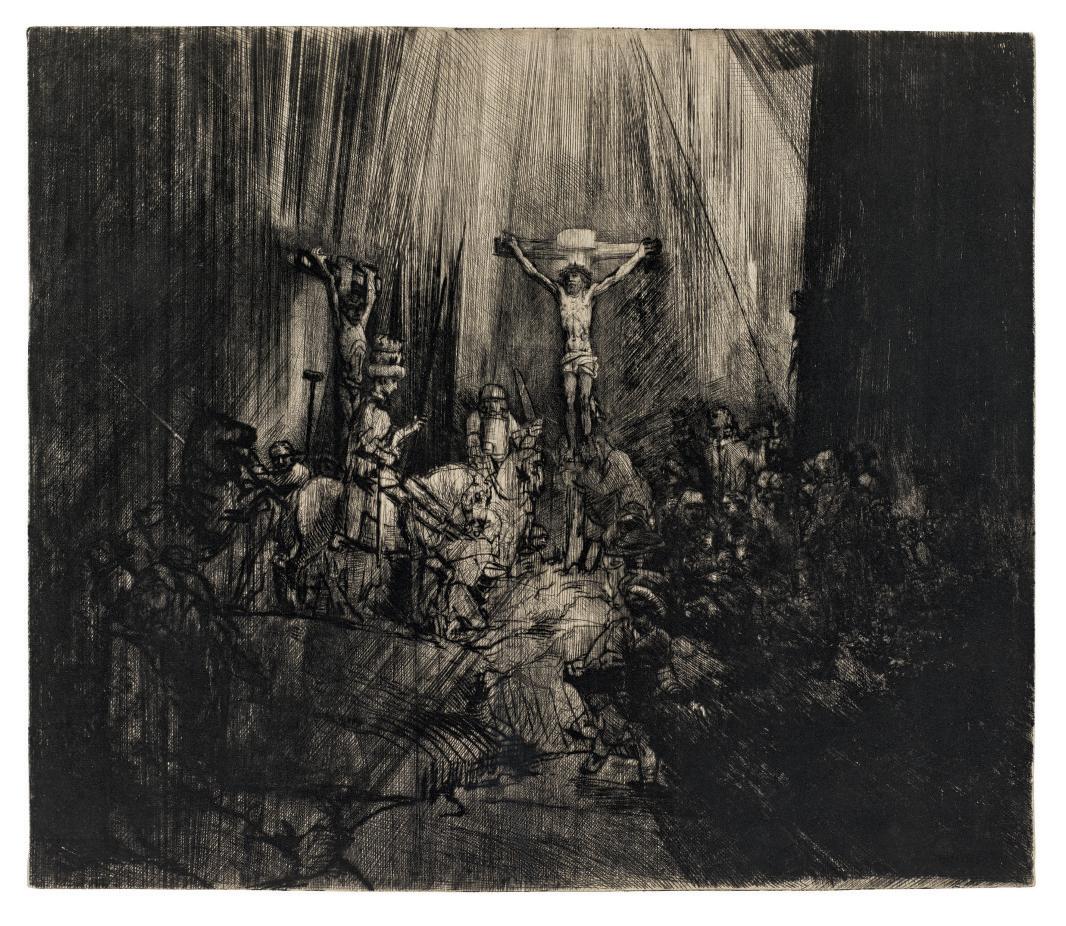
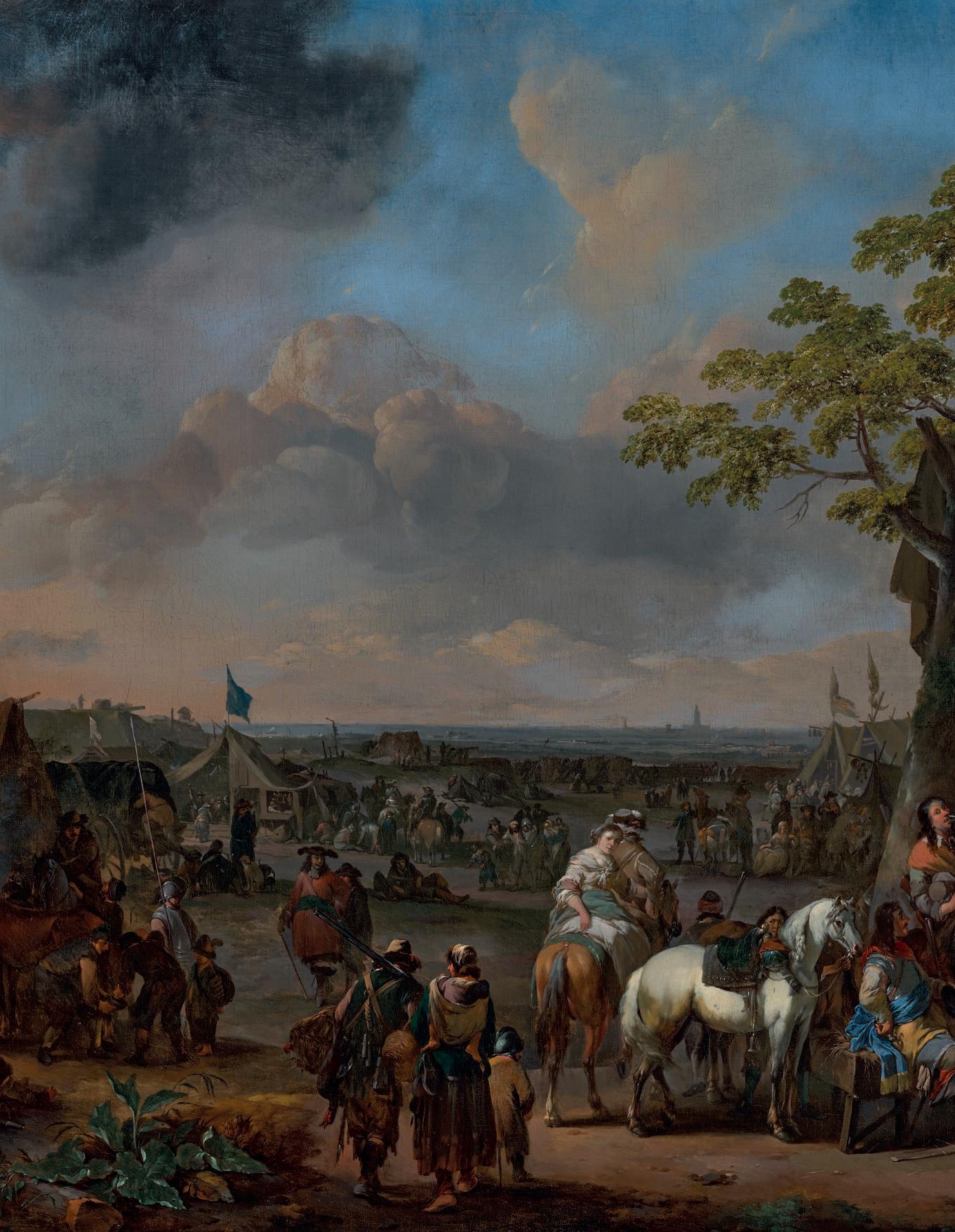
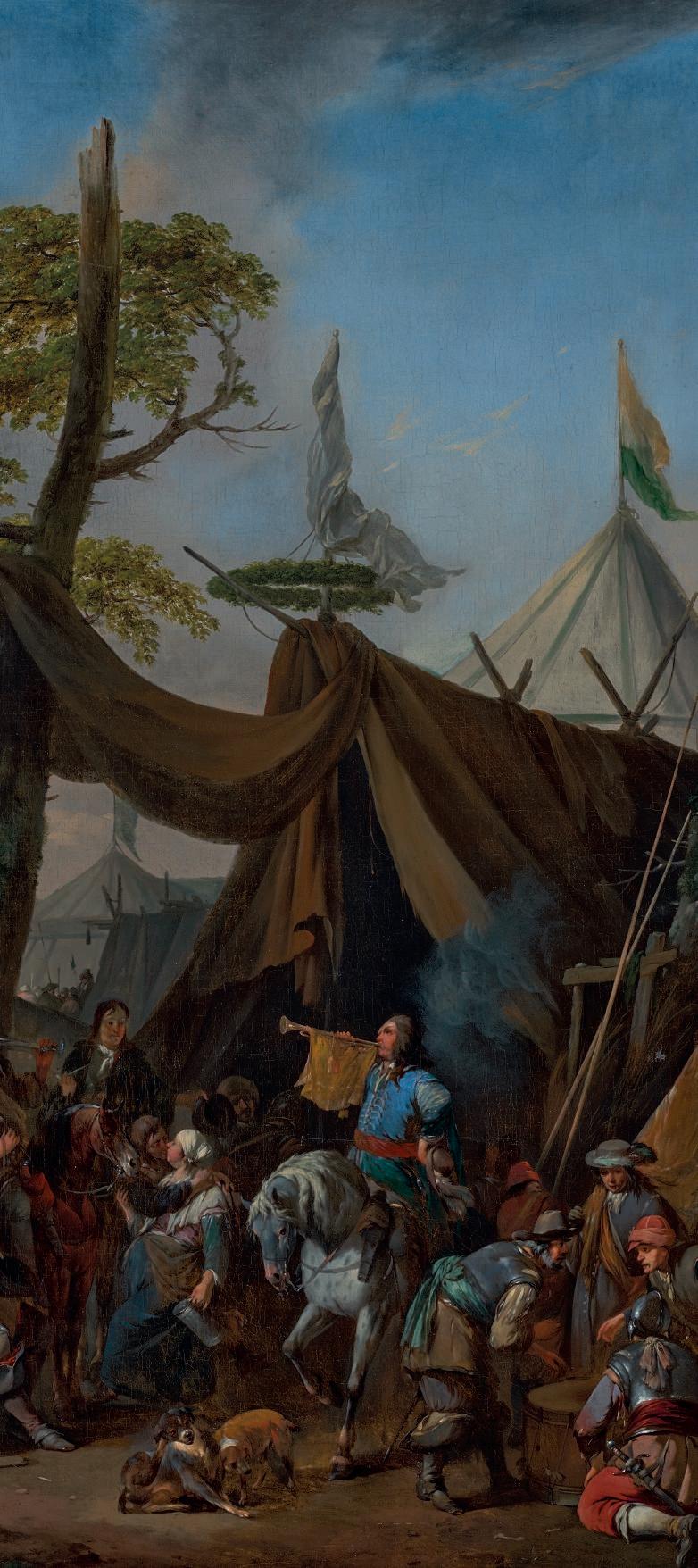
A Ancher, 26
B Brueghel, J., 3
Brueghel, P., 4
C van de Cappelle, 14 Courbet, 24
D van Dyck, 7
G Giambologna, 11
H Hayez, 25 Honthorst, 17
L Lawrence, 21
Lingelbach, 20 Liss, 19 Lorenzetti, 12
M Marieschi, 23 Martinelli, 5
Master of Monte Oliveto, 10 Metsu, 13 de Momper, 3
N van der Neer, 6
O van Ostade, 18
P Peeters, 9
Q Quellinus, 2
R Rubens, 8
S Siberechts, 16 Susini, 11
T Tiepolo, 22
V Veneziano, 1
W Wautier, 15
van der Werff, 6
